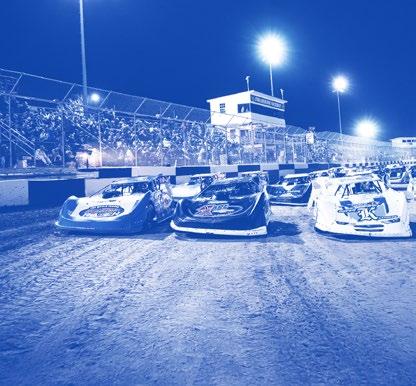






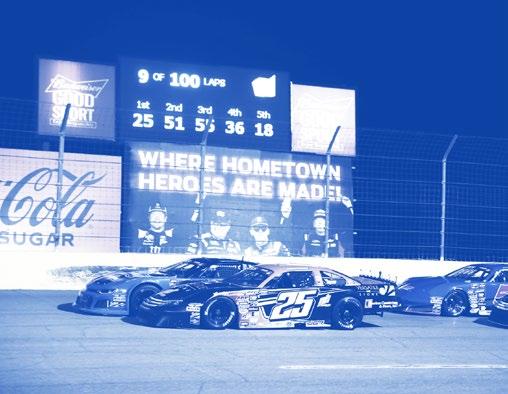

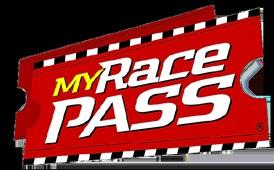
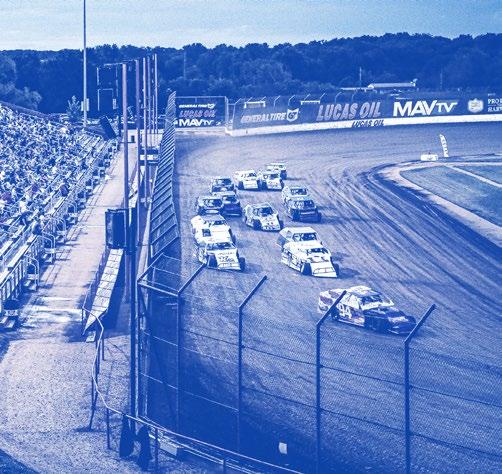
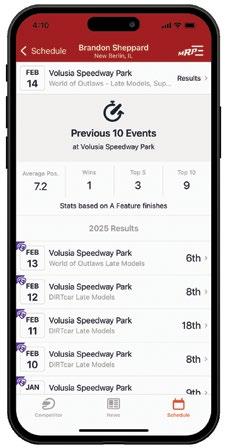
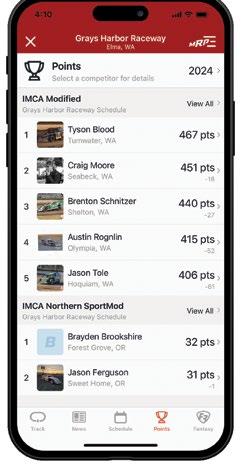
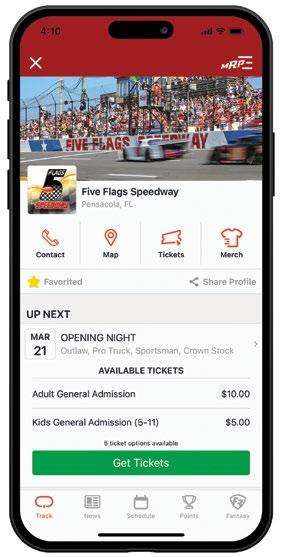
Be the first to know where your favorite driver is starting in their next race.
Be the first to know where your favorite driver is starting in their next race.
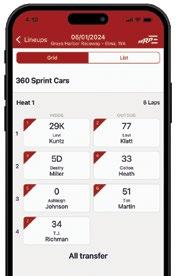
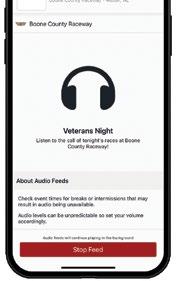
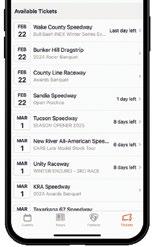

Skip the line and go straight to the gate with event tickets delivered straight to your phone.
Skip the line and go straight to the gate with event tickets delivered straight to your phone.
Claim top bragging rights over your friends by beating them at Fantasy Racing at your favorite events.
Claim top bragging rights over your friends by beating them at Fantasy Racing at your favorite events. MRP
Can’t hear the announcer? No problem. With MRP Audio the announcer feed comes straight to your phone’s bluetooth device.
Can’t hear the announcer? No problem. With MRP Audio the announcer feed comes straight to your phone’s bluetooth device.
Who’s
Who’s
Who’s fastest? Who’s on the move? How many laps remain? Have it all in the palm of your hand.
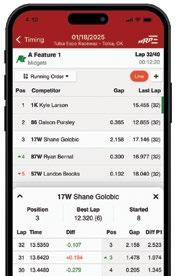
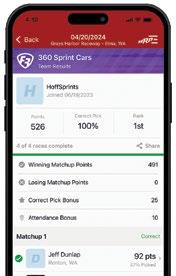
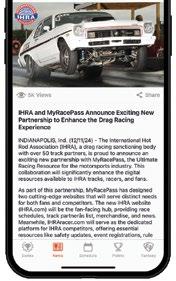
Be on the cutting edge of the latest driver, series, and industry news.





GLASS REMOVAL SEAM SEALERS MOLDINGS
Release all types of adhesives bonded to the metal without the collateral damage of open flame with the Inductor Max Kit. The kit is completely portable with the induction inverter mounted in a carry case.




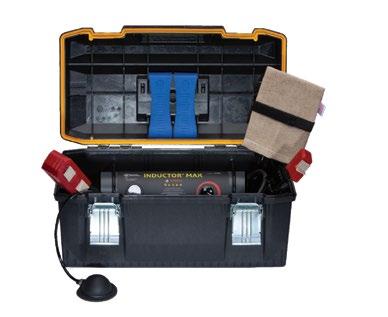

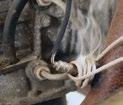
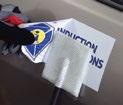
LUGNUTS O2 SENSORS GRAPHICS
Experience fast, safe & damage-free removal of seized nuts, bolts, bearings, fasteners, sensors, exterior trim, vinyl graphics, & more with the Mini-Ductor Venom® HP!
Available through your local tool distributor. These tools are manufactured in the USA with genuine OEM parts.







o the owners, promoters and teams who keep America’s short tracks alive and thriving – this magazine is for you. Your dedication to grassroots racing is what fuels this sport from the ground up. 50 States of Short Tracks was created to recognize your commitment, showcase your history and spotlight the unforgettable moments that happen under your lights.
This magazine is more than a collection of stories – it’s a tribute to the places that keep racing accessible, exciting and deeply connected to its community. Each featured track represents the hard work, long hours and relentless passion it takes to build something lasting – not just for drivers and teams, but for the fans who return week after week.
A special thank you to our partners at MyRacePass.com for helping us bring this vision to life and for the invaluable role they play in supporting the short-track racing ecosystem. We hope this publication inspires fans to explore new tracks, plan their next race-night adventure and add a few more stops to their short-track bucket list – starting with the tracks found in these pages.

50 STATES OF SHORT TRACKS
AN A.E. ENGINE
MOTORSPORTS PUBLICATION
23110 STATE ROAD 54, SUITE 293 LUTZ, FL 33549
EMAIL: INFO@AE-ENGINE.COM
WEB: AE-ENGINE.COM, DAILYDOWNFORCE.COM
THE CREW
PUBLISHER: CRAIG BARONCELLI COMMERCIAL
VICE PRESIDENT: DAVID WATSON DIRECTORS: MATT SMITH, SAM MILLER, ROWLAND GEORGE, ARNOUT KOK CONTENT
CREATIVE DIRECTOR: JOE RABUCK
DIGITAL MEDIA DIRECTOR: NICOLE COOPER
DIGITAL CONTENT DIRECTOR: JOSH MULL
EXECUTIVE EDITOR: ERIC ESTEPP COPY EDITOR: KEITH WALTZ EDITORIAL: JARED TURNER, KAUY OSTLIEN, ALLEN WALKER, ARMANY DEPAUL, CODY WILLIAMS, RUSS EDDINS, BRYAN AGUIAR SOCIAL MEDIA: RYAN LEAHY STAFF ASSISTANTS: AIDAN ANDERSEN, ETHAN ANDERSEN, SHOGUN, CATHY GUPTA
A.E. ENGINE SPECIFIES THAT POST-PRESS CHANGES MAY OCCUR TO ANY INFORMATION PRESENTED IN THIS PUBLICATION AND TAKES NO RESPONSIBILITY FOR GOODS OR SERVICES ADVERTISED.
MAIL ORDER: TO GET A COPY OF THIS MAGAZINE, SEND A CHECK OR MONEY ORDER FOR $20 TO: A.E. ENGINE, 23110 STATE ROAD 54, SUITE 293, LUTZ, FL 33549. PLEASE INCLUDE YOUR RETURN MAILING ADDRESS AND AN EMAIL ADDRESS, AND MAKE THE CHECK PAYABLE TO A.E. ENGINE.
ONLINE ORDER: SUBSCRIPTIONS AND INDIVIDUAL COPIES CAN BE ORDERED ONLINE AT DAILYDOWNFORCE.COM/SHOP.
SALES INQUIRIES: IF YOU ARE INTERESTED IN ADVERTISING OR WOULD LIKE TO BECOME A FIELD REPRESENTATIVE, PLEASE CONTACT DAVID WATSON AT DKW@AE-ENGINE.COM.







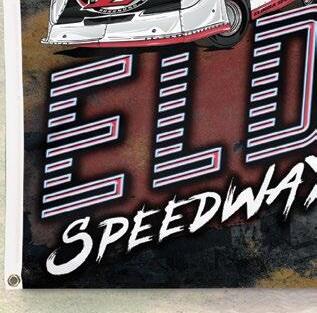




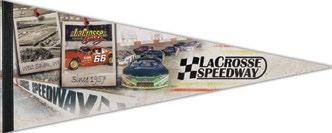

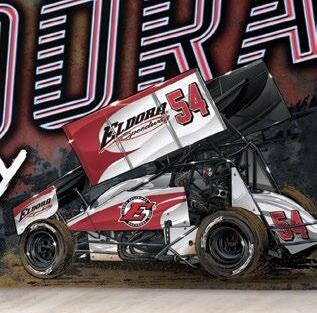



































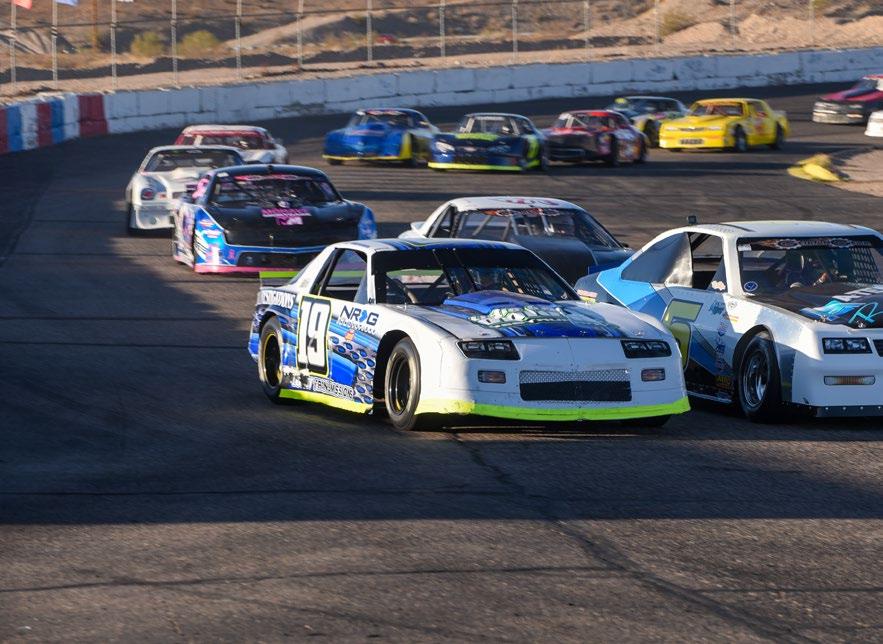

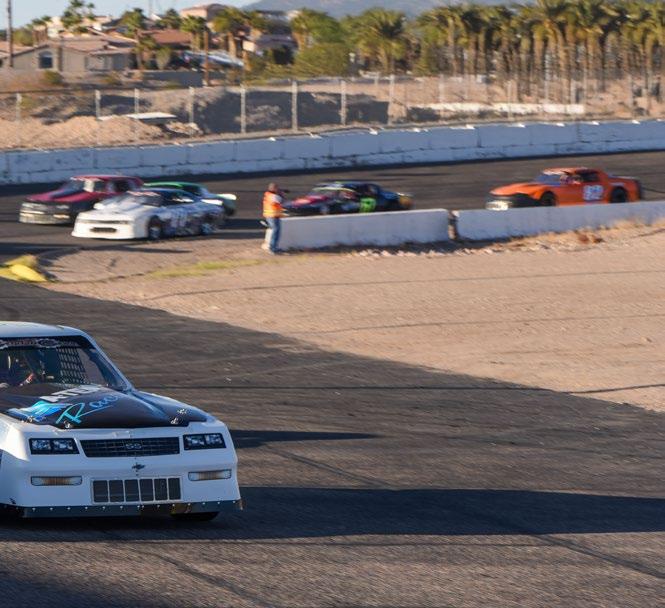
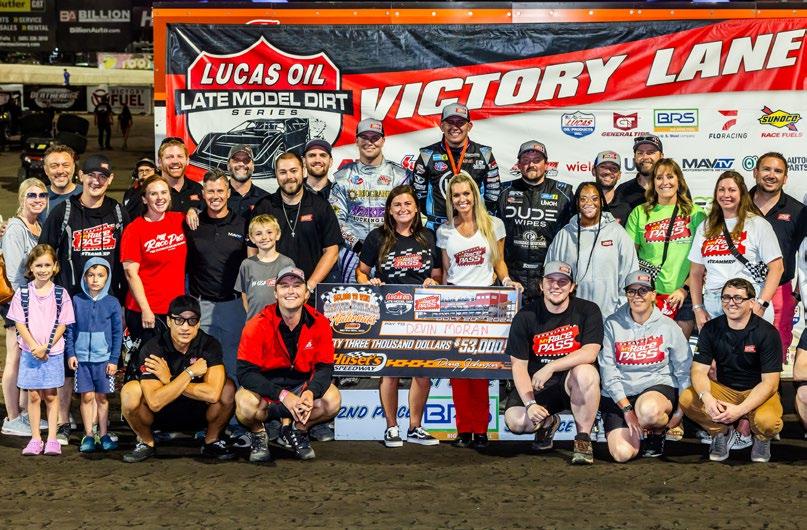
Short-track racing is evolving, and MyRacePass is leading the charge.
BY KAUY OSTLIEN


By uniting promoters, drivers and fans through cutting-edge technology, MyRacePass is redefining how the grassroots racing community connects, competes and grows. From live updates to streamlined race management, it’s the modern engine powering local tracks into the future.
As racing technology has continued to evolve, there was a risk that local and familyowned short tracks could be left behind. However, for nearly two decades, the team at MyRacePass has worked to bring both the local and national short-track racing scenes into the future – seamlessly integrating technology with motorsports.
The first edition of MyRacePass launched online in 2008. The company’s momentum truly surged about a decade later with the debut of the MyRacePass app at the 2018 Lucas Oil Chili Bowl Nationals.
The app couldn’t have launched at a better venue. The event at the Tulsa Expo Center is widely regarded as a pseudo-family reunion for promoters, drivers and race fans alike. With the racing community’s attention locked in, users were introduced to an all-in-one platform that showcased everything the MyRacePass team had built toward.
While certain services – like timing and scoring systems – may cater mainly to track owners and promoters, and ticketing apps serve fans, MyRacePass builds a true ecosystem. Whether on the web or in the app, it fosters a seamless connection among tracks, drivers and fans.

Skip the line and go directly to the gate with event tickets delivered straight to your phone.
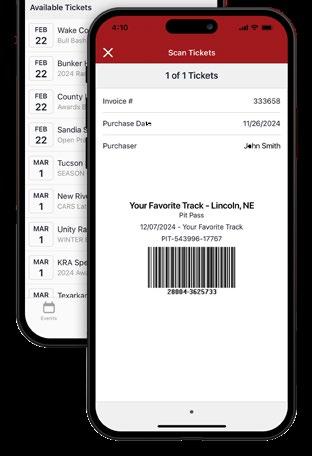
The impact of MyRacePass begins at the foundation of the short-track racing ecosystem: the promoters. These individuals – sometimes a full board of directors, other times a single person managing all aspects of race weekend – are the heartbeat of the sport.
For these promoters, MyRacePass set out to increase visibility and reach.
As MyRacePass co-founder Josh Holt said, “Our main focus on MyRacePass was to help the weekly race track. To help the grassroots promoter. These race tracks work on a very thin line of profitability. How can we help them generate more revenue? How can we help them generate more eyeballs?”
While MyRacePass provides numerous tools, its Race Management System stands out. This powerful feature gives promoters an edge during race week by handling registration, waivers, lineups, standings and driver communication. As races unfold, the system automatically updates results, standings and schedules online in real time.
This capability transforms the track promoter into a kind of marketing manager, delivering the essential information fans want – right in the palm of their hand. Live scoring, at-the-track audio and other real-time features enhance the experience.
For promoters unfamiliar with the platform, MyRacePass offers ongoing support. While partnerships with major racing series have helped elevate the platform, it’s the local tracks and promoters who have made MyRacePass a leader in race tech.
Promoters aren’t the only ones benefiting – racers have plenty of reasons to love MyRacePass, too.
On race day, the app becomes an essential tool for drivers. If a driver is working on their car while waiting for their heat race, they can keep tabs on live scoring, track how close the current race is to finishing and know exactly where they need to line up when it’s time to race.
Outside the track, driver profiles offer even more value throughout the
season. Any participating driver can claim their profile, which automatically updates with schedules and results – creating a living archive of their performance. This serves as both a personal record and a fan hub.
Beyond stats, MyRacePass also provides a way for drivers to grow their brand. Through its Dropship Apparel platform, MyRacePass handles the creation, design and printing of driver merchandise. This allows nearly any driver – from seasoned local veterans to rising stars – to sell custom gear, deepening fan engagement and creating new revenue streams.
MyRacePass delivers fans an unmatched experience.
Need to check your local track’s schedule? It’s there. Missed a race weekend? Check the results or live scoring. Curious about what’s happening at a track across the country? Open the app and take a look.
For fans, the MyRacePass app truly puts the sport in their hands. It even solves longstanding problems – whether it’s tracking lineups and running orders or listening to race audio.
Have you ever been at a Saturday night race and couldn’t hear the track announcer? MyRacePass solved that with MRP Audio, which allows promoters to stream announcer audio directly into the app. Fans and drivers can now tune in from the stands or infield with minimal delay.
MyRacePass serves as the all-in-one bridge among fans, drivers and track promoters – bringing these vital pieces of short-track racing together. The team continues to build, refine and innovate – not just keeping pace with the industry, but helping lead it forward.
Who’s fastest?
Who’s on the move? How many laps remain? Have it all in the palm of your hand.
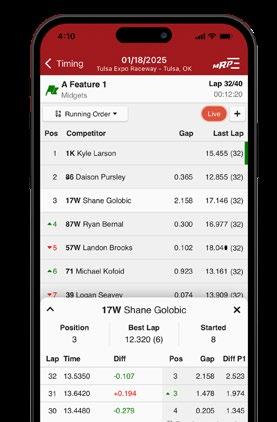
BY KAUY OSTLIEN
The digital age has proven to be the perfect fit for short tracks across the country. With the rise of podcasting and vlogging, racers, experts and fans have taken their passion to a new level. These creators don’t just help drivers promote themselves – they also bring short-track racing to screens nationwide.


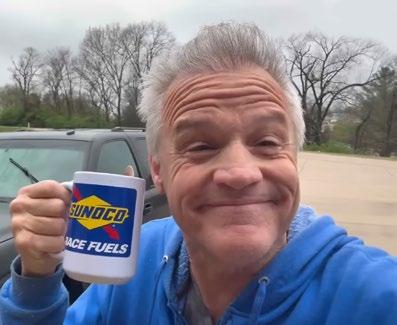


Wallace has a long history in NASCAR, but he’s also one of the most visible content creators in grassroots racing today.
Wallace grew up around short tracks. His father, Russ Wallace, was a well-known short-track racer and the three Wallace brothers – Rusty, Mike and Kenny – found success on the short tracks of the Midwest before enjoying careers at NASCAR’s highest level.
As his NASCAR driving career wound down, Kenny Wallace leaned into media and dirt racing. During the COVID-19 shutdown, he began filming daily videos from home, which turned into his YouTube series, Coffee With Kenny.“I grabbed my phone one day and just started,” Wallace recalled.
Encouraged by a friend, he took his content to YouTube. Wallace initially resisted. “I didn’t want to do YouTube. I wanted to go dirt racing,” he said.
Eventually, he embraced it and began uploading daily. His channel now has more than 125,000 subscribers and 44 million views.
Wallace expanded into other shows, including The Kenny Wallace Show, Kenny Conversation and a podcast with Ken Schrader called Herm & Schrader.
He uses his platform to spotlight both grassroots racers and the big-name drivers.
“I said, ‘OK, we proved ourselves.’ Now let’s start interviewing drag racers like John Force ... let’s interview dirt racers like Bobby Pearce and Jonathan Davenport,” Wallace said.
Wallace, who has 904 starts across NASCAR’s three national, is chasing a different type of victory.
“Me, Dale Jr., all of us together, we are on purpose trying to pay it forward, shed light on local and traveling touring series,” he said.
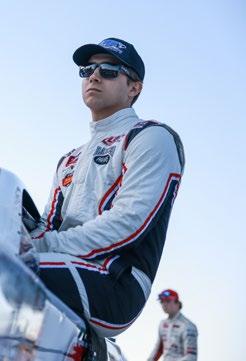
Barnes Jr. has been racing a pavement Late Model and recently joined the CARS Tour with Lee Pulliam Performance. But many fans first discovered him through his YouTube channel, AirDoug.
He started the channel in 2019 after a friend began filming his races. Coverage of short-track racing was limited, and Barnes wanted to give fans something more.
“Back in the day, outside a race monitor or an article, you didn’t know what happened after Saturday Night unless you were there,” Barnes said.
Then came a viral moment. After a heated race with Tyler Hughes, Barnes climbed out and charged Hughes’ car.
“I just got out and cannonballed on his windshield,” he recalled. That moment led to his AirDoug nickname – and a boost in followers.
“Me and Tyler are good now ... it’s funny to look back on,” Barnes said. His channel now has more than 62,000 subscribers. This season, Barnes is running the full CARS Tour schedule and continues to create content around his race weekends. After a recent spin into the “watermelon patch” at Cordele Motor Speedway, he posted a video breaking it all down just days later.
“It’s rewarding hearing people’s feedback and saying that they like it,” he said. “So I’m proud of it. It means a lot.”
To Sprint Car Racing fans, Chase Raudman is known for his work as a broadcaster for High Limit Racing and his previous work in the World of Outlaws Sprint Car Series. However, Raudman is also gaining attention for his YouTube channel, The Raudman Rundown.
Raudman grew up in the sport.
“I grew up in mostly short-track pavement racing. My dad was kind of a big deal in that type of racing back in the day,” Raudman explained.
The younger Raudman raced against top talent, including a young Kyle Larson, but eventually went in a different direction.
and decided to fill it with a format that was both simple and effective: a whiteboard and a marker.
“I feel like people were craving more Sprint Car content throughout the week,” Raudman noted.
His whiteboard videos give fans a deeper look at the sport than what they’d find on a live broadcast.

“I raced a little bit, (but) realized I wasn’t very good, and so I decided to start announcing races,” he said.
Raudman noticed a gap in Sprint Car content
“On the broadcast, I can’t just go on a tangent about this and that,” he noted.
“They don’t give me 20 minutes to talk about a certain track or a certain guy or a certain race or whatever, right? So, the YouTube thing was perfect.”
His channel has over 5,400 subscribers and more than 680,000 total views.
“I didn’t start this to become a millionaire. I started this to try and help grow the sport ... in my opinion, I think that the type of racing that I cover, hands down, is the most exciting form of racing in the world,” Raudman concluded.
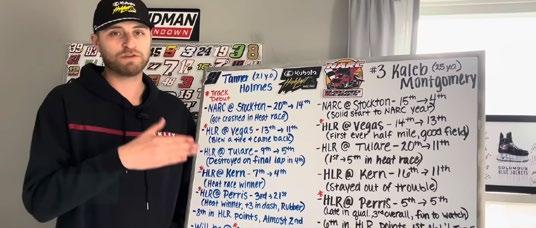
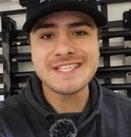

HOLMES IS A DIRT-TRACK racer and content creator based in Jacksonville, Oregon. Since 2016, he’s been posting videos that document his racing career – from race prep to behindthe-scenes travel and life on the road.
Holmes found inspiration from another unlikely source.
“I remember watching a guy that was a professional scooter rider. ... So a light bulb went off in my head that was like, ‘Well, I’m a dirt racer ... maybe people will enjoy that,’” Holmes said. His content shows the realities of chasing a dirt-racing career.
“I think a lot of people see the (Kyle) Larsons and Corey Days ... but for a lot of us, the journey looks a little different,” Holmes explained.
Holmes now races for Tarlton Motorsports in the High Limit Series. His YouTube channel has more than 80,000 subscribers and over 25 million views.
He edits his own videos between races.
“It’s a lot of extra work, but ... I love it, and I think it’s also helped me get to where I’m at,” Holmes said. “By no means is my channel massive, but ... it’s been great and a chance to reach out to new people and keep people excited about the sport.”
BY KAUY OSTLIEN
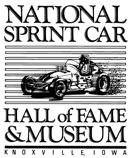
To plan your trip or to learn more about the National Sprint Car Hall of Fame & Museum, visit sprintcarhof.com.
While Sprint Car racing has grown into a nationally recognized spectacle with big paydays and high-profile events, its roots run back to local dirt tracks and the days when bluecollar-workers bought tickets to watch a brave group of men dance with danger during every lap.
Today, the National Sprint Car Hall of Fame and Museum in Knoxville, Iowa, offers fans a one-of-akind opportunity to connect with that rich history, and the legends who built that segment of the sport.
Knoxville, Iowa, is known as the “The Sprint Car Capital of the World” and the National Sprint Car Hall of Fame and Museum overlooks Turn 2 of historic Knoxville Raceway, home of Sprint Car racing’s most the prestigious event, the Knoxville Nationals.
The four-story museum officially opened in 1992 thanks to the dedication of passionate advocates like Tom Schmeh. It remains the only museum in the world solely dedicated to preserving and celebrating Sprint Car racing.
Several cities were considered for the museum’s home, but Knoxville’s central role in the sport earned it the honor. Since its founding, the facility has grown alongside the speedway itself. It now features beautifully staged race car displays and two impressive suite towers: the Bryan Clauson Suite Tower and the Dennis Albaugh Suite Tower.
The museum does more than showcase cars, however – it protects and promotes the stories, craftsmanship and media that made Sprint Cars the nation’s premier division for dirt-track racing.
Inside the museum roughly 35 open-wheel race cars are on display at any given time, each rotated on loan from private owners about every six months to a year. That frequent turnover ensures there’s always something new to see.
One signature exhibit is the John Gerber Garage,
a meticulously recreated version of the 1930s-era race shop belonging to open-wheel pioneer John Gerber. Featuring his hand-built car and original tools – donated by his wife after his passing – it offers a tactile glimpse into racing’s early days.
Nearby, a modern 410 Sprint Car engine is on display, showing how far technology has progressed.
On the museum’s second floor, the National Sprint Car Hall of Fame honors not only legendary drivers such as Steve Kinser, Sammy Swindell, Doug Wolfgang and Rick Ferkel, but also Sprint Car racing’s unsung heroes – the writers, photographers, officials, promoters, engine builders and mechanics who helped shape the sport from the ground up.
Just two blocks away, an 11,000-square-foot archive facility houses the world’s largest collection of printed Sprint Car racing material. This offsite building safeguards historic publications and artifacts, preserving decades of achievement and storytelling.
For any Sprint Car enthusiast, the National Sprint Car Hall of Fame and Museum is a must-see destination. From fire suits and helmets, to race-used cars and rare memorabilia, the museum tells the story of Sprint Car racing’s evolution and enduring culture.
The onsite gift shop features the world’s largest selection of Sprint Car merchandise, including T-shirts, books, die-cast cars and collectibles – perfect souvenirs for fans of all ages.
To make the most of the experience, visitors are encouraged to plan their trip around race weekends at Knoxville Raceway. Spend the afternoon exploring the museum, then walk just steps away to take in everything that comprises a race night at one of America’s legendary dirt tracks.
The museum is open seven days a week, closing only on major holidays: Christmas, Easter, Thanksgiving and New Year’s Day.
Whether you’re a regular at East Coast bullrings like Bridgeport Motorsports Park in New Jersey or at West Coast favorites such as Skagit Speedway in Washington, the National Sprint Car Hall of Fame and Museum stands as a meeting ground for Sprint Car culture nationwide.
In Knoxville, Iowa – the heart of open-wheel dirt racing – the museum bridges the past and present, uniting fans, racers and stories from every corner of the country.
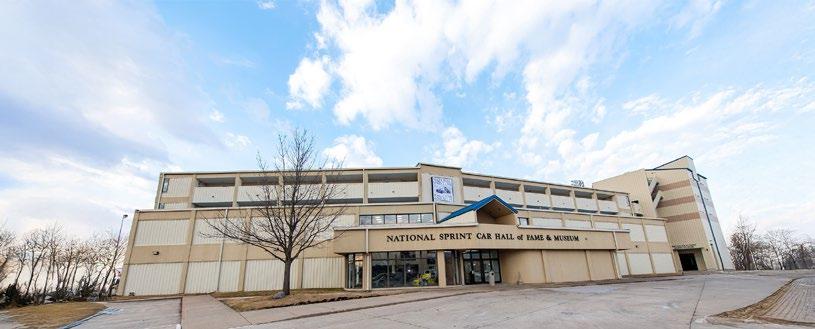
















































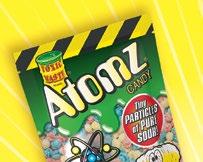

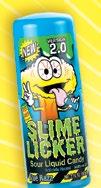
















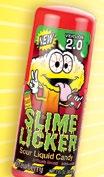

























































































































































































































































































































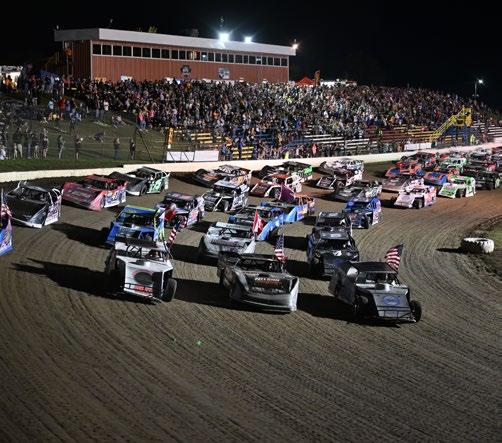

The WISSOTA Promoters Association was founded in 1981 by eight track promoters from Wisconsin and Minnesota. Their goal was to establish uniform rules for the Late Model division – standards that would benefit both promoters and drivers. As the Modified division gained popularity, the group extended its mission to include consistent rules for that class as well.
By 1984, a voluntary steering committee had been formed to oversee the business side of the growing organization and help guide the future of WISSOTA’s racing divisions. That committee eventually evolved into a full board of directors. In 1986, WISSOTA officially became a nonprofit racing organization.
Promoters who join WISSOTA essentially become part-owners of the organization and are expected to contribute to its ongoing success. Each November, the association holds its annual meeting, where member promoters gather to discuss the organization’s future. They vote on policies, procedures, and rules for competition across WISSOTA’s various divisions.
Over nearly four decades, member promoters and racing associations have collaboratively developed unique rules for the following divisions – WISSOTA Late Models, WISSOTA Modifieds, WISSOTA Midwest Modifieds, WISSOTA Super Stocks, WISSOTA Street Stocks, WISSOTA
Mod Fours, WISSOTA Pure Stocks and WISSOTA Hornets.
All decisions are made democratically with every promoter or racing association representative given a chance to share their opinions and vote on each matter.
Each year, several individuals from within the racing community are elected or re-elected to serve on the WISSOTA Board of Directors during the annual meeting. The current board is composed of seven elected officials, each responsible for representing the overall membership and managing, along with a number of employees, the organization’s day-to-day business.
Today, WISSOTA’s membership includes approximately 50 race tracks across Wisconsin, Minnesota, North Dakota, South Dakota, Montana, Wyoming, Ontario and Manitoba. These tracks host weekly racing programs featuring one or more WISSOTA divisions, as well as the region’s most respected and highest-paying special events.
Nationally, the “WISSOTA region” is recognized by industry leaders as one of the most healthy and stable short-track racing regions in the country. As a nonprofit, all of WISSOTA’s income – after operating expenses – is paid to drivers at the end of each season through track and national point funds.
The crown jewel of the WISSOTA calendar is the WISSOTA 100, the organization’s premier event. It has earned repeated honors from Speed Sport as an Outstanding Annual Short-Track Racing Event.
Last year alone, more than 2,400 drivers were licensed to compete across WISSOTA’s eight sanctioned divisions at its nearly 50 member tracks.
While WISSOTA remains primarily based in the Upper Midwest, the organization is open to national expansion if the right opportunities arise. Any track interested in becoming a WISSOTA member or sanctioning a division or event can contact the WISSOTA Office at (320) 251-1360 or visit WISSOTA.org for more information.

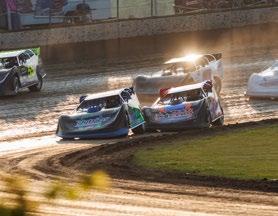

BY CODY WILLIAMS
At short tracks across America, the food scene is as fierce and flavorful as the racing itself. From beer-simmered sausages to legendary local lagers, concession stands offer more than just quick bites – they serve up beloved traditions. Here’s a taste of the must-try trackside favorites fueling fans across the country.

Simmered in beer then grilled
Jamestown Speedway, North Dakota
At Jamestown Speedway, one concession stand favorite stands above the rest – gizzards. These deep-fried chicken bites are marinated in buttermilk, coated in a flavorful seasoning blend and fried to crispy, golden perfection. Served hot with a side of fries, they pair perfectly with dipping sauces like ketchup, honey mustard or barbecue.
A true trackside delicacy, they keep race fans coming back year after year.

Willamette Speedway’s Beer Dogs feature German sausages simmered in beer and grilled to perfection. Build it your way with classic condiments and enjoy a fan-favorite experience.
FLAVOR BOOST
Best with honey mustard
PERFECT PAIRING Hot fries
TRACK TRADITION
Longtime fan favorite
Ransomville Speedway, New York
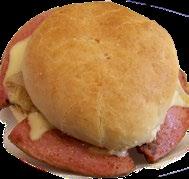
MUST-TRY COMBO
Flatdog + Fresh-Cut Fries UPGRADE
Smother with nacho cheese LEGACY
More than 30 years on the menu
The flatdog is a fan favorite at New York’s Ransomville Speedway. The star of the show is a thick-cut piece of bologna, fried to perfection and topped with gooey American cheese, sautéed peppers and onions. It’s all held together by a fresh, fluffy brioche bun.
A staple at the track for more than 30 years, the flatdog is often ordered with a side of freshly cut French fries. For an extra indulgence, fans can upgrade by smothering the bologna in nacho cheese sauce.
Ransomville locals simply can’t get enough!

Gizzards aren’t the only specialty at the historic Jamestown Speedway – the Chicken O’s are also a must-try. These breaded chicken patties are deep-fried to a crispy, golden brown and crafted with a hollowed-out center to resemble a tire. Order them by themselves or on a bun with your choice of toppings. Add fresh-cut fries and a drink for the full combo experience.
FUN SHAPE
Hollow center like a racing tire
HOW TO ORDER
Solo or as a sandwich
PRO TIP
Add toppings to customize

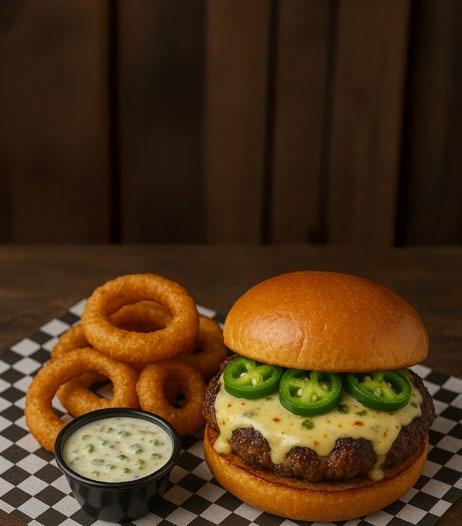
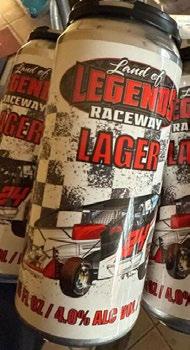
BIG O Speedway, Texas
BIG O Speedway in Ennis, Texas, turns up the heat with the Turbo Inferno Cheeseburger. It starts with a 100 percent Angus beef patty grilled to perfection, topped with gooey pepper jack cheese and fiery jalapeño slices, all served on a golden toasted bun.
Pair it with the track’s signature Burnout Onion Rings – beer-battered and crispy, served with zesty jalapeño ranch sauce – for the ultimate trackside meal.
BURGER HEAT
Jalapeños + Pepper
Jack Cheese
SIGNATURE SIDE
Beer-battered onion rings
DIP ALERT
Jalapeño ranch sauce
Land of Legends Raceway, New York
BREWERY PARTNER
DisBatch Brewery
THIS YEAR’S SPECIAL “800 Horsepower” lager
FUN FACT
New flavor crafted annually


No great food lineup is complete without a refreshing beverage. Land of Legends Raceway takes it a step further with their annual self-titled lager, brewed exclusively for the track by DisBatch Brewery.
The formula changes each year, so there’s always something fresh to try. This year’s brew, “800 Horsepower,” is packaged in limitededition cans featuring drivers Peter Britten, Matt Sheppard and Mat Williamson. Sold in 16-ounce cans with 4 percent ABV, it’s a fan-favorite in the stands.
DisBatch Brewery has proudly been a track sponsor for several years.

Whether you’re racing dirt, asphalt or anything in between, your pit space says a lot about your program.
MatMan Designs – the No. 1 Source for Race Team Matting – helps race teams look sharp, stay clean and impress sponsors with custom matting and professional design solutions built specifically for the motorsports world.
MatMan Designs provides a complete lineup of custom-designed products for race teams, including:
• Logo Design
• Indoor and Outdoor Mats
• Toolbox Mats
• Race Car Deck Mats
• Banners
• T-Shirt Design
• Race Wraps
Every MatMan product is Made in the USA using only premium materials.
Our logo mats are constructed with high-quality Nylon 6/6 fiber for vivid color, durability and long-lasting performance.
Our scraper mats feature flexible, heavy-duty Nitrile Rubber that’s built to withstand the grit and grind of any pit area.


Clean Workspaces: In racing, even the smallest particles can damage shocks or carburetors. Our mats help keep your trailer and work area clean – minimizing dirt, dust and debris. They’re easy to clean with a small portable vacuum.
Professional Presentation: Custom mats featuring your sponsors’ logos enhance the professionalism of your pit area. They demonstrate to current and potential partners that you take pride in your program and are committed to presenting it at the highest level.
MatMan Designs is led by Chad Harrington, known as “The MatMan,” who brings over 22 years of experience in matting and more than five decades of involvement in the racing world. From design to production, Chad personally oversees each order to ensure unmatched quality and service.
At MatMan Designs, we don’t just make mats – we help race teams build cleaner, more professional and sponsor-ready pit environments. All Made in the USA.

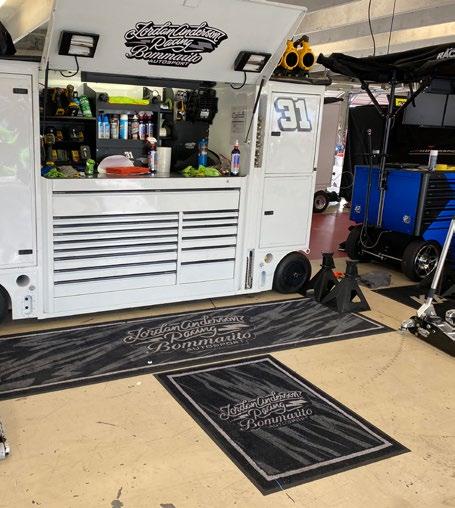
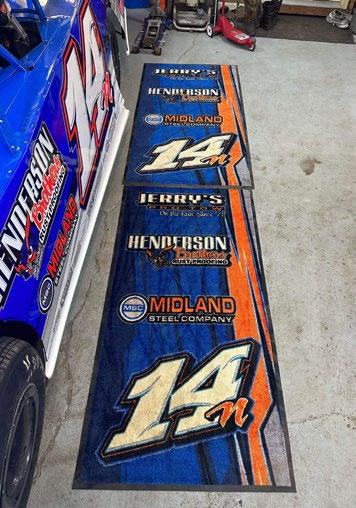
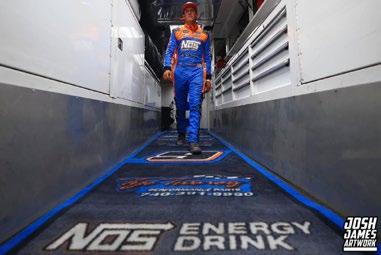
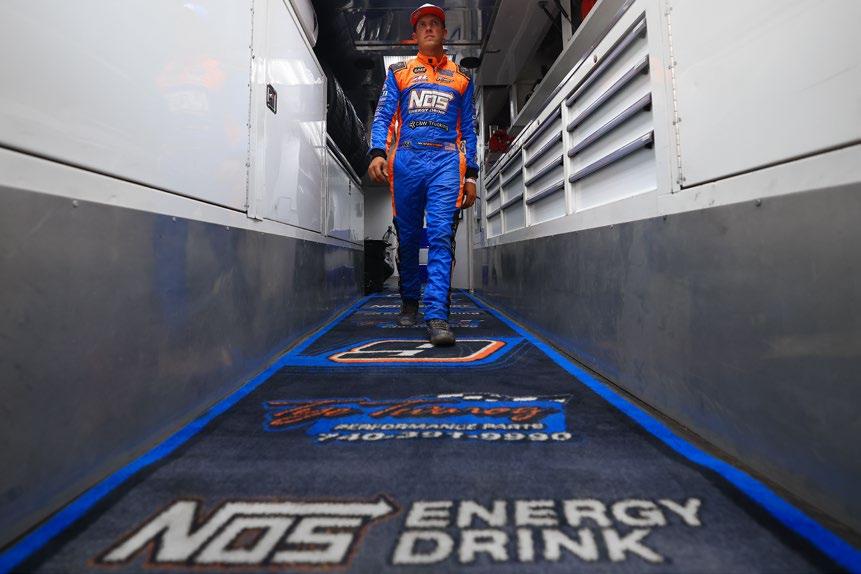
BY BRYAN AGUIAR
The stars of today’s three NASCAR national series all rose from rather humble beginnings and found success at a race track close to home. As part of 50 States of Short Tracks, here’s a look at the venues where these 14 racers first made their mark.
Hemric is the 2021 NASCAR Xfinity Series champion and driver of the No. 19 Chevrolet campaigned in the NASCAR Craftsman Truck Series by McAnallyHilgemann Racing.
He grew up racing at North Carolina’s Concord Speedway. Originally a fourtenths-mile dirt oval, the track was paved in 1986 and redesigned in 1991 into a unique half-mile tri-oval with a dog-legged backstretch.

It was best known for the Big 10 Series for Super Late Models and the North-South Shootout event. Despite its rich history, the facility closed in July 2019, marking the end of an era for this iconic short track.
Jones drives the No. 20 Joe Gibbs Racing Toyota in the NASCAR Xfinity Series. He grew up racing at Caffeine and Octane’s Lanier Raceway, a threeeighths-mile asphalt oval located near Braselton, Georgia.
Born with a dirt racing sufrace in 1982, the track was paved during the mid-1980s and hosted a variety of touring series, including the NASCAR Xfinity Series from 1988 to 1992. In 2022, the venue was acquired by High Octane Trackside, which produces the Caffeine and Octane car shows, and it has since become a hub for automotive enthusiasts, offering events like Friday Night Drift and karting experiences.


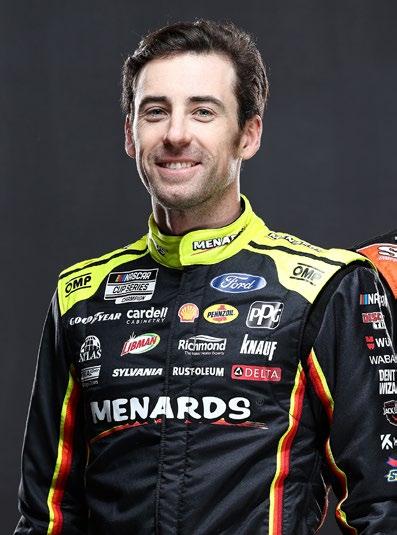
Blaney is the 2023 NASCAR Cup Series champion and drives the No. 12 Ford for Team Penske. His racing journey began in Quarter Midgets and his first competitive laps came in 2003 at Pocono Quarter Midget Raceway, which is located outside Turn 3 of Pocono Raceway in Long Pond, Pennsylvania.

In July 2023, Blaney served as the grand marshal for the NASCAR Youth Series’ Dirt Nationals race at the same one-fourteenth-mile track, showing his connection with the oval track that launched his career.
Third-generation racer Corey LaJoie is runnng a limited schedule of NASCAR Cup Series races this season in the No. 01 Ford fielded by Rick Ware Racing. He competed full time in the Cup Series from 2019 to 2024.
LaJoie’s early racing career included many nights of door-to-door racing at Hickory Motor Speedway, which is

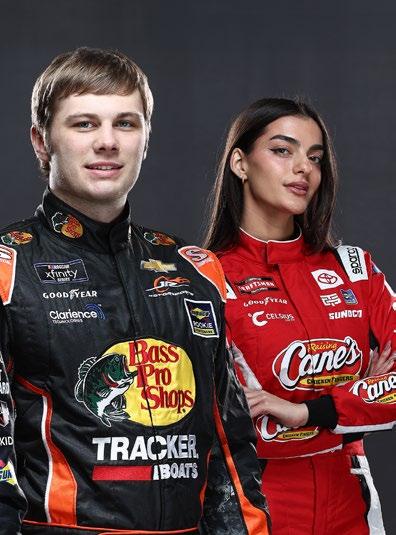
frequently referred to as the “World’s Most Famous Short Track.”
Located in Newton, North Carolina, the track opened in 1951 and has been instrumental in developing numerous NASCAR drivers. LaJoie’s participation in races at this venue paved the way for his progression through the NASCAR ranks.
Kvapil, the oldest son of 2003 NASCAR Craftsman Truck Series champion Travis Kvapil, competes full time in the NASCAR Xfinity Series, driving the No. 1 Chevrolet for JR Motorsports.
While working his way through the racing ranks, Kvapil ran with the Southeast Limited Late Model Series, securing victories at tracks like Dillon Motor Speedway.

Located in Dillon, South Carolina, this four-tenths-mile oval opened as a dirt track in the mid-60s under the name Dillon County Raceway. After muliple promoters were unable to successfully operate the track, former NASCAR driver Ron Barfield purchased and revitalized the facility. The track was paved and reopened as Dillon Motor Speedway in time for the 2007 season.
The track has since become a staple of the regional racing scene, contributing to the development of drivers like Kvapil.
Driver of the No. 20 Joe Gibbs Racing Toyota, Bell began his racing career at I-44 Riverside Speedway, a one-eighthmile dirt track located just outside of Oklahoma City. He earned the Lucas Oil ASCS2 championship in 2010 before winning the 66 Mike Phillips Memorial Micro-Sprint Car race in 2011.
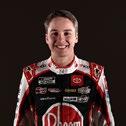
In 2013, an EF5 tornado struck the area, devastating the speedway. Bell, deeply connected to the track, assisted in its reconstruction – demonstrating a deep commitment to his racing roots.
The rebuilt I-44 Riverside Speedway has since hosted numerous marquee events, including a 2022 POWRi 600cc Outlaw Micro feature that Bell led from flag to flag.
Breidinger drives the No. 5 TRICON Garage Toyota in the NASCAR Craftsman Truck Series. She began racing go-karts at age 9 alongside her twin sister, Annie, at Califofornia’s Sonoma Raceway.
This early exposure ignited Breidinger’s passion for racing. She graduated from go-karts to Midgets, where she became the winningest female driver in USAC history. Breidinger won 19 USAC Midget features and earned the 2016 USAC Western U.S. Asphalt Midget Series championship befor advancing to the next step in her career.
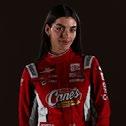
Sonoma Raceway, located in California’s NAPA Valley, is a renowned motorsports complex that features a 2.52-mile road course and a quarter-mile dragstrip. Opened in 1968, it has welcomed NASCAR, IndyCar and NHRA events.
Berry, driver of the No. 21 Ford for Wood Brothers Racing, began his career at Nashville Fairgrounds Speedway, earning Legend Car championships before transitioning to Late Model competition and joining JR Motorsports in 2010.
Last June, Berry returned to the historic fairgrounds track to race a Late Model in the Battle of Broadway 150. He finished fifth. Nashville Fairgrounds Speedway, established in 1904, is the second-oldest active U.S. race track. The 0.596-mile track hosted NASCAR Cup races from 1958 to 1984. Recent efforts to renovate the facility and bring major NASCAR racing back to the track have generated debate, with supporters emphasizing its legacy and economic impact while opponents raise urban development concerns.
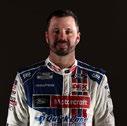
Preece began his racing career at legendary Stafford Motor Speedway in Stafford Springs, Connecticut.
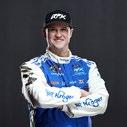
In 2011, Preece claimed the SK Modified Series championship at Stafford, coinciding with his future wife, Heather DesRochers, being named the series’ Rookie of the Year. Preece has scored multiple victories at Stafford, including nine NASCAR Whelen Modified Tour triumphs
This year, Preece joined Roush Fenway Keselowski Racing where he wheels the No. 60 Ford Mustang in the NASCAR Cup Series. Preece is scheduled to return to Stafford Motor Speedway to compete in the Monaco Modified Tri-Track Series event on July 16.
A two-time NASCAR Cup Series champion, Kyle Busch had won a record 232 NASCAR national series races as of April 8. And it all began at The Bullring, a three-eighths-mile short track that’s part of the Las Vegas Motor Speedway complex.

Busch notched 65 wins and captured two track championships at The Bullring between 1999 and 2001. That success led to his NASCAR Craftsman Truck Series debut at just 16 years old.
The Bullring, established in 1985, offers a path for drivers to hone their skills with hopes of eventually advancing to a NASCAR national series.
Busch’s connection to his hometown track is evident as he occasionally returns to The Bullring, not only to compete but also to support and inspire emerging young drivers.
NASCAR Cup Series champion and two-time Xfinity Series titlist Martin Truex Jr. began his racing career at New Jersey’s Wall Stadium. The second-generation driver graduated to the track’s premier Modified division when he was only 18 years old.
Located near the Jersey Shore, Wall Stadium is a one-third-mile paved oval with 30 degrees of banking in the turns. The track opened in the spring of 1950 and has operated for at least part of every year since.
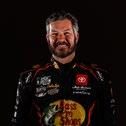
Zilisch is a top NASCAR prospect who currently drives the No. 88 Xfinity Se ries car for JR Motorsports. He began his racing journey in karting, transitioning to sports cars and, eventually, stock cars. His performances led to a contract with Trackhouse Racing. Notably, in his first NASCAR Xfinity Series start, Zilisch secured a dominant victory.

Trackhouse Motorplex, formerly GoPro Motorplex, is a premier outdoor karting facility located in Zilisch’s hometown of Mooresville, North Carolina. The seven-tenths-mile, 11-turn sprint karting track is modeled after Italy’s historic Kartdromo Parma Circuit, renowned for hosting multiple World and European Championships.
The Motorplex is home to some of the largest professional karting series races in the United States.
Chris Buescher, driver of the No.17 Ford for RFK Racing, began his driving career in 2005, wheeling Legend Cars on the various tracks that are part of the Texas Motor Speedway complex.
Buescher won more than 100 Legend Car races before claiming the 2012 ARCA Menards Series championship and the 2015 NASCAR Xfinity Series title. This is his 10th year as a full-time Cup Series driver and he has six series victories.
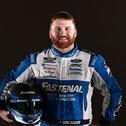
Texas Motor Speedway in Fort Worth is mainly known for its 1.5-mile quad-oval track that has hosted major racing events since 1997. Within its complex, the speedway also includes a one-fifth-mile paved oval and The Dirt Track, a four-tenths-mile clay oval whose major events include the season finale for the High Limit Sprint Car Series.
Larson, the 2021 NASCAR Cup Series champion and driver of the No. 5 Hendrick Motorsports Chevrolet, launched his racing career in 1999 at northern California’s Cycleland Speedway.
He scored more than 130 feature victories in the various divisions of Outlaw Kart racing before graduating to Sprint Car compeitition.

Wall Stadium is best known for hosting the annual Turkey Derby, a Thanksgiving weekend spectacular, and the Garden State Classic.

Established in 1963, Cycleland Speedway is a dirt track located near Chico, California. Initially focused on motorcycle racing, the speedway gained prominence under the stewardship of former motorcycle racer and owner-promoter Lowell Moural. In 1985, Moural transformed Cycleland into a one-eighth-mile oval and introduced Outlaw Kart racing to the venue.
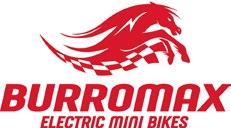
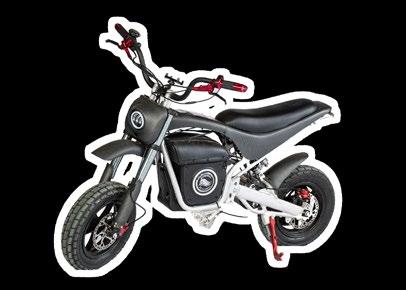
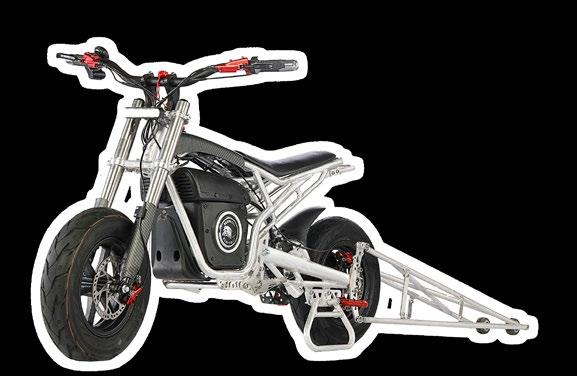



Opti-Coat of Memphis, Tennessee, was the first company to release automotive ceramic coatings in the USA, and they’ve made history once again by introducing ceramic coatings to NASCAR.
Opti-Coat’s blue-and-white logo was featured on the hood of Jeb Burton’s No. 27 Jordan Anderson Racing/Bommarito Autosport Chevrolet Camaro last fall at Homestead-Miami Speedway. In the October 2024 race, the No. 27 car was not just wearing Opti-Coat’s logo on the hood – the car entered the race with Opti-Coat’s Pro Ceramic Coating installed on the vehicle.
As far as we know, it’s the first time a ceramiccoated race car competed in a NASCAR race.
Ceramic coatings create a barrier between your vehicle’s paint and the elements, helping keep your vehicle looking new.
• Warrantied Protection from all the elements and sun damage
• Long-Lasting Shine & Gloss
• Ease of Maintenance
• U.V. Protection
• Chemical & Stain Resistance
• Scratch & Swirl Resistance
• Resistance to Dirt & Water Spots
• Water Beading



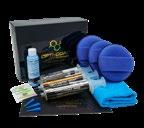
times the thickness of standard ceramic coatings with four layers of Silicon Carbide (SiC) protection.
• 10-Year Warranty with no yearly maintenance required
• Optional Lifetime Warranty
OPTI-COAT PRO PLUS
A two-layer SiC protective coating, delivering even more gloss and slickness than single-layer coatings while maintaining the same durable chemical structure as Opti-Coat Pro.
• Enhanced Water Beading and Dirt-Release Properties
• 7-Year Warranty
OPTI-COAT PRO
The original professional ceramic coating. A permanent bonding, single-layer Silicon Carbide (SiC) coating offering long-term protection.
• Up to 10 years of durability
• 5-Year Warranty
OPTI-COAT ULTRA SHINE
An SiO2-based ceramic coating offering extreme gloss, shine, and slickness at a lower price point.
• Can fill minor scratches and swirls
• 2-Year Warranty
OPTI-COAT PRO MOTORCYCLE CERAMIC COATING
Designed specifically for motorcycles, this includes:
• Opti-Coat Pro – Paint protection


Ceramic coatings were first developed in the 1970s for military and aerospace applications. In 2007, Opti-Coat introduced the first automotive ceramic coating for sale in the United States. This new type of coating was designed to protect the modern, damage-prone clear coat paint found on today’s vehicles.
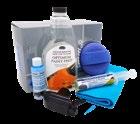
Opti-Coat coatings are unique in composition, utilizing Silicon Carbide (SiC) – also known as industrial diamond – because it is much longer lasting and more durable than the more commonly used Silicon Dioxide (SiO2). A single application of an SiC coating has a lifespan of at least 10 years, compared to 1-3 years for SiO2 coatings.
Opti-Coat Ceramic Coatings are not just for cars, trucks and SUVs. Opti-Coat has specialized coatings for boats, RVs, motorcycles and even race cars. Opti-Coat is installed by top Professional Detailers throughout the U.S. and Canada.
To find a Professional Installer near you, visit https://opticoat. com/pages/installers
AUTOMOTIVE
OPTI-COAT PRO3
The most advanced ceramic coating available, featuring four
• Opti-Guard Leather – Leather & vinyl protection
• Opti-Metal – Metal & chrome protection
• Protects motorcycle paint, leather, vinyl, metal, chrome, and even exhaust pipes
• 5-Year Warranty
RV & MARINE CERAMIC COATING
OPTI-COAT RV & MARINE
A protective ceramic coating designed for gelcoat surfaces found on RVs and boats.
• 5-Year Warranty
• Superior resistance to scratching, chemical etching, and UV fading
• Outstanding dirt-release properties
ABOUT OPTI-COAT
Opti-Coat has been designing and manufacturing ceramic coatings and auto detailing products in the USA since 2001. When looking for the best ceramic protection, paint protection film or auto detailing products to keep your vehicle, boat, RV, motorcycle or race car clean and protected, turn to Opti-Coat. For more information, visit www.opticoat.com.
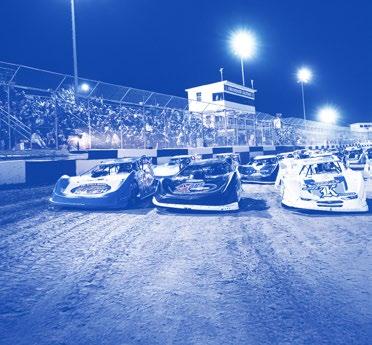

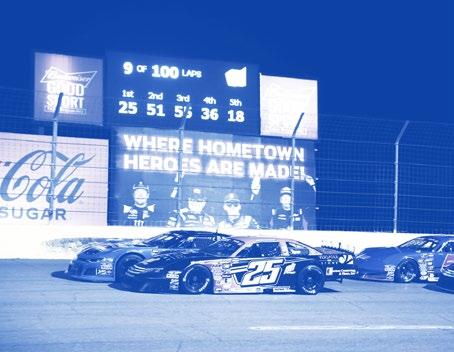

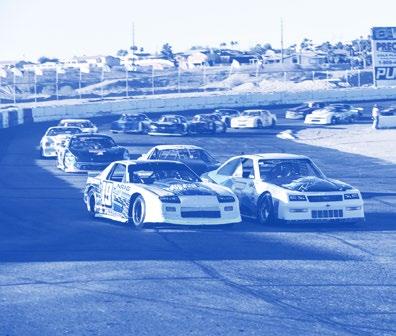
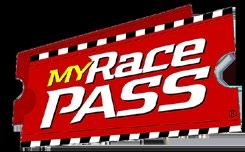

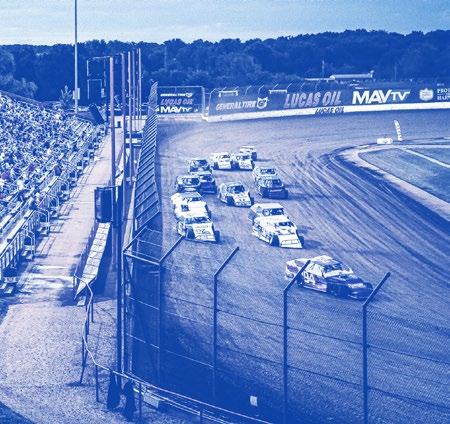



ALABAMA ■ Talladega Short Track ARKANSAS ■ Texarkana 67 Speedway ALASKA
Alaska Raceway Park
Havasu 95 Speedway
Placerville Speedway
Colorado National Speedway
■ Stafford Speedway
■ Delaware International Speedway HAWAII ■ Hilo Dragstrip
■ Freedom Factory ■ All-Tech Raceway
GEORGIA ■ Senoia Raceway IDAHO ■ Salmon Valley Speedway ILLINOIS
■ Spoon River Speedway INDIANA ■ Circle City Raceway IOWA
■ Knoxville Raceway
■ Shelby County Speedway ■ Dubuque County Fairgrounds Speedway
■ Lakeside Speedway KENTUCKY
Ponderosa Speedway LOUISIANA
State Capital Raceway
■ Oxford Plains Speedway
Hagerstown Speedway
■ Seekonk Speedway MICHIGAN ■ I-96 Speedway MINNESOTA ■ I-94 Speedway ■ Deer Creek Speedway MISSISSIPPI ■ Whynot Motorsports Park
■ Lebanon I-44 Speedway ■ Lucas Oil Speedway MONTANA
Mission Valley Super Oval
NEBRASKA
■ Eagle Raceway
■ Beatrice Speedway
NEVADA
■ The Bullring at LVMS ■ Summit Raceway NEW HAMPSHIRE ■ Riverside Speedway NEW JERSEY ■ Bridgeport Motorsports Park
NEW MEXICO
Suika Circuit NEW YORK
Oswego Speedway
Fulton Speedway
Brewerton Speedway
Ransomville Speedway
Land of Legends Raceway
NORTH CAROLINA
Hickory Motor Speedway
DAKOTA
Jamestown Speedway

Located across the road from the high banks of NASCAR’s longest superspeedway, Talladega Short Track has carved a high-speed legacy of its own –one that’s just as intense, but far more personal.
Known affectionately as “The Hornet’s Nest,” this one-third-mile Alabama clay oval opened in 1977 and has been buzzing with door-to-door dirt action ever since. It’s where big names get humble, local heroes become legends and fans pack the stands for some of the fiercest short-track racing in the South.
Big-Time
Talladega Short Track may be small in size, but it
Tucked along the Arkansas-Texas border, Texarkana 67 Speedway is one of those dirt ovals where weekend warriors and local legends collide under the lights. Since opening in 1967, this historic speedway has been a proving ground for grassroots racers looking to carve out their legacy.
Known for its tight racing lines and fast straights, the track has seen decades of thrilling door-to-door action across various divisions. A cornerstone of the region’s racing culture, the speedway remains a Saturday night favorite where families and fans gather to experience the raw, unfiltered energy of dirt-track racing.
the
Texarkana 67 Speedway isn’t just a dirt track –it’s a time capsule of Southern short-track racing.
delivers racing with a heavyweight punch. Its red clay surface and tight corners demand both precision and nerve, making it a favorite among regional Late Model stars and weekend warriors alike.
Weekly shows feature divisions like Super Late Models, Crate Late Models, Sportsmen, and Hot Shots – while national tours such as the Lucas Oil Late Model Dirt Series and the World of Outlaws Late Models and Sprint Cars make annual appearances.
Fans who’ve witnessed the Ice Bowl, the track’s season-opening marquee event, will tell you there’s nothing quite like it.
The roar of engines and the churn of Alabama clay light up most Saturday nights from spring through fall, with special events sprinkled throughout the year. Fans can view the schedule, ticket details and race night updates at TalladegaShortTrack.com.
Can’t be there in person? No problem – select events are streamed live on FloRacing.com.
Whether you’re chasing the roar of the Late Models or soaking in the local flavor, Talladega Short Track delivers pure, unfiltered racing under the Southern stars.
The semi-banked, clay oval stretches a third mile, providing the perfect battleground for Stock Cars, Factory Stocks, Limited Modifieds and more. Generations of local racers have cut their teeth here, with the track earning a reputation for side-by-side racing that often leaves fans breathless.
With seating for more than 3,000 fans, the grandstands buzz with energy every race night. Through ownership changes and economic challenges, the track has persevered – fueled by a passionate community that refuses to let its local racing roots fade.
Whether you’re a die-hard dirt fan or a curious first-timer, Texarkana 67 Speedway delivers edgeof-your-seat racing almost every weekend. Fans can catch live events at the track or follow the action online via RaceON.com for select race broadcasts.
Each season builds toward signature events like the prestigious Stock Car Shootout, drawing competitors from across the region.
The full schedule and event details are available at 67SpeedwayofTexarkana.com.

NICKNAME
The Hornet’s Nest
TRACK OPENED 1977
TRACK TYPE
High-banked oval
TRACK LENGTH
One-third mile
TRACK SURFACE
Red clay
SEATING CAPACITY
3,500
FEATURED DIVISIONS
Super Late Models, Crate Late Models, Sportsmen, Modifieds and Hot Shots.

NICKNAME
The Fastest Little Dirt Track in the South
TRACK OPENED 1967
TRACK TYPE
Semi-banked oval
TRACK LENGTH
One-third mile
TRACK SURFACE
Clay
SEATING CAPACITY
3,000+
FEATURED DIVISIONS
Factory Stocks, Limited Modifieds, Stock Cars, Modifieds and SportMods.
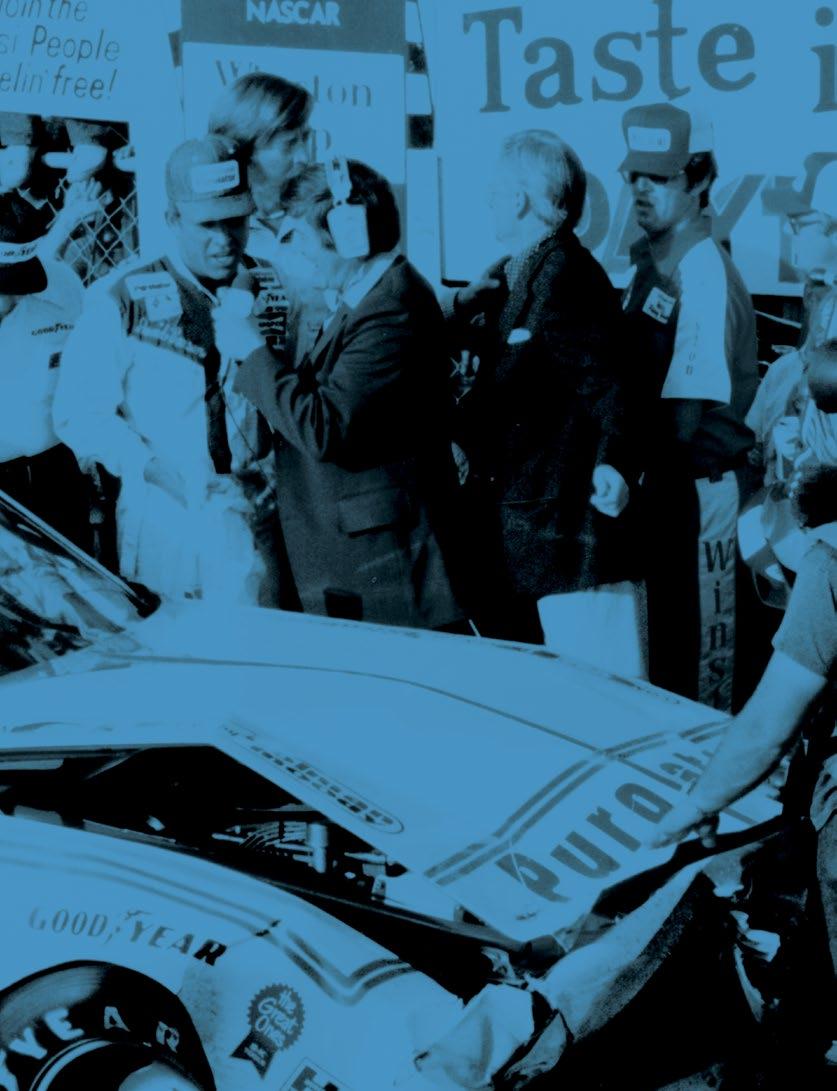
Alaska Raceway Park has been the state’s premier destination for short-track racing since 2016 when a one-third-mile paved oval was carved from the remains of an old riverbed in the shadow of Pioneer Peak.
The track is located near Palmer, Alaska, a community of nearly 6,000 people that’s 42 miles northeast of Anchorage along the Glenn Highway.
Far from the traditional roots of short-track racing, Alaska’s only NASCAR-sanctioned track stands as a testament to the industry’s reach and the determination of its racers to compete on a regular basis.
A 6,398-foot mountain located south of Alaska Raceway Park, Pioneer Peak provides one of the most unique backdrops in American short-track racing. The breathtaking views earned the track its nickname, “A View with a Race Track.”
ARP opened in 1964 as a quarter-mile dragstrip. A quarter-mile dirt oval then operated at the facility from 1980 to 1984, but the NHRA-sanctioned dragstrip remained its primary attraction for decades.
Oval-track racing has long been part of Alaska’s motorsports culture. For many years, North Star Speedway, a quarter-mile paved oval, was the state’s lone NASCAR-sanctioned track. However, local racers found themselves without a home when North Star closed in 2012.
Four years later, Alaska Raceway Park officials debuted a new, one-third-mile asphalt track. Located adjacent to the facility’s dragstrip, the new oval revived short-track racing in the region.
Sitting roughly 1,900 miles from its nearest NASCAR-sanctioned neighbor – Canada’s Edmonton International Raceway – Alaska Raceway Park faces a unique set of logistical hurdles. While drivers in the lower 48 may struggle to

locate specific parts, racers in Alaska face even greater difficulties. Finding a race-ready car is particularly challenging, as many drivers must wait for a car to be offered for sale or arrange to have one shipped to Alaska.
These logistical challenges also extend to racing essentials such as tires. As Alaska Raceway Park owner and “Lady Track Boss” Michelle Lackey explains, planning ahead is crucial.
“If the racers want tires, we do a big order in the spring,” Lackey said. “I have them put into a shipping container down in Washington and brought up here on the boat, and that’s what we’ve got.”
While ARP’s asphalt oval may be geographically isolated, this tight-knit racing community fosters a strong connection between the participants and the facility.
Standout names at the track on any given week include racers such as Damian Ackerman, who won five Bomber Stock features a year ago, and Jeremy Copley, a dominant competitor in the Thunder Stocks.
Race fans in the Carolinas should keep an eye on Trent Dillard, Alaska Raceway Park’s defending Late Model champion. Dillard advanced from Bandoleros to Legend Cars and then to Late Models at ARP before relocating to the Carolinas to pursue a career in stock car racing.
Alaska Raceway Park is truly a one-of-a-kind race track. However, when the green flag waves on any given race night, it becomes like any other of the nation’s short tracks – except for the breathtaking view, of course.
NICKNAME
A View with a Race Track TRACK OPENED 2016 TRACK TYPE Oval TRACK LENGTH
Third mile TRACK SURFACE
Asphalt SEATING CAPACITY
1,300 spectators and 300 pit area.
FEATURED DIVISIONS
Advance Auto Parts Weekly Series, Late Models, Baby Grands, Thunder Stocks, Bomber Stocks, Bandoleros and Legend Cars.
LEGENDS OF THE TRACK

Damian Ackerman, Trent Dillard and Jeremy Copley.
KEY EVENT IN HISTORY
The track’s grand opening in 2016.

WORDS: KAUY OSTLIEN PHOTOGRAPHY: HAVASU 95 SPEEDWAY


Just off of Arizona’s Route 95 near the California border, sits Havasu 95 Speedway. Located within a three-hour drive of both Phoenix and Las Vegas, this quarter-mile paved oval has a unique history and plays a major role in keeping asphalt racing alive in the desert Southwest.
After taking more than seven years to build, SARA Park Raceway opened in March 1989 as a quarter-mile dirt track. Built and managed by the Havasu Off-Road Racing Association, the track’s early years were anything but consistent because, according to the track’s website, “When the clay ran out, they closed the gates.”
The track’s opening chapter lasted only until 1996 at which time the racing surface was paved to start a new era as the story moved to chapter two.
However, SARA Park Raceway failed to find its groove in the pavement racing universe and racing came to a halt again in 2000. The facility sat abandoned until it was brought back to life in 2005, thanks in part to the efforts of current promoter Bill Rozhon.
With support from the Lake Havasu City Council and following a wide range of repairs and facility improvements, SARA Park Raceway was re-opened in 2006 as Havasu 95 Speedway– marking the start of its third and most successful chapter.

Though the track’s clay days ended in the 1990s, a nod to that heritage still exists – on a smaller scale.
Havasu 95 Speedway actually features two racing surfaces. The main track is a quarter-mile, two-groove asphalt oval with 9 degrees of banking. Nestled inside the frontstretch is a flat onesixteenth-mile clay oval designed specifically for divisions like the Outlaw Karts.
In addition to its unusual dual-track setup, Havasu 95 Speedway also flips the typical racing calendar. While most short tracks run from spring through fall, Havasu’s season begins in October and wraps up in April, taking advantage of milder winter weather in the Arizona desert.
Throughout the season, the track plays host to a wide variety of racing divisions. These include Pro Late Models, 602 Modifieds, Street Stocks, Factory Stocks, Legend Cars, 206 Outlaw Karts, Flat Karts and 125 Animals, Dwarf Cars, and Vintage Midgets & Sprints.
Havasu 95 Speedway also brings in a few touring series throughout the year. Among its most notable 2024-’25 dates was a Feb. 8 stop for the SPEARS CARS Tour West Pro Late Model Series – one of the top Pro Late Model tours on the West Coast. Dylan Zampa came away with the victory that weekend.
From grassroots racers to rising regional stars, Havasu 95 Speedway has solidified its place as a can’t-miss venue in the Southwest. Its story – once defined by inconsistency – is now one of growth, legacy and family-owned success.
Races from the track are streamed live on Low Budget TV, and fans can learn more or view the full schedule by visiting havasu95speedway.com.
LOCATION
Lake Havasu City, Arizona
NICKNAME
Havasu 95
TRACK OPENED 1989
TRACK TYPES
Ovals – outer and inner TRACK LENGTH
Outer: quartermile; Inner: onesixteenth mile TRACK SURFACE
Outer: asphalt; Inner: clay
SEATING CAPACITY over 2,500
FEATURED DIVISIONS
Pro Late Models, 602 Modifieds, Street Stocks, Factory Stocks, Legend Cars, 206 Outlaw Karts, Flat Karts and 125 Animals.
KEY EVENT IN HISTORY
The track’s grand reopening in September 2006 under the promotion of Bill Rozhon and his family.
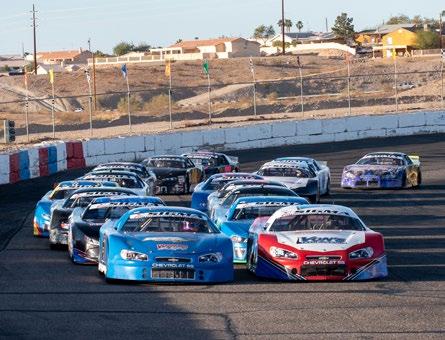

TURNS OUT TOP OPENWHEEL TALENT
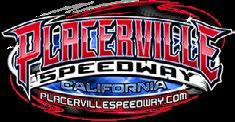
A little more than a century after the legendary California Gold Rush, another type of rush came to northern California in the form of Placerville Speedway.
Known as Hangtown Speedway when it opened in 1965, Placerville Speedway was carved from the region’s foothills. The highbanked, quarter-mile clay oval has produced several racers who have gone on to achieve national success.
Growing up near Placerville Speedway, Kami Arnold and Scott Russell were always drawn to the track. Arnold’s uncles raced there, and Russell’s father was also a competitor. Before getting his own race car, Russell worked as a crew member for a friend’s team.
In 2016, Arnold and Russell took on a new challenge – managing and promoting Placerville Speedway. Russell manages the activities inside the fence, working with track crews and racers, while Arnold oversees spectator engagement, including concessions, merchandising and the fan experience.
Their leadership has proven successful, earning them multiple Promoter of the Year awards. Most recently, in 2024, they received the Promoter of the Year honor for Region 6 during the RPM Promoters Workshops.
Placerville Speedway hosts 28 weekends of racing each year, featuring three to four divisions per event, with 25 to 30 cars in each class. The fast-paced format includes both A and B mains, ensuring a full night of nonstop racing.
“We want to make sure the fans and racers get their money’s worth and want to come back,” the promoters noted.
This commitment to quality racing has made Placerville Speedway one of the most popular tracks in the western United States.
Beyond the on-track action, the promoters work hard to keep fans entertained. When racing is on hold, spectators can enjoy activities such as hulahoop and dance contests, nickel tosses for kids, Pinewood Derby races, trivia competitions and other giveaways. Drivers also engage with the audience by tossing frisbees and candy into the stands, while the flag man adds to the excitement by handing out treats to young fans.
Placerville Speedway operates from March to November and hosts a variety of special events throughout the season. Fan-focused nights like Kids Bike Night, Mother’s Day Madness and First Responders Night bring the community together.
During Kids Bike Night, the track gives away more than 40 bicycles to local children and organizes bike races down the frontstretch.
On First Responders Night, the track is illuminated with red and blue emergency lights as local police departments showcase helicopters and SWAT units for fans to explore.
One of the most anticipated events is the NorCal Posse Shootout, held annually on the first weekend in May. This two-day event is a celebration of dirt racing history. Local car builder and restorer Rick Hurst brings out restored race cars, including old Wedge Cars, Pro Stocks, Hardtops and Sprint cars.
During this event, racing legends return to Placerville Speedway to make exhibition laps, preserving the grassroots heritage of the sport and paying homage to the track’s storied past.
LOCATION
Placerville, California
NICKNAME
Little Knoxville on the Hill
TRACK OPENED 1965
TRACK TYPE
High-banked oval
TRACK LENGTH
Quarter mile
TRACK
SURFACE
Red clay
SEATING CAPACITY
1,800 in the main grandstands and 2,000 pit side.
FEATURED DIVISIONS Winged 360 Sprint Cars, Limited Late Models, Pure Stocks, Mini Trucks and Winged 410 Sprint Cars.
LEGENDS OF THE TRACK Brad Sweet, Kyle Larson (first Winged 360 win), Buddy Kofoid, Geo Scelzi, Paul McMahan and Andy Forsberg.
KEY EVENT IN HISTORY
World of Outlaws
Sprint Car Series races, USAC National Midget Series events and visits by the High Limit Sprint Car Series.

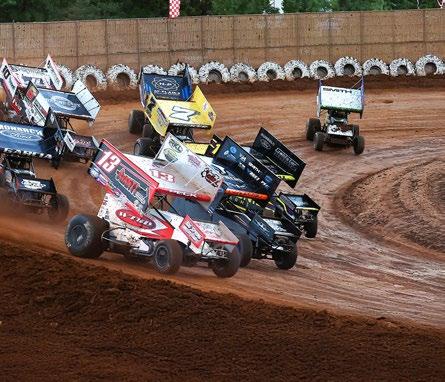

WORDS: JOSH MULL
Set against the stunning backdrop of the Rocky Mountains, Colorado National Speedway is the heartbeat of short-track racing in the Centennial State. Located in Dacono, the three-eighths-mile paved oval has been thrilling fans with high-speed action since opening in 1965.
As one of the premier NASCAR-sanctioned short tracks in the West, it has hosted countless battles featuring both local stars and rising national talent. With a mix of grassroots intensity and professionallevel competition, Colorado National Speedway continues to be a must-visit destination for motorsports enthusiasts.
Colorado National Speedway offers a dynamic lineup of divisions, including Super Late Models, Pro Trucks,
Grand American Modifieds, Super Stocks and Figure 8 racing. The track’s schedule is packed with high-profile events such as the prestigious Challenge Cup, the Tribute to Tommy Gould and the annual Firecracker 100.
The speedway has also been a longtime host for NASCAR’s ARCA Menards Series West, bringing national-level competition to Colorado fans. Weekly racing keeps the energy high, showcasing intense battles on one of the most competitive short tracks in the region.
For those looking to experience the thrill of racing firsthand, Colorado National Speedway’s website (coloradospeedway.com) provides full event schedules, ticket details and race-day information. Fans who can’t make it to the track can catch select races live through FloRacing, the official streaming partner for the speedway.
Additional highlights and coverage can be found on NASCAR Roots and the track’s social media platforms. Stay connected via Facebook, Twitter (X), Instagram and YouTube for updates, behind-the-scenes content and exclusive driver interviews.
While Hawaii lacks a traditional short track – paved or dirt – race fans still have a home for high-speed action at Hilo Dragstrip. Located on the Big Island, this quarter-mile dragstrip has been the heart of Hawaiian motorsports since opening in 1978.
From grassroots racers to high-performance machines, Hilo Dragstrip showcases an adrenalinefueled mix of competition. The track is a vital part of the local racing community, giving drivers a place to prove themselves and fans an opportunity to witness thrilling side-by-side duels.
With a backdrop of tropical scenery and a passionate fan base, Hilo Dragstrip stands as a motorsports destination that blends speed, culture and tradition.
Hilo Dragstrip has long been a proving ground for


NICKNAME
The Premier Short Track of the Rockies TRACK OPENED 1965
Three-eighths mile
Super Late Models, Pro Trucks, Grand American Modifieds, Super Stocks, Figure 8s and more.
Hawaii’s fastest drivers. The track regularly hosts a variety of events, from local bracket racing to NHRA-sanctioned eliminations. The quarter-mile strip challenges racers to push their machines to the limit, whether they’re piloting a classic muscle car, an import tuner or a full-fledged dragster.
The track’s history is rich with legendary battles and unforgettable moments, as drivers race against the clock and one another to claim victory. With a focus on community and accessibility, Hilo Dragstrip welcomes racers of all levels, ensuring that motorsports remains alive and well in Hawaii.
One of the highlights of the track’s calendar is the annual Hilo Dragstrip Nationals, a marquee event that draws top racers from across the islands and beyond. Fans can expect intense competition, blistering speeds and a festival-like atmosphere.
Those unable to attend in person can still experience the action through live streaming on the track’s official website, hilodragstrip.com, and social media channels.
NICKNAME
The Big Island’s Speed Capital TRACK OPENED 1978 TRACK TYPE Dragstrip TRACK LENGTH Quarter mile
SURFACE Asphalt FEATURED DIVISIONS
Bracket Racing, NHRA Events, Muscle Cars, Import Tuners and Dragsters.
WORDS: KAUY OSTLIEN

Located in Stafford Springs, Connecticut, Stafford Speedway is one of the nation’s premier short tracks. Its storied history dates back to the grand opening of the Stafford Springs Agricultural Park in 1870. Known for its multifaceted agricultural events like horse racing, the park’s half-mile dirt track emerged as a hotbed for auto racing when the sport’s popularity skyrocketed following World War II.
As a dirt track, Stafford established itself as a destination for Modified racing and that reputation
THE DIAMOND OF THE DELMARVA PENINSULA
WORDS: ALLEN WALKER
Located in Delmar, Delaware, the Delaware Motorsports Complex is home to Delaware International Speedway. Constructed in 1963 as a drag racing facility, the Cathell family eventually developed an interest in dirt racing and decided to expand.
A dirt track was built and leased by the Delmarva Auto Racing Association from 1965 to 1968. After that organization’s tenure, the dirt oval was relocated to its current site in 1969, featuring a third-mile oval with a Figure-8 layout.
On Saturday nights during the racing season, Delaware International Speedway comes alive under the lights, visible from U.S. Highway 13. The track hosts a variety of divisions, including Modifieds, Late Models, Street Modifieds, ACDelco Modifieds
only grew after the racing surface was paved in 1967.
The track’s record book is full of familiar names, including Ted Christopher, Pete Hamilton, Geoff Bodine and current Cup Series driver Ryan Preece.
Richie Evans, Jerry Cook and Mike Stefanik celebrated success at Stafford on their way to the NASCAR Hall of Fame.
“Coming off a great 2024 season for all of our weekly divisions, we are continuing to keep our focus on showcasing our teams and drivers,” said track CEO Mark Arute. “With a mix of special events and a strong weekly racing program, our 2025 schedule puts our five weekly divisions in the spotlight every Friday night. Our goal is to make sure every event on the calendar is important and we believe our 2025 schedule does just that.”
Dubbed “The Greatest Race in the History of Spring,” Stafford opened its season in late April with the 53rd running of the Spring Sizzler. It is one of asphalt short-track racing’s marquee events.
NICKNAME
Home of the SK Modified
TRACK OPENED Auto racing started after WWII TRACK TYPE Oval
TRACK LENGTH
Half mile
TRACK SURFACE
Asphalt
SEATING CAPACITY
7,000 frontstretch, 1,300 pit area
FEATURED DIVISIONS
Late Models, Limited Late Models, Open Modifieds, Street Stocks, SK Modifieds and SK Lights.
and Modified Lites.
For the past 25 years, the Cathell family has donated its facility and crew to support the Camp Barnes Benefit Race. This annual event raises funds to send disadvantaged children to camp, attracting substantial community support and generating hundreds of thousands of dollars for the cause.
Delaware International Speedway has remained a family owned operation since 1963 and continues to be managed by the Cathell family. When asked about their offseason, family members said there isn’t one. During the quieter months, they are hard at work preparing for the upcoming season, focusing on scheduling, marketing and overall improvements.
The track’s impact extends beyond racing. Recognized by the Delaware Tourism Bureau as the eighth most popular attraction in the state, the speedway has solidified its reputation. Additionally, track owner Charlie Cathell received national recognition in 2004 when he was named Auto Racing Promoter of the Year during the annual Promoters Workshops in Daytona Beach, Florida.

FACTS
NICKNAME
The Diamond of the Delmarva Peninsula
TRACK OPENED 1963
TRACK TYPE Oval with Figure-8 layout
TRACK LENGTH
One-third mile
TRACK SURFACE
Clay
SEATING CAPACITY
5,000
TRACK OWNER HAS MASSIVE ONLINE PRESENCE

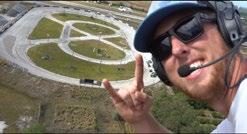
Freedom Factory, a one-third-mile paved oval and Figure-8 course located in Bradenton, Florida, may be the nation’s best-known short track – a distinction achieved by hosting nontraditional events and extreme activities in today’s social-media universe.
The track’s massive online presence includes more than 4 million YouTube subscribers who tune in to follow the adventures of track owner and occasional racer Garrett Mitchell, who is known professionally as Cleetus McFarland.
Built by local racer Gene Tharpe, the threeeighths-mile asphalt oval was known as DeSoto Speedway when it opened during the late 1970s. For decades, DeSoto Speedway was a fixture on Florida’s short-track racing scene.
Like many grassroots facilities, however, the track eventually fell into disrepair and closed in the late 2010s. But in 2020, the track got a second chance – not from a developer or racing promoter, but from a die-hard car enthusiast and content creator.
Mitchell announced his purchase of the abandoned facility on Jan. 31, 2020, via his Cleetus McFarland YouTube channel. He renamed it Freedom Factory and launched a full-scale revival project, bringing the forgotten speedway back to life.

While the oval track is the star of Mitchell’s content, fans of his channel know that just beyond Turns 1 and 2 of Freedom Factory lies Bradenton Motorsports Park, a premier quarter-mile dragstrip. It has long hosted major events like the Snowbird Outlaw Nationals – and has served as a backdrop for many of Mitchell’s videos.
In January, Mitchell announced he had purchased a 50 percent ownership stake in Bradenton Motorsports Park.
“Without this dragstrip,” he said, “I don’t think my channel would be half of what it is today.”
The combined oval and dragstrip complex offers a unique blend – part race track, part content studio and all high-octane energy.
While Freedom Factory hosted a few events shortly after reopening, it wasn’t until February 2021 that fans were allowed back in the stands. Since then, it’s remained anything but traditional.
Sure, you’ll find familiar short-track fare – Super Late Models, Figure 8 races, Demolition Derbies –but the venue’s true signature lies in its unique events and viral spectacles.
Take the Freedom 500, for example: a full field of Ford Crown Victorias driven by internet personalities, pro racers and influencers. Or the 2025 amateur showdown featuring 76 Nissan Altimas – a spectacle that packed the grandstands and lit up social media.
Whether you are a drag-racing enthusiast, ovaltrack junkie or just looking for something wild and different, Freedom Factory delivers.
LOCATION
Bradenton, Florida
TRACK OPENED
Late 1970s
TRACK TYPE Banked oval TRACK LENGTH
Threeeighths mile TRACK SURFACE
Asphalt SEATING CAPACITY
5,000 FEATURED DIVISIONS
Super Late Models, Sportsmen, Pro Trucks, Street Stocks, Legend Cars, Mini Stocks, Modified Minis, Sprint Cars and Open-Wheel Modifieds. LEGENDS OF THE TRACK
Dave Steele, Butch Lindley, Nick Neri, Robbie Knievel and Richard Petty.
KEY EVENT IN HISTORY
First public event under new ownership held in February 2021.
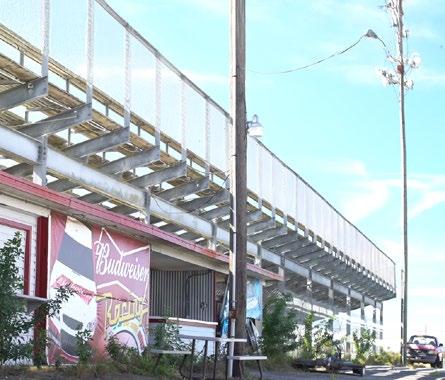



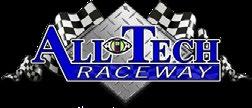

When it comes to short-track racing, there are hidden gems scattered across the United States, but few embody that title better than All-Tech Raceway – proudly known as The Hidden Gem of the South.
Located in Lake City, Florida, the track has a rich history, a reputation for thrilling races and a loyal fan base that continues to grow.
All-Tech Raceway dates back to 1972, when it was first known as North Florida Speedway. Over the years, the track underwent several name changes, including a major rebrand as Columbia County Motorsports Park, which brought the facility its most significant upgrade. Though it started as a dirt track, CCMP’s racing surface was paved in 1986 and it ran as an asphalt venue for nearly three decades.
Racer and engine builder Wendell Durrance had long dreamed of owning the track. After 13 years of pursuing the opportunity, he connected with Dean Smith. Together, they purchased the speedway, and their first decision was a bold one – tearing up the asphalt and bringing the dirt back.
Thus, the dirt rebirth of the facility that was christened All-Tech Raceway.
For a dirt track, All-Tech is massive. Its
half-mile layout rivals superspeedways in size, and with eight degrees of banking on the straightaways, 14-degree corners and a 75-foot-wide racing surface, it stands out as one of Florida’s most distinctive venues.
Kyle Larson, known for his dominance in Sprint Cars and Midgets, made his fifth Super Late Model start at All-Tech – and made it count. Against a field of 25 cars, Larson put on a clinic, lapping up to eighth place before taking the checkered flag.
All-Tech Raceway plays host to the Lucas Oil Late Model Dirt Series, among others. The Short Track Super Series and Crate Racin’ USA Series are also longtime staples of the track’s schedule, having raced there for over five years.
Many drivers, both asphalt and dirt veterans, have left their mark at All-Tech. NASCAR Hall of Famer Davey Allison cut his teeth there, and shorttrack great Brett Hearn was so impressed that he dubbed it “The Hidden Gem of the South” – a nickname that stuck.
According to Durrance, it’s the top-notch upkeep. The facility is maintained with such care that it’s been compared to a golf course in appearance. And the concessions are legendary – especially the Boston Butts, smoked with pecan wood and made from fresh, never-frozen meat.
Of course, racing for big money doesn’t hurt either. Randy Weaver once pocketed $100,000 for a win at the track. And when Devin Moran topped a Lucas Oil Late Model event, he declared All-Tech Raceway one of the top five-tracks in the country.
LOCATION
Lake City, Florida
NICKNAME
The Hidden Gem of the South TRACK OPENED
1972
TRACK TYPE
Banked oval TRACK LENGTH
Half mile TRACK SURFACE Dirt SEATING CAPACITY
4,000 FEATURED DIVISIONS
Lucas Oil Late Model Dirt Series, Short Track Super Series and Crate Racin’ USA Series.
LEGENDS OF THE TRACK
Kyle Larson, Davey Allison and Brett Hearn. KEY EVENT IN HISTORY
After Devin Moran won a Lucas Oil Late Model Dirt Series race at All-Tech, he called it a top-five track.

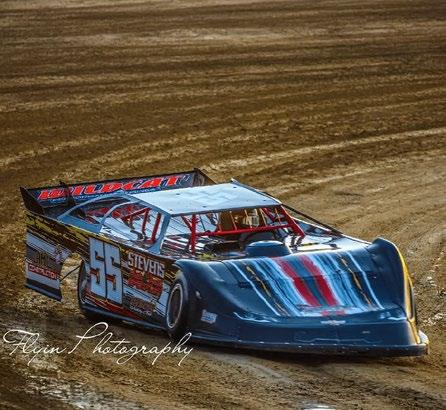
WORDS: ALLEN WALKER PHOTOGRAPHY: SENOIA RACEWAY

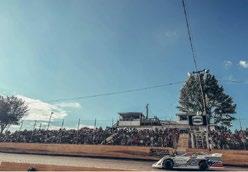
Hence Pollard and his son, Sonny, attended a dirt-racing event at Georgia’s Coweta Raceway during the late 1960s. After the festivities were complete, the younger Pollard was surprised to hear his father say, “We are going to build a race track.”
And that’s exactly what they did.
Digging up a cow pasture on their property, the Pollards built a three-eighths-mile dirt oval. Senoia Raceway opened in 1969 and became a full family effort – Hence’s wife managed the business affairs, Sunny handled track prep and other family members helped with concessions and tickets. The track remained family owned and operated until Hence Pollard’s sudden passing in 1981.
That same year, the track was sold to Charlie Edwards. Hence Pollard had discussed selling the track if something ever happened to him. While the Pollards owned the facility, Sunny wasn’t allowed to race there, so the sale gave him the opportunity to begin his driving career in his mid-20s. During that time, Sunny had children of his own, and the family spent weekends at Senoia Raceway and other tracks across the country, running Legend Cars and Late Models.
In 1989, Edwards paved the Senoia track. He operated it solo until the late 2000s when he began leasing it to other promoters. In 2010, new leaseholders brought in red Georgia clay,
converting the track back to its original surface. This move brought renewed attention as the major dirt-racing series began making annual visits.
In the mid-2010s, the Massey family took over the lease and replaced the red clay with gray clay sourced from strip mines.
Sunny Pollard stayed in contact with Edwards for years and had always expressed interest in buying the track if it was ever on the market. At the end of 2020, that opportunity came.
With the Pollard family back at the helm, Senoia Raceway has elevated its weekly racing program, incorporating ideas and experiences they’ve gathered from race tracks across the country.
Generational fans help preserve the track’s history while always looking ahead. With a family-friendly atmosphere, Senoia Raceway is a Saturday-night destination. Fans can even purchase season passes, and the venue includes 2,000 hand-dug concrete grandstand seats along with a trackside tailgating area.
While Senoia Raceway hosts competitive local and national racing series – including the World of Outlaws Late Model Series, the Schaeffer’s Oil Southern National Series and now the American Flat Track motorcycles – no event compares to the track’s Late Model headliner – the Peach State Classic.
Launched in 2021, this Classic has quickly become a must-see and must-run event. The weekend kicks off on Thursday night with local divisions. Friday features the 602 Late Models and Saturday closes out with the 604 division. The purse totals are some of the highest in Georgia: $68,000 on Friday and $135,000 on Saturday.
Last season, Senoia Raceway hosted more than 130 campers on-site for the event. This year, the Peach State Classic will be the finale of the FloRacing Night in America series.
LOCATION
Senoia, Georgia TRACK OPENED 1969
TRACK TYPE
Semi-banked oval
TRACK LENGTH
Three-eighths mile
TRACK SURFACE
Gray Clay
SEATING CAPACITY
2,000 concrete bleachers hand dug
FEATURED DIVISIONS
Late Models, Hot Shots, Mini Stocks, 602 Chargers and Limited Late Models.
LEGENDS OF THE TRACK
Mike Head (National Dirt HOF and Georgia HOF), Leon Archer, Leon Sales, Fletcher Cavender, Roscoe Smith, Sammy Cooper, Ricky Williams, Glen Morris and Clint Smith.
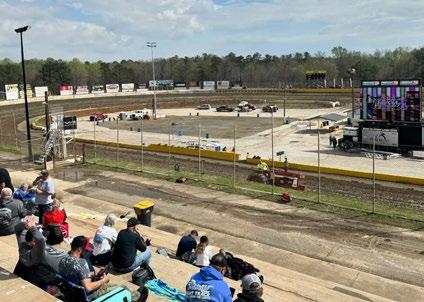
KEY EVENT IN HISTORY
Launched in 2021, the Peach State Classic has become a marquee event among southern dirt tracks.
WORDS: ARMANY DEPAUL

Salmon Valley Speedway is the pride of short-track racing in Idaho. Located in Lemhi County, the quarter-mile dirt oval offers a family-friendly atmosphere and a true grassroots racing culture.
Opened in the 1990s, SVS has hosted some of the state’s best racing. However, like many short tracks across the country, Salmon Valley has endured difficult days.
During its early years, Salmon Valley Speedway enjoyed a solid run, but things took a turn in 1998 when the track fell on hard times and began a period of limited activity. That slowdown lasted until 2019,
when the speedway was forced to close.
Enter Sean Jackson. With a deep racing background, Jackson had already helped revive tracks such as Altamont Raceway Park in California back in the 1990s. He was also a racer himself, competing in both Modifieds and Sprint Cars.
Jackson brought his racing passion to Salmon Valley, where he helped bring the dormant track back to life. On May 15, 2021, under his guidance, the speedway reopened for its first race weekend in two years. For the first time in more than two decades, racing returned to Salmon Valley on a consistent basis.
NICKNAME
TRACK OPENED 1990s, reopened in 2021 TYPE
Louisiana’s Fastest Short Track TRACK OPENED 1968
Semi-banked oval LENGTH
NICKNAME X
TRACK TYPE Paved oval
TRACK LENGTH
TRACK OPENED X
Quarter mile with a one-sixth-mile inner track
Three-eighths mile
When Salmon Valley reopened, it began hosting IMCA-sanctioned events, including Modifieds, Sport Mods and Sport Compacts. The track has also welcomed WISSOTA Super Stocks and WISSOTA Street Stocks in past seasons.
The primary track is a quarter-mile, semi-banked dirt oval. An aerial view shows the cars launching down the front straightaway, diving into the first of two semi-banked corners, then racing down the backstretch and repeating it all over again. Inside the main oval is a one-sixth-mile dirt track – adding even more excitement and flexibility.
TRACK SURFACE
TRACK TYPE X
SEATING CAPACITY
800
Asphalt
TRACK LENGTH X
FEATURED DIVISIONS
SEATING CAPACITY 4,000
TRACK SURFACE X
FEATURED DIVISIONS
SEATING CAPACITY X
FEATURED DIVISIONS X
Pro Stocks, Late Models, Modifieds, Street Stocks and more.
IMCA Modifieds, IMCA Sport Compacts, WISSOTA Super Stocks, WISSOTA Street Stocks, Renegade Sprint Cars and more.

WORDS: ALLEN WALKER
Spoon River Speedway founder Morey Denney began racing in the 1970s, and in 1982, he and his brother decided to build a track on their farm. With help from Buckheart United Coal Mines, the threeeighths-mile, high-banked clay oval opened in 1983. Featuring 23 degrees of banking in the turns and widths of up to 80 feet, Spoon River quickly gained a reputation for speed and side-by-side racing that pushes cars over 100 mph.
Still owned by Morey Denney, Spoon River Speedway has delivered thrilling weekly action for over 40 years. Its rural setting and lack of local restrictions have allowed for consistent, crowd-pleasing racing and top-tier track prep.
In 2010, Morey’s son Brad took over and operated the track through 2023. In 2024, the Denneys leased the speedway to Tim Neidig, who is now leading
the next chapter. After a strong first year, Neidig is focused on making 2025 the best season yet.
This year’s schedule adds new excitement with NFT Flat Track Motorcycles and go-kart racing on a specially built mini-oval. The World of Outlaws Sprint Cars will also return for another major event weekend, drawing top drivers and fans alike.
The marquee event at Spoon River is the Plowboy Nationals. Entering its 35th year, the three-day spectacle is one of the Midwest’s most anticipated dirt races. Action kicks off Friday with E-Mods and Hornets, followed by UMP Pro Late Models on Saturday and Sunday.
More than 115 cars raced in last year’s edition, with that total expected to top 200 in 2025. With a major purse up for grabs, it’s a can’t-miss event for drivers and fans alike.
Spoon River has earned its place as Illinois’ premier three-eighths-mile dirt track. From its wall-free turns to the intensity of its high banks, it remains one of the most respected and loved tracks in the region.


NICKNAME
Spoon River or The High Banks 1983 High-banked oval
Three-eighths mile
Yellow clay CAPACITY
3,500 full capacity FEATURED DIVISIONS
DIRTcar UMP Modifieds, DIRTcar Pro Late Models, DIRTcar Pro Modifieds, B Modifieds, DIRTcar Sport Compacts and DIRTcar Stock Car.

March 30th & April 6th Practice Test/Tune, All Classes
April 12th
PLM, B MOD, Pro MOD, HOB, Stock Car, IMRA MIDGET, Kids MOD May 3rd
PLM, B MOD, Pro MOD, HOB, Stock CAR
May 7th
FLO Night in America, SLM, MOD, PLM May 17th
PLM, B MOD, Pro MOD, HOB, Stock Car, Kids MOD, ASCT Sprints
May 24th
Day 1 Spring Nationals – MOD, HOB, PLM, IMRA Midget May 25th
MARS – Gary Cook Jr Memorial, Late MODS, PLM, B MOD, Pro MOD, HOB, K1, Vintage Sprints
June 14th
PLM, B MOD, Pro MOD, HOB, Stock Car
June 21st
PLM, B MOD, Pro MOD, HOB, Stock Car
June 28th
PLM, B MOD, Pro MOD, HOB, Stock Car, ASCT Sprints
5/4, 5/18, 6/1, 6/29, 7/26
9/7, 9/21
KNOWN AS ‘HEAVEN
WORDS:

Located 20 minutes from downtown Indianapolis, Circle City Raceway opened in 2021 and the quarter-mile dirt track has emerged as a popular destination for both fans and racers from across Midwest.
Donna and Eddie VanMeter – veteran racers with more than 36 years of experience – purchased the facility in October 2023 with a vision of transforming the Hoosier State’s newest short track. Through their guidance, dedication and perseverance, Circle City Raceway is now known as “Heaven on Dirt.”
Entering the grandstands, fans are immediately drawn to a massive videoboard on the backstretch. The state-of-the-art, LED screen provides a live feed of the racing action, ensuring fans can follow every lap from anywhere in the facility. For those unable to attend, the racing is live-streamed on CircleCityRacewayTV.com.
New this season, a VIP suite and balcony offer an unparalleled bird’s-eye view of the track, creating a premium experience for fans, businesses and sponsors.
Beyond the racing, the midway is lined with merchandise vendors and concession stands, while he track’s dedicated employees – known as some of the friendliest in dirt racing – are always available to assist.
“Our staff is some of the smartest, kindest and most patient in racing. From concessions to race officials, they always make sure everything is taken care of for our fans and racers,” the VanMeters proudly noted.
At Circle City Raceway, food isn’t an afterthought – it’s a featured attraction. Instead of the usual burgers and hot dogs, the track has assembled a race-day menu like no other. Fried

bologna sandwiches, smoked pork chops and freshly grilled specialties ensure fans never have to stop for dinner while en route to the track.
And for those looking to cool off on a hot summer night, hand-spun milkshakes and signature margaritas have become fan favorites.
“Our goal was to create a menu that allowed families to come straight from school or work on a Friday night without worrying about dinner,” said Donna VanMeter.
The experience doesn’t end with dinner as freshly baked cookies cap the evening.
An open practice session on April 5 allowed racers to shake off the rust prior to the April 11 season opener.
Fans can expect more than 120 cars to fill the pit area for the track’s weekly Friday night events with the Midwest Thunder 410 Sprint Cars, UMP Modifieds and Indiana Crate Late Models rotating among the many divisions.
An impressive slate of special events includes appearances by the Lucas Oil Late Model Dirt Series, the USAC National Sprint Car Series, the USAC National Midgets and the Northern All Stars Late Model Series.
The season concludes Saturday, Oct. 18, with the highly anticipated Spooky 150. This 10division program showcases a full day of racing action.
In a state known for its numerous and historic short tracks, Circle City Raceway has earned its spot, offering pure dirt-track entertainment, a family atmosphere and an unparalleled weekly racing experience.
LOCATION
Indianapolis, Indiana
NICKNAME
Heaven on Dirt TRACK OPENED
May 2021
TRACK TYPE
Sightly banked oval TRACK LENGTH
Quarter mile TRACK SURFACE
Clay
SEATING CAPACITY
6,500 grandstands, 800 pit area stands, 100 suite area.
FEATURED DIVISIONS
Midwest Thunder 410 Sprint Cars, Indiana Crate Late Models, UMP Modifieds, CCR Grub Getters and UMP Hornets.
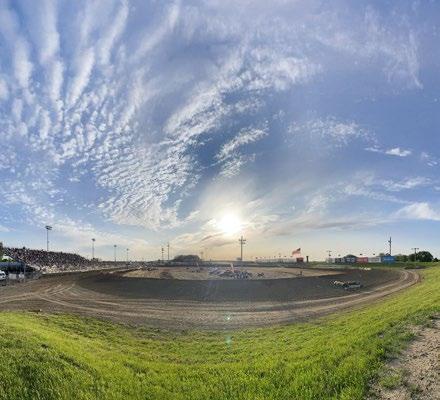
LEGENDS OF THE TRACK
Tony Stewart, Kyle Larson, Kyle Busch, Rico Abreu and Brexton Busch.
KEY EVENT IN HISTORY
The Lucas Oil Late Model Dirt Series will visit the track on Friday, May 2.
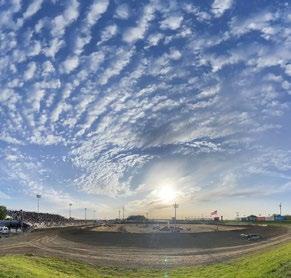

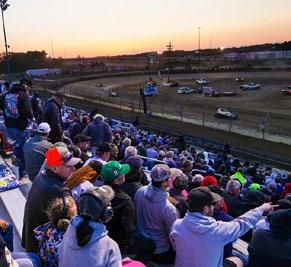

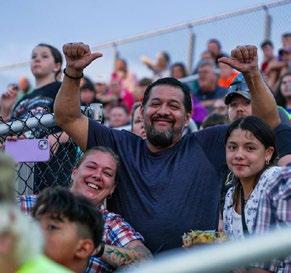
SATURDAY April 5 TRACK SEASON OPENER PRACTICE ONLY
SUNDAY April 13 Season Opener
Midwest Thunder 410, UMP Modifieds, CCR Grub Getters, Crown Vic’s, Pure Stocks, Hornets
FRIDAY April 18 Sprints and More
Midwest Thunder 410, Midwest Mini Sprint Assoc., Crown Vic’s, Pure Stocks, Super Stocks, Hornets, SPRINT KARTS
FRIDAY May 2 Lucas Oil Dirt Super Late Models
Lucas Oil Late Model Dirt Series, Crown Vic’s, Super Stocks
FRIDAY May 9 Friday Night Racing Action
Circle City Raceway Steel Block Sprints, UMP Modifieds, 600cc Outlaw Non Winged Micros, Crown Vic’s, Super Stocks
FRIDAY May 16 CJ Rayburn Tribute Race
Northern Allstars Late Model Series, UMP Modifieds, Crown Vic’s
THURSDAY May 22 USAC National Sprint Cars
USAC National Sprint Cars, USAC Midwest Thunder Speed2 Midgets, Crown Vic’s
FRIDAY May 30 INDY Is Racing in MAY
Midwest Mini Sprint Association, Midwest Thunder 410, CCR Grub Getters, Crown Vic’s, SPRINT KARTS, Midwest Vintage Racecars
TUESDAY June 3 USAC Midgets
USAC National Midgets, USAC SPRINTS
FRIDAY June 6 Sprints Midgets and More
Circle City Raceway Steel Block Sprints, 305 Sprints - Winged, UMP Modifieds, All Star Circuit of Champions TQ Midgets, CCR Grub Getters, Super Stocks
SATURDAY June 14 OVERDRIVE Monster Trucks
OVERDRIVE MONSTER TRUCKS
FRIDAY June 20 Gear Up for Friday Night Racing
Midwest Thunder 410, Midwest Mini Sprint Assoc., Indiana Crate Late Models, CCR Grub Getters, Crown Vic’s, SPRINT KARTS
THURSDAY July 3 Dirty Destruction Demo Derby
CCR Grub Getters, School Bus Races, 4-Cylinder Demo
FRIDAY July 11 Epic Friday Night Under the Lights
Indiana Crate Late Models, UMP Modifieds, CCR Grub Getters, Crown Vic’s, Pure Stocks, Super Stocks
FRIDAY July 18 Unforgettable Night of Racing
Circle City Raceway Steel Block Sprints, UMP Modifieds, CCR Grub Getters, Pure Stocks, Super Stocks, Hornets
FRIDAY July 25 O’Reilly Auto Parts Night at the Races
Circle City Raceway Steel Block Sprints, 305 Sprints - Winged, Midwest Mini Sprint Assoc., Crown Vic’s, Super Stocks, Hornets
WEDNESDAY July 30 USAC Sprint Week
USAC National Sprint Cars, UMP Modifieds
FRIDAY Aug. 8 Unlimited Racing Showdown
SCDRA - Sport Compact Dirt Racing Association, Midwest Thunder 410, UMP Modifieds, CCR Grub Getters, Crown Vic’s, SPRINT KARTS
FRIDAY Aug. 15 Circle City Raceway
MTSC - Midwest Throwback Sprint Cars, 305 Sprints - Winged, UMP Modifieds, Pure Stocks, Super Stocks, Hornets
FRIDAY Aug. 29 Ashlea Albertson Memorial
Midwest Thunder 410, Midwest Mini Sprint Assoc., 600cc Outlaw Non Winged Micros, All Star Circuit of Champions TQ Midgets
FRIDAY Sep. 12 Circle City Raceway
USAC National Sprint Cars, USAC Midwest Thunder Speed2 Midgets, Super Stocks
FRIDAY Sep. 19 Indiana Pro Late Model Series
Circle City Raceway Steel Block Sprints, Indiana Crate Late Models, UMP Modifieds, Crown Vic’s, Super Stocks, Hornets
FRIDAY Sep. 26 Circle City Raceway
Midwest Thunder 410, UMP Modifieds, CCR Grub Getters, Crown Vic’s, Pure Stocks, SPRINT KARTS
SATURDAY Oct. 4 The Kenny King Tribute
Crown Vic’s, Hornets, OUTLAW WINGED FIGURE 8 CARS, Mini Outlaw F8 Late Models
SATURDAY Oct. 18 4th Annual Spooky 150
Circle City Raceway Steel Block Sprints, UMP Modifieds, 600cc Outlaw Non Winged Micros, All Star Circuit of Champions TQ Midgets, CCR Grub Getters, Crown Vic’s, Pure Stocks, Super Stocks, Hornets, 305 Sprints - Non-Winged
Located on the Marion County Fairgrounds, Iowa’s Knoxville Raceway has been a cornerstone of American motorsports since the early 1900s.
Now celebrated as the “Sprint Car Capital of the World,” the half-mile clay oval is home to the annual Knoxville Nationals – a four-day winged Sprint Car spectacle most industry insiders consider to be short-track racing’s premier event.
To understand the significance of Knoxville Raceway, one has to go back to the late 1870s. Like many early fairgrounds tracks, it was built for horse racing. That changed in 1901 when the first auto races were organized. While racing became the focal point, the venue also served other purposes – Knoxville High School’s home football games were played in the infield until the late 1930s.
After World War II, stock car racing boomed across the country. Cars were cheap, plentiful and perfect for dirt-track competition – and Knoxville was no
exception. In 1954, weekly racing became a regular part of the schedule. With the addition of banking, fencing and lights, Knoxville began to transform into the facility fans know today.
The track’s modern legacy took shape in 1956 when Iowa native Marion Robinson became the promoter. Under his leadership, Knoxville evolved rapidly, starting with stock cars, then transitioning to Modifieds, then Supermodifieds and eventually settling into its identity with Sprint Cars.
In 1961, Robinson founded the Knoxville Nationals, a late-season special event intended to bring the nation’s top supermodified drivers to Knoxville for two days of racing. Southern Indiana star Roy Robbins won the inaugural race and banked $1,000 form a $5,000 purse.
Since then, the Nationals has grown into the premier Sprint Car event in the world. Twenty-time World of Outlaws champion Steve Kinser holds the record with 12 wins between 1980 and 2002. Donny Schatz is close behind with 11 victories from 2006 to 2022. NASCAR Cup Series star Kyle Larson has also made his mark, winning three of the last four Nationals (2021, 2023 and 2024).

NICKNAME
Sprint Car Capital of the World TRACK OPENED 1954
TRACK TYPE Oval
TRACK LENGTH
Half mile
TRACK SURFACE
Zook Clay SEATING CAPACITY
21,135 (4th largest venue in Iowa)
FEATURED DIVISIONS
410 Sprint Cars, 360 Sprint Cars and Pro Sprints.

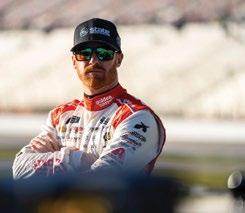
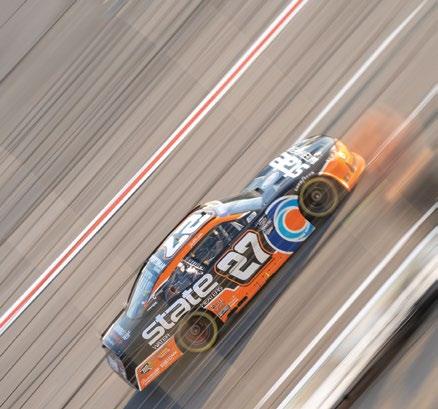
State Water Heaters is excited to partner with Jeb Burton on the race track and the whole Burton family on their outdoor TV show Crossroads with the Burtons. Just like Jeb Burton knows the value of high performing equipment on the track, we know the importance of high performing equipment in your home. Our ProLine® water heaters are designed to provide tough, commercialgrade performance that your family can rely on.
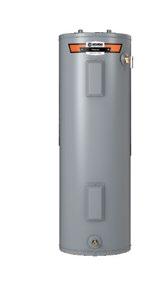
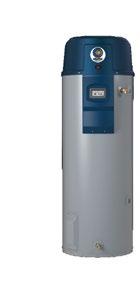

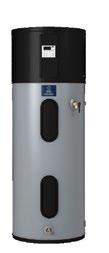
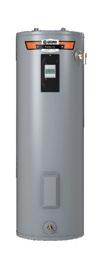





Shelby County Speedway in Harlan, Iowa, has a rich auto-racing history dating back to the 1940s. Originally a half-mile dirt track designed for horse racing, SCS was reconfigured to a onethird-mile, high-banked oval in 2022, infusing new energy into this historic venue.
SCS began as a horse-racing venue in the 1930s before transitioning to auto racing with jalopies. During the 1960s, banking was added to the turns in an effort to attract more competitors.
A prominent figure in SCS’s history is DeWayne “Tiny” Lund, the 1963 Daytona 500 winner, who hailed from Harlan, Iowa. Lund’s legacy is honored annually with the Tiny Lund
Memorial, a tradition spanning more than three decades.
After a brief closure between the 1960s and 1970s, the speedway reopened in the 1980s and has remained operational since.
The reconfiguration breathed new life into the speedway. Initially, some competitors were skeptical about the change. However, after experiencing the new layout, many acknowledged its benefits. With the new layout the pit area was moved from the inside of the track to the outside which gives the fans a more exciting experience seeing the full track.
“Since it’s been changed, all the naysayers have come back around and say it’s the best thing that’s ever happened,” said Gary Hopp, owner of Performance Grading, who played a pivotal role in the transformation.
The track now features two short straightaways flanked by 80-foot-wide, high-banked corners, providing fans with thrilling, closequarters racing.
SCS hosts a variety of racing events, including the Lucas Oil Late Model Dirt Series, which visited the track in July 2024. The weekly program features multiple divisions, such as IMCA Late Models, Sport Compacts, Northern Sport Modifieds and Stock Cars.
For fans who can’t make it to the track, select races are available for live streaming through racing broadcast platforms. Ticket information, event schedules and streaming details can be found on the speedway’s official website and social media pages.
LOCATION
Harlan, Iowa
NICKNAME
SCS
TRACK OPENED
1940s TRACK TYPE
High-banked oval
TRACK LENGTH
One-third mile
TRACK SURFACE Dirt
SEATING CAPACITY
4,000 FEATURED DIVISIONS IMCA Stock Cars, Hobby Stocks, Sport Compacts, Sport Mods, and Late Models.
LEGENDS OF THE TRACK
Tiny Lund KEY EVENT IN HISTORY
Reconfigured from a half-mile to a one-thirdmile track with new lighting in 2022.
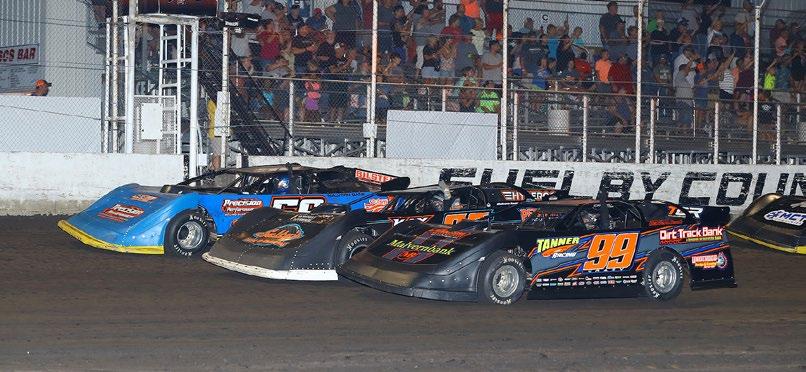

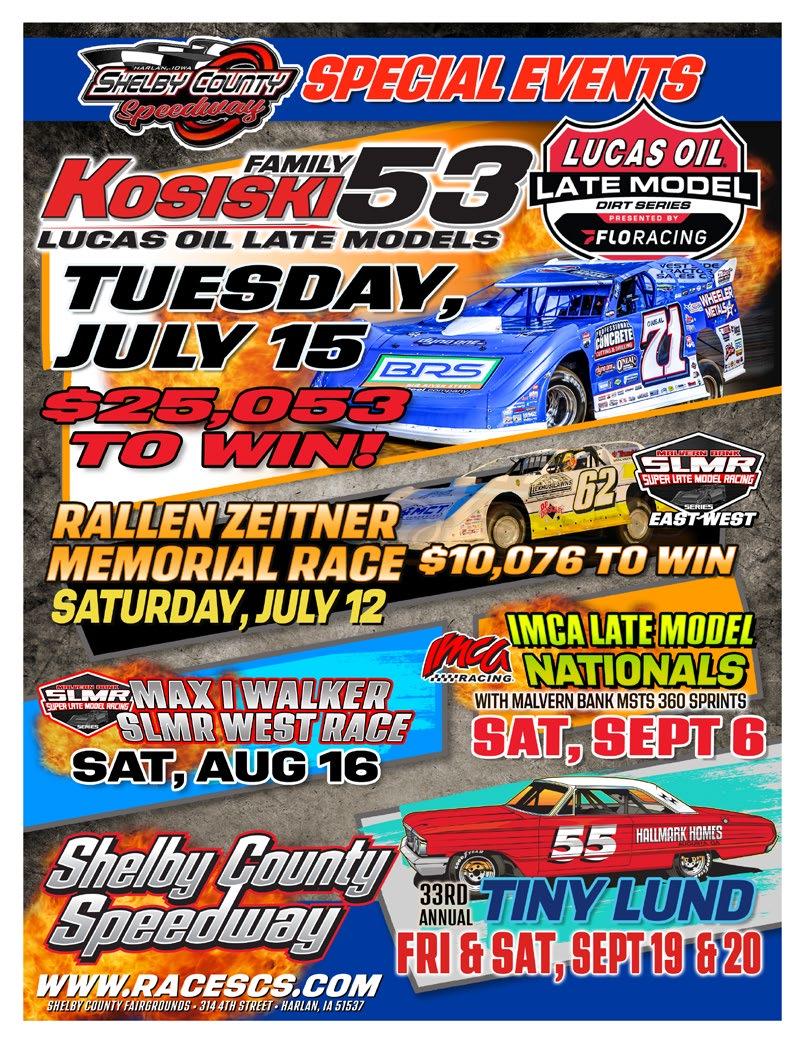
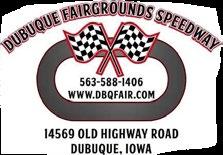
Centrally located near the Wisconsin-IowaIllinois border in the far eastern portion of the Hawkeye State is Dubuque County Fairgrounds Speedway – a fixture of the local short-track racing scene for more than five-and-a-half decades.
The Dubuque, Iowa, dirt track opened in 1968 and hosted its first full season in 1969. Hence the name, the speedway shares real estate with the Dubuque County Fairgrounds.
Established in 1953, the nonprofit Dubuque County Fair Association oversees a 96-acre property that serves as home to not just the speedway but an outdoor festival area and three rental facilities boasting a combined square footage of more than 32,000.
Although the speedway has been at the fairgrounds since the beginning, it hasn’t always been managed by the DCFA. In fact, over the years, the DCFA rented the clay oval out multiple times to different promoters.
But four years ago, the most recent promoter not associated with the DCFA moved on, leaving the track in the capable hands of four individuals who are connected to the DCFA.
Since these four people took over, the track has enjoyed a significant rise in average weekly attendance.
“We have a passion for racing,” promoter Kevin Kotz said. “We all love it. We’ve all been around it all of our lives.
“What we’re trying to do is make it really good not only for the racers – we want them to be happy because they’re the stars of the show –but we want to make sure when the kids come

in that we’re trying to keep the generations of race fans alive here. And, I think, that’s what’s helped us grow over the last four years.”
Unlike most local short tracks, Dubuque County Fairgrounds Speedway puts on a Sunday night show that begins at 5:30 local time. The goal is to start early enough for competitors and fans to be on the road and headed home by 9:30.
As for why the speedway is open on Sunday nights and not earlier in the weekend, it’s pretty simple, really: The promoters want to be mindful of the fact that weddings and other special events often take place at the fairgrounds on Fridays and Saturdays.
“We never felt it was fair to screw up a bride or groom’s day, so we decided on Sundays,” Kotz said.
In an effort to attract as many fans as possible, offering modestly priced tickets and an appealing menu is a top priority.
With this in mind, children 12 and under who are accompanied by an adult attend weekly events free of charge. Students ages 13-17 and senior citizens, meanwhile, can purchase a ticket at a discounted price.
“I think the biggest thing is we’ve made it family-friendly pricing, not only at the gate but at the food lines,” Kotz said. “Our goal is to make sure a family of four can come to the race and feed their kids and have some fun and watch the races for 40 bucks.”
The track’s various food options are headlined by burgers, fries, deep fried pork tenderloin and – most notably – its highly popular turkey and dressing sandwich, which consists of turkey and chicken mixed together with a homemade dressing and placed on a bun.
LOCATION
Dubuque, Iowa
NICKNAME
Dubuque Speedway TRACK OPENED 1968 TRACK TYPE Oval TRACK LENGTH
Threeeighths mile TRACK SURFACE Clay SEATING CAPACITY
7,500 FEATURED DIVISIONS IMCA Hobby Stocks, Late Models, Northern Sport Mods, Stock Cars and Modified classes.
LEGENDS OF THE TRACK Ed Sanger, Roger Dolan, Ron Barker and Gary Webb. KEY EVENT IN HISTORY The races held on Dubuque County Fair weekends.

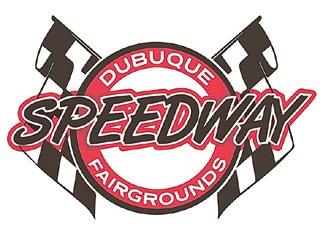
J U LY
J u ly 6 Wee k ly R a c i ng
J u ly 1 3 Wee k ly R a c i ng w it h
E i c h m a n’s K id s C lu b
J u ly 2 0 No R a ces
J u ly 2 3 Wed nesday Fai r R ace w ith: P r o L ate M od e l s , I M C A M od i fi ed , I M C A H o b b y S toc k , O pe n 4 C yl i n d e r, C r o w n Vic C l a ss
J u ly 2 7 Ju lien Du buq ue Classic w ith:
I M C A L ate M od e l , I M C A M od i fi ed , I M C A S po r t M od i fi ed , I M C A H o b b y
S toc k , I M C A S toc k C a r, O pe n 4
C yl i nd e r, C r o w n Vic C l a ss
No IMCA Late Models
J U N E
J u n e 1 Wee k ly R a c i ng w it h
E i c h m a n’s K i d s C lu b
J u n e 8 Wee k ly R a c i ng w it h
Fa n App r ec i at io n Night
F r ee G r a n d s ta n d Ad m i ssi o n
J u n e 1 5 P r o L ate M od e l s w it h : I M C A M od i fi ed ,
I M C A S po r t M od i fi ed , I M C A H o b b y
S toc k , I M C A S toc k C a r, O pe n 4
C yl i n d e r, C r o w n Vic C l a ss.
No IMCA Late Models
J u n e 2 2 Wee k ly R a c i ng
J u n e 2 9 P r o L ate M od e l s w it h : I M C A M od i fi ed , I M C A S po r t M od i fi ed , I M C A H o b b y
S toc k , I M C A S toc k C a r, O pe n 4
C yl i nd e r, C r o w n Vic C l a ss.
No IMCA Late Models
E i c h m a n’s K i d s C lu b
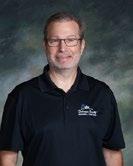
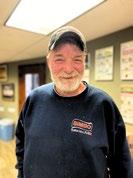
A U G U S T
Au g u s t 3 No R a ces
Au g u s t 1 0 Wee k ly R a c i ng
Au g u s t 17 Wee k ly R a c i ng w it h D r e w Coo k
B a c k to Sc h ool Night
Au g u s t 2 4 Season Cha mpionsh ip w ith: E i c h m a n’s K id s C lu b
T r ic k o r T r eat Night
Au g u s t 3 1 Season Championship Rain Date W E E K LY C L A S S E S
I M C A L at e M od e l , I M C A M od i fi e d , I M C
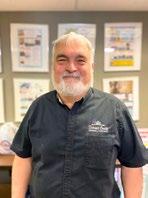










WORDS: ARMANY DEPAUL PHOTOGRAPHY: LAKESIDE SPEEDWAY
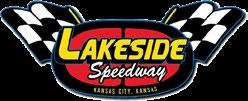

Located adjacent to the Missouri River in Kansas City, Kansas, it’s no wonder Lakeside Speedway’s catchphrase is “Racing on the River’s Edge.”
Opened in 1955, Lakeside has seen plenty of changes throughout its history. From switching surfaces – dirt, to asphalt, and back to dirt – to surviving a major flood, few tracks match the resilience and toughness of Lakeside Speedway.
Today, Lakeside Speedway is a four-tenthsmile, semi-banked dirt track, but that wasn’t always the case. In fact, the track wasn’t even always at its current location. From 1955 to 1988, Lakeside was a three-eighths-mile track located at 92nd and Leavenworth Road, about a 10-minute drive from where it stands today.
During that final season at the original site, developers for The Woodlands – a dog and horse racing venue – purchased the property, forcing Lakeside to relocate.
Lakeside did more than just change addresses. In 1989, the original three-eighths-mile dirt track was replaced with a new four-tenths-mile asphalt speedway that was sanctioned by NASCAR.
This layout was used from 1989 to 1999, before the track returned to its roots by ditching the asphalt for a dirt surface in 2000 – a surface it still uses to this day.

The number of names that have come and gone through Lakeside Speedway is vast. Terry Bivins made a name for himself in the 1960s and ’70s before relocating to North Carolina and assembling a limited NASCAR Cup Series effort. At 87 years old, he still shows up at the track and helps teams with their cars.
While winning races and championships in the NASCAR Weekly Series, Larry Phillips also etched his name into Lakeside lore during his racing career. In 2002, Lakeside Speedway was introduced to future 10-time Cup Series winner Clint Bowyer, who claimed the NASCAR Weekly Racing Series championship that season.
To manage a race track, one has to know the facility – and Ralph Palmer fits the bill. Now part of Lakeside’s management team, Palmer has seen the track evolve over the decades, from asphalt to dirt, even racing against drivers like Bowyer himself.
“I ran at the track when it was asphalt and when it was dirt as well,” said Palmer. “On asphalt everything’s gotta be right. If you’re loose on asphalt you’re liable to wreck the car. On dirt, you want to be loose to a point. It’s completely different the way you drive.”
Then there’s the owner, Don Barrs. Owner by day, driver by night: Barrs races in the Factory Stock, Vintage and B-Modified divisions at the speedway – at the age of 70. To avoid a conflict of interest, he stays hands-off with operations, entrusting Palmer to oversee the track’s day-to-day affairs.
In 1993, Lakeside Speedway faced its biggest challenge yet when the track was flooded and ended up 31 feet of water. The season was cut short, and many wondered if the track would ever return. But once the water receded, much of the track remained intact. With strong community support, Lakeside re-opened – and continues to thrive today.
Currently, the track hosts multiple divisions, including E-Modifieds, Factory Stocks, USRA Stock Cars and USRA B-Modifieds.
LOCATION
Kansas City, Kansas
NICKNAME
Racing on the River’s Edge TRACK OPENED 1955
TRACK TYPE
Semi-banked oval
TRACK LENGTH
Four-tenths mile
TRACK SURFACE
Dirt (1955 – 1988), Asphalt (1989 –1999) and Dirt (2000 –present).
SEATING CAPACITY
3,200 FEATURED DIVISIONS E-Modifieds, Factory Stocks, USRA Stock Cars and USRA B-Modifieds.
LEGENDS OF THE TRACK
Terry Bivins, Larry Phillips, Clint Bowyer, Don Barrs and Ralph Palmer.
KEY EVENT IN HISTORY
Surviving the 1993 flood.
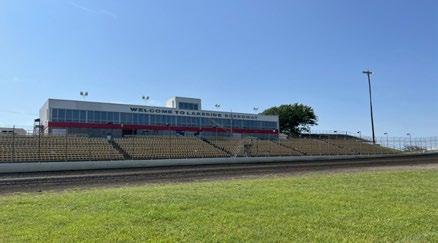



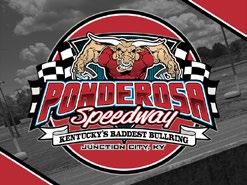
Home to some of the nation’s finest equestrian venues, Kentucky is known for its horse racing. But it’s a totally different type of horsepower that drives the competition at Ponderosa Speedway, “Kentucky’s Baddest Bullring.”
Located in Junction City, Kentucky, the threeeighths-mile, D-shaped dirt track sits near the geographic center of the state, making it an easily accessible destination for race fans from Louisville to Lexington.
Since opening in 1972, the track has been
a prominent player in Kentucky’s dirt-racing arena with fans regularly filling the 2,500-seat grandstand.
Through the years, Ponderosa Speedway has been a proving ground for both local talent and some of racing’s biggest names. Long before he was inducted into the NASCAR Hall of Fame, Tony Stewart was a young dirt racer turning laps at Ponderosa.
Today, fans hear names such as Ben Harmon, Dustin Linville, Jeff Watson, Logan Walls, Mike and Camaron Marlar, and Shane Irvin as they reverberate from the track’s PA system.
Ponderosa Speedway has a history of transforming young drivers into experienced racers.
Ponderosa Speedway’s upcoming season runs from April 11 to Oct 3 and will spotlight four divisions – Pro Late Models, Modifieds, Sprint Cars and Front-Wheel Drives. The Ohio Valley SCDRA Series, the American Sprint Car Tour, the Buckeye Outlaw Sprint Series and the Southern All Stars Series are all scheduled to visit the track for special events.
The 25th annual Junebug Memorial is set for July 31-Aug. 1. The Pro Late Model race boasts a $25,000 winner’s prize and pays $2,000 to start, making it one of the region’s richest dirt-track events.
Additional details about Ponderosa Speedway can be found at the track’s official online destination – ponderosaspeedway.net.
NICKNAME Kentucky’s Baddest Bullring TRACK OPENED 1972 TRACK TYPE D-shaped TRACK LENGTH
Three-eighths mile TRACK SURFACE Clay SEATING CAPACITY
2,500 FEATURED DIVISIONS
Pro Late Models, Sprint Cars, Hobby Stocks, Modifieds and Front-Wheel Drives.
LEGENDS OF THE TRACK
Jack McDonald, Don Gumke, Johnny C. KEY EVENT IN HISTORY
Mike Marlar charged forward from the 22nd starting spot to win the July 2023 World of Outlaws Late Model Series race at Ponderosa.
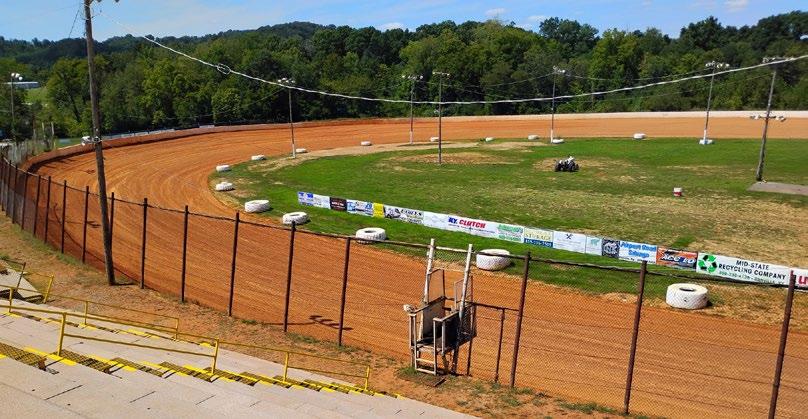


































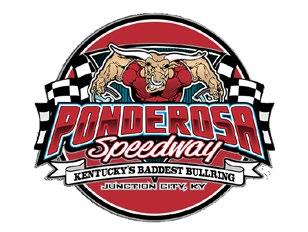









BROUGHT TO YOU BY the Fastest 3/8 Mile
APR. 11
Season Opener
APR. 18 Easter Enduro: Run Whatcha Brung
APR. 25 Spring Showdown Demolition Derby
MAY 2
Double Series Friday
MAY 9 Truck & Tractor Pull
MAY 16 Pro Late Model Special
MAY 23 Sprint Car Special
MAY 30
Crown Vic Special
JUN. 6 The Wreckoning Demolition Derby
JUN. 13
Bobby Carrier Memorial
JUN. 20 Open Wheel Modified Special
JUN. 27 OFF
JUL. 4
Fun Day at Ponderosa + FIREWORKS
JUL. 11 1st Annual Percentage Event
JUL. 18 Sprint Car Special
JUL. 25 Summer Bash Demolition Derby
JUL. 31 (Thurs.) Junebug Memorial (Night 1)
AUG. 1 Junebug Memorial (Night 2)
AUG. 8 OFF (North/South 100 - Florence)
AUG. 15
AUG. 22
AUG. 29
SEPT. 5




Super Stock Lottery
Super Late Models Return
End of Season Event
1st Annual Trailer Race
SEPT. 12 (Sat.) Car & Bike Show (11am–5pm)
SEPT. 19 Demolition Derby
SEPT. 26 Old School Racing
OCT. 3 Fan Appreciation Night

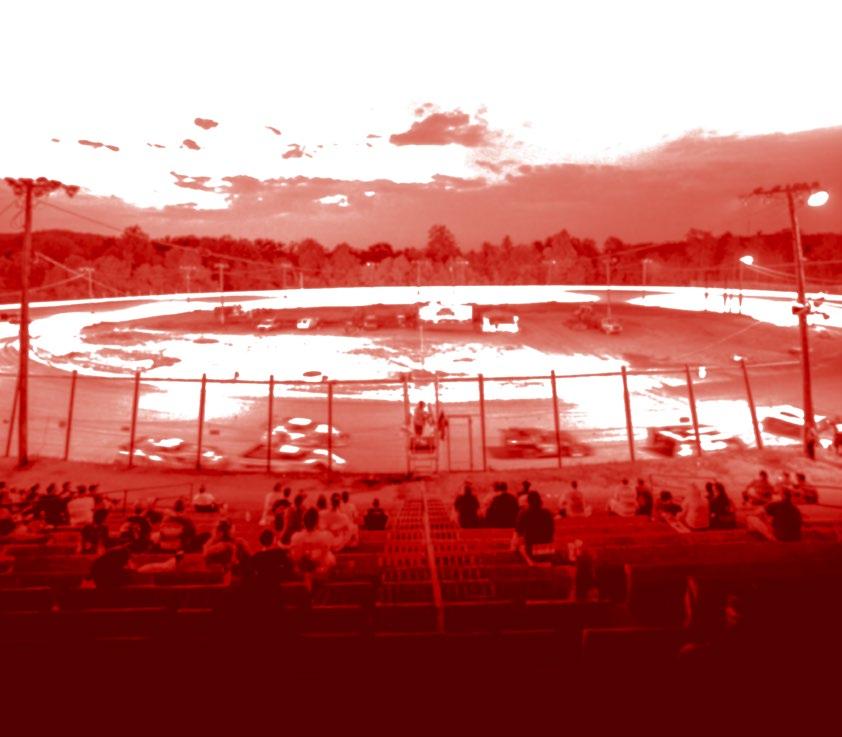
WORDS: CRAIG BARONCELLI
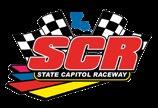
Located near Baton Rouge, State Capitol Raceway has been a fixture in Louisiana motorsports since 1968. Originally built as a drag strip, the facility later expanded to include a three-eighths-mile paved oval, bringing short-track racing to the region.
Over the years, the track has hosted a variety of grassroots racing events, drawing both experienced drivers and local competitors. Whether it’s Late Models, Modifieds or Street Stocks, the competition at State Capitol Raceway is known for being intense and unpredictable.
ENTERTAINING NEW ENGLAND RACE FANS
SINCE 1950
WORDS: KAUY OSTLIEN
As one of the Northeast’s premier motorsports facilities, a visit to iconic Oxford Plains Speedway provides a look at both the past and the future of short-track racing in New England.
Carved from 200 acres of woodland near Oxford, Maine, the speedway was a half-mile dirt track when it opened in May 1950.
Bob Bahre, a businessman, developer and entrepreneur, bought Oxford Plains Speedway in 1963. The racing surface eventually evolved into a threeeighths-mile configuration and was paved during the 1970s.
Under Bahre’s leadership, Oxford Plains became a hub for Late Model stock car racing. He continued to manage and promote the facility into the 1980s

State Capitol Raceway has a long-standing reputation as a challenging track where drivers test their skills. Home to divisions like Pro Stocks, Late Models and Modifieds, the track has been the site of memorable races and standout performances from local talent. Fans can expect a mix of experienced veterans and up-and-coming drivers battling for position. Throughout the season, the track hosts a variety of events, providing plenty of opportunities to see competitive racing in a closeknit environment.
One of the standout features of the track is its unique blend of asphalt. It causes racing conditions to change throughout the night, forcing drivers to adapt their strategies nearly every lap.
State Capitol Raceway’s action-packed schedule includes weekly racing and special events. Fans who are unable to visit the track can stream select races online through Speed51 and Racing America. For schedules, ticketing and event details, visit statecapitolraceway.com.
when he built New Hampshire Motor Speedway.
Oxford Plains is one of only a handful of active short tracks to have hosted multiple NASCAR national and regional series events, including visits by the NASCAR Cup Series (3) and the NASCAR Xfinity Series (5). It also served as the home track for the NASCAR North Tour and later the NASCAR Pro Series East.
The record books show that Maine racing legend Mike Rowe is the track’s leading Late Model feature winner with 153 visits to Victory Lane.
This year, the track’s schedule features a mix of weekly racing and special events. The Championship Series showcases eight divisions – Super Late Models, Limited Sportsmen, Street Stocks, Mad Bombers, Thunder Stocks, Cruisers, Runnin’ Rebels, and Rookies.
The annual Oxford 250 is track’s marquee event and the 52nd running of the Super Late Model spectacular is scheduled for Aug. 22-24. It will be sanctioned by the Pro All Stars Series and Jeff Taylor is the defending winner.
NICKNAME
Louisiana’s Fastest Short Track
TRACK OPENED 1968
TRACK TYPE
Oval
TRACK LENGTH
Three-eighths mile
TRACK SURFACE
Asphalt
SEATING CAPACITY
4,000
FEATURED DIVISIONS
Pro Stocks, Late Models, Modifieds, Street Stocks and more.

TRACK OPENED May 1950
TRACK TYPE Oval
TRACK LENGTH
Three-eighths mile TRACK SURFACE
Asphalt SEATING CAPACITY
14,000
FEATURED DIVISIONS
Super Late Models, Limited Sportsmen, Street Stocks, Mad Bombers, Thunder Stocks, Cruisers, Runnin’ Rebels and Rookies.
WORDS: JOSH MULL
For more than half a century, Hagerstown Speedway has been a centerpiece of dirt-track racing in the Mid-Atlantic. Located in Hagerstown, Maryland, this storied half-mile clay oval has earned a reputation as one of the fastest and most competitive dirt tracks in the country.
Known for its smooth racing surface and high speeds, the track has hosted some of the biggest names in dirt Late Model and Sprint Car racing. With a legacy built on thrilling competition and dedicated fans, Hagerstown Speedway remains a premier destination for dirt-racing enthusiasts.
Hagerstown Speedway features various racing divisions, including Super Late Models, Crate Late Models, Pure Stocks and Sprint Cars. The track’s
Nestled in Seekonk, Massachusetts, Seekonk Speedway has been a cornerstone of New England motorsports since its inaugural race on May 30, 1946. Founded by Dominic Anthony Venditti, this third-mile asphalt oval, affectionately dubbed “The Cement Palace,” has remained under the stewardship of the Venditti family, earning the distinction of being the nation’s longest continually operated family-owned race track. Through wars, economic shifts and evolving racing technology, the track has remained a constant in New England’s motorsports culture. From its early days of post-war stock car battles to modernday high-stakes racing, Seekonk has nurtured generations of racers and fans alike. Its ability to adapt while preserving its grassroots charm has cemented its status as one of the most iconic familyrun tracks in the country.
schedule includes marquee events for the Lucas Oil Late Model Dirt Series and the Ultimate Super Late Model Series, along with the Frank Sagi Tribute that honors a local racing legend.
Over the years, Hagerstown has also hosted major national dirt racing tours, drawing top-tier talent from across the country. Weekly racing programs ensure intense action, keeping fans engaged with some of the best dirt racing in the region.
Fans can visit Hagerstown Speedway’s website (hagerstownspeedway.com) for event schedules, ticket details and track information. Those unable to attend in person can stream select events live through FloRacing, the official streaming partner for many of Hagerstown Speedway’s premier races.
Additional race coverage, including highlights and special features, can also be found on DirtVision and the track’s social media channels. Stay connected via Facebook, Twitter (X), Instagram and YouTube for race updates, behind-the-scenes content and driver interviews.

City Oval
DIVISIONS Super Late Models, Crate Late Models, Pure Stocks, Sprint Cars and more.
Seekonk Speedway offers an array of racing divisions that cater to both drivers and fans alike. The NASCAR Advance Auto Parts Weekly Series runs on Saturday nights, featuring the Pro Stock, Late Model, Sportsman and Sport Truck divisions. These events provide edge-of-your-seat action and intense competition.
Additionally, the speedway’s Fast Friday Series serves as a proving ground for emerging talent, showcasing divisions such as Sport 4s, Pure Stocks, Legend Cars and the Seekonk Youth Racing Association.
Beyond weekly races, Seekonk hosts marquee events like Open Wheel Wednesday, which includes the prestigious Boston Louie Memorial for NEMA midgets, and a $10,000-to-win Modified race, attracting top-tier talent from across the region.
For those eager to experience the action, Seekonk Speedway’s website (seekonkspeedway.com) offers event schedules, ticket info and facility details. Fans can also catch races via streaming platforms, with broadcast details updated online.

NICKNAME The Cement Palace TRACK OPENED May 30, 1946 TRACK TYPE Semi-banked oval TRACK LENGTH
mile
Pro Stocks, Late Models, Sportsmen, Sport Trucks, Sport 4s, Pure Stocks and Legend Cars.
DIRT HAS BEEN I-96’S ONE CONSTANT SINCE 1971 WORDS:


The racing landscape in Michigan changed on Aug. 17, 1971, when I-96 Speedway was added to the Wolverine State’s roster of active motorsports facilities.
Located between Lansing and Grand Rapids in Lake Odessa, I-96 Speedway originally consisted of two race tracks and it became known as The Sprint Car Capital of Michigan. For several years, the facility’s open-wheel heavy schedule included numerous major races, often showcasing regional and national Sprint Car drivers.
I-96 Speedway has always had one constant: dirt. As current track owner Larry Curtiss puts it, “Everything’s always been dirt.”
But early on, the track doubled the fun – operating two configurations, including a challenging half-mile layout.
In 1991 one of the fastest features ever to be run on a half-mile track happened at I-96 as a 25-lap All Star Sprint feature lasted less than seven minutes
In 1975, I-96 strayed from its Sprint Car roots and hosted the Cavalcade of Champions, a Late Model race boasting a $10,000 winner’s check –massive money for the time. Doug Kenimer took home the five-figure prize.
Fast-forward to 1993 when the motorcycles of the Grand National Dirt Track Series returned after a two-decade absence. In 1988, I-96 made

history, becoming the first Michigan track to secure an IMCA sanction for its Modifieds – a distinction the track proudly holds to this day.
Over its 54-year history, I-96 Speedway has seen plenty of changes – but none more significant than the reconfiguration between 2013-2014. The half-mile track was retired, making way for the 4/10th, semi-banked oval that fans know today. When built, I-96 was 100 feet wide, and after the changes, it now averages 75 feet wide.
What truly elevates I-96 Speedway, however, are the drivers who’ve left their mark in the dirt. Local legends such as Jack Baes and Gary Bowerman remain part of the track’s folklore, alongside Artie Sommers and Frank Lamp, both of whom earned their place in I-96’s rich history. Bill Bray and Kris Patterson also cemented their status as track greats.
But I-96’s appeal has never stopped with local stars, as racing royalty from NASCAR and IndyCar have graced the speedway over the years. Johnny Benson Jr., Dick Trickle, Cale Yarborough, Tiny Lund, David Pearson and Tony Stewart – who famously flew in by helicopter – are among those who have lapped the Lake Odessa clay.
Today, I-96 Speedway continues to showcase some of the Midwest’s top series. Fans can regularly catch the Great Lakes Super Sprints and the revived All-Star Circuit of Champions Sprint Car Series is back on the schedule.
Regarding Late Model racing, the track faced a challenge – no series was available to fill the gap. So the track crew at I-96 did what racers do best: They built their own.
“On May 23, we have put together a big Late Model show that is $7,500 to win,” shared Mike Betts, part of the track’s management team. The event aligns perfectly with the American Late Model Iron-Man Series, which runs the same week.
LOCATION
Lake Odessa, Michigan
NICKNAME
Formerly The Sprint Car Capital of Michigan
TRACK OPENED
Aug. 17, 1971
TRACK TYPE
Semi-banked oval
TRACK LENGTH
Four-tenths mile TRACK SURFACE Clay SEATING CAPACITY
5,500
FEATURED DIVISIONS
UMP Late Models, IMCA Modifieds, Pro Stocks, Street Stocks, Compacts and Mini Wedges.
LEGENDS OF THE TRACK
Bill Bray, Kris Patterson, Johnny Benson Jr., Dick Trickle, Cale Yarborough, Tiny Lund, David Pearson and Tony Stewart.
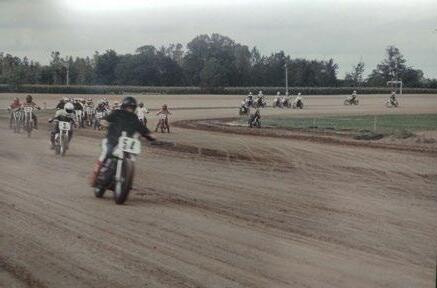
KEY EVENT IN HISTORY
The racing surface was shortened from a half mile to a fourtenths mile, semi-banked oval.




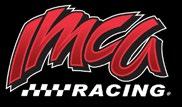
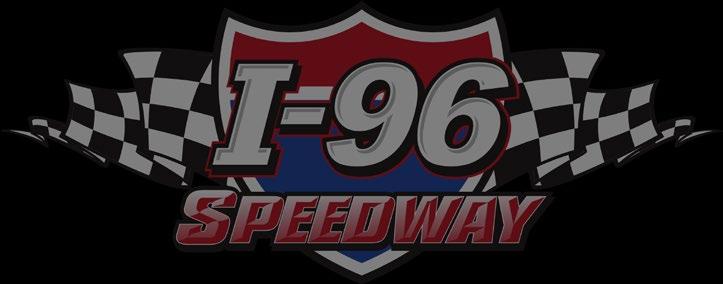


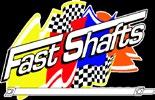







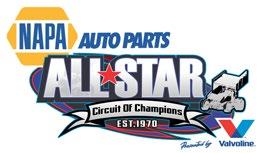
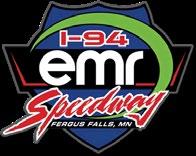

Located in Fergus Falls, Minnesota, I-94 Speedway began life in 1955. Built as a small-town dirt track to spotlight local racers, the speedway quickly became a gathering place for participants in the area’s grassroots racing scene.
Over time, the three-eighths-mile oval became known as a “racer’s track,” as a pit area packed with dedicated competitors entertained a large and loyal fan base.
The track’s racing surface was switched to asphalt in June 1994, literally paving the way for the Late Models of the ARTGO Challenge Series to race for the Minnesota Governor’s Cup.
Steve Carlson, a five-time NASCAR Midwest Tour champion from West Salem, Wisconsin, topped the 100-lap race on Sept. 11, 1994.
I-94 Speedway operated as a paved track until 2008 when it returned to its dirt roots. This led to a relationship with the WISSOTA sanctioning body – a partnership that helped solidify I-94 Speedway as a key stop on the WISSOTA tour, consistently drawing hundreds of race cars and thousands of fans.
A night of racing at I-94 Speedway offers fans an experience unlike any other. The recently

updated facilities are second to none, and the ontrack product is just as impressive – consistently delivering competitive, edge-of-your-seat action.
Each weekend, local talent lines up against seasoned veterans and touring regulars from the WISSOTA circuit. And with a 7 p.m. green flag, fans can beat the summer heat, as the sun sets, the air cools, the cars get faster and the action intensifies.
Come early October, I-94 Speedway will shake off the brisk chill of fall with the Gopher State Showdown. Now entering its third year, this annual event is the final opportunity for racers to earn points toward the WISSOTA Auto Racing National Championship.
With racing from Thursday through Saturday night, the Gopher State Showdown features a massive lineup of nine divisions: Late Models, Modifieds, Super Stocks, Midwest Modifieds, Street Stocks, Mod Fours, GenX Late Models, Legend Cars and Hornets.
The event consistently draws some of the nation’s best drivers, each chasing one last visit to Victory Lane before the season ends. This year, the Gopher State Showdown will run Oct. 9-11, and fans are encouraged to purchase tickets early for this can’t-miss weekend of racing action.
Carved from the roots of midwestern dirt-track racing, I-94 Speedway has earned a place in the hearts of fans and racers alike – both locally and nationally. From its rich racing history to the beautiful sunsets that accent the on-track action, it’s a place where memories are made.
With high-speed straightaways and steeply banked corners, I-94 is a bucket-list destination for any dirt-track racer.
And a Saturday night under the lights at I-94 –surrounded by the roar of racing engines, the scent of race fuel and the energy generated by a grandstand full of enthusiastic race fans – is something that lives on long after the final checkered flag.
LOCATION
Fergus Falls, Minnesota
NICKNAME
The Fast Track TRACK OPENED 1955 TRACK TYPE
Banked oval TRACK LENGTH
Three-eighths mile TRACK SURFACE Dirt SEATING CAPACITY
4,000 FEATURED DIVISIONS WISSOTAsanctioned classes –Late Models, Modifieds, Midwest Modifieds, Street Stocks, Super Stocks and Short Trackers.
LEGENDS OF THE TRACK
Steve Carlson, Tim Johnson, Matt Kenseth and Travis Sauter.
KEY EVENT IN HISTORY Introduction of the Gopher State Showdown, which ends the track’s season each October.

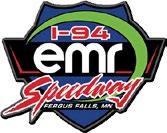
DATE EVENT
Apr. 25 Opener
SUPER, STREET, MWM, GX, MOD, LM, HORNET
May 2 Regular Race
May 9

STREET, MWM, GX, MOD, LM, HORNET
Structural Buildings Challenge Series
STREET, MWM, MOD, LM, HORNET
May 16 Regular Race
STREET, MWM, GX, MOD, LM, HORNET
May 23 Military Appreciation Night
STREET, MWM, GX, LM, HORNET
May 30 NO RACING
Jun. 6
Prelude to Dick Johanneck King of Dirt
Multiple Classes
Jun. 7 King of Dirt + Kids Night
Includes NLRA LM
Jun. 13 NO RACING
Jun. 20 NLRA Late Models
MWM, GX, MOD, LM, HORNET
Jun. 26 World of Outlaws Late Models
STREET, MWM
Jun. 27 NO RACING
Jul. 4 Fireworks & $10 GA
Jul. 11
STREET, MWM, GX, MOD, LM, HORNET
Driver Meet & Greet
STREET, MWM, GX, MOD, LM, HORNET
Jul. 18 NO RACING
Jul. 25 NO RACING
Aug. 1 Gen X Late Model Special + Vintage Cars
STREET, MWM, GX, HORNET
Aug. 8 Back to School Giveaway
MWM, GX, MOD, LM, HORNET
Aug. 15 Bob Gierke Memorial
STREET, MWM, GX, MOD, HORNET
Aug. 16 Rain Date Only (No LM)
Aug. 22 Regular Race
Aug. 29
STREET, MWM, GX, MOD, LM, HORNET
Season Championship
STREET, MWM, GX, MOD, LM, HORNET
SPECIAL EVENTS AFTER MAIN SEASON
Sept. 9–13: Speedway Motors Wissota 100 Oct. 9–11: Gopher State Showdown

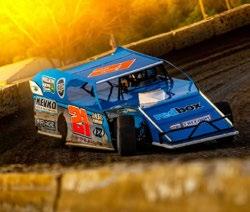
Fifteen miles south of Rochester, Minnesota, sits historic Deer Creek Speedway.
The three-eighths-mile, high-banked clay oval is widely recognized as a state-of-the-art motorsports facility and each season it hosts several regional and national touring series events.
Since 2002, the track has been owned and operated by the Queensland family, and they have focused on providing close-quarters racing in an environment that puts an emphasis on family entertainment.
For Deer Creek Speedway and the Queensland family, the attention is in the details – as it’s the little things that make the entire operation run smoothly.
Deer Creek Speedway was built in 1996 and the Queensland family purchased the facility in 2002. Since that time, they have overseen various track renovations, including a complete redesign and reshaping in 2003. That work transformed the track into the beloved highbanked bullring it is today.
Under the Queensland family’s leadership, the track has received several honors. In 2004, the facility was awarded the WISSOTA Track of the Year Award. Four years later, the family

opened a smaller sister track named Button Buck Speedway where the Slingshots race.
During their tenure, the family has received multiple Promoter of the Year awards, the highest honor of which was for the World of Outlaws Late Model Series event in 2009.
The track hosts, on average, 30 events per year and can accommodate as many as 40. The weekly racing is sanctioned by USRA, and various divisions under its umbrella are typically showcased. USRA sanctions races for the B-Mod, Modified, Stock Car and Hobby Stock divisions. Occasionally, the track also presents races sanctioned by the United States Modified Touring Series, a Midwest-based touring series that stretches as far south as Texas and Louisiana.
The track’s marquee races are sanctioned by the World of Outlaws. This year, the World of Outlaws Late Model Series competitors are in town for a three-day event during the July 4 weekend, while the World of Outlaws Sprint Car Series will battle on Thursday night, July 10.
Deer Creek Speedway puts a strong emphasis on the fan experience. As one might expect, the track is up to date and boasts a state-of-the-art press box and VIP booths. In fact, there are 24 VIP suites and 36 VIP decks, which ups the total seating capacity to 8,000 spectators. And for fans looking for a little more excitement, the Pepsi Fan Zone and Party Deck, built in 2012, offers just that.
Though the racing season ends in October, the action doesn’t stop. During the offseason, fans can attend a variety of events, including local racing banquets, car shows, trade shows, vacation shows and more.
LOCATION
Spring Valley, Minnesota
TRACK OPENED 1996 TRACK TYPE Oval TRACK LENGTH
Three-eighths mile
TRACK SURFACE Clay SEATING CAPACITY
8,000 FEATURED DIVISIONS
USRA B-Mods, Modifieds, Stock Cars, Hobby Stocks, USMTS Modifieds, SLMR Late Models and World of Outlaws Late Model Series.
LEGENDS OF THE TRACK Kraig Kinser, Joey Saldana, Brandon Sheppard and Bobby Pierce.
KEY EVENT IN HISTORY

Deer Creek Speedway began hosting the NAPA Gopher 50 Late Model race in 2005.
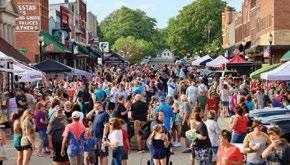
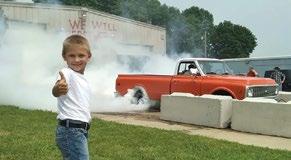



This 100-mile bike race starts Downtown Spring Valley and ends at Willow Park. Activities will take place afterwards downtown and include music, craft beer, food, games for the kids & other events.
Third Wednesday (through Sept) is Spring Valley’s Summer Market...with a Block Party Feel! Farmers market, vendors, live music, food, drinks, fun for the family!
Family friendly Community event at Good Earth Village featuring Live Music, Color Trail Run, Vendor Market, Food Trucks, Family Fun Zone, Wagon rides, Sunday morning outdoor worship. https://goodearthvillage.org/goodstock
Featuring International Harvester Tractors and Equipment, rootrivershow.org
Car Show, Bikes, Pinups, Grass Drags, Burnouts, Cratebox Derby, Drive-in Movie, Live Music and much more. For more info check out Fins and Films Facebook page.
Spring Valley farmers played an essential role in developing area land into our most important industry. We celebrate them during Ag Days with fun for the whole family, including Cruise Night, Bands, Softball, Volleyball, Parade, Little Huskers 1K, Street Dance, Fireworks, Tractor Show & Pull, Cocktail & Bloody Mary Contest, Bean Bags, Fishing Contest, BCT Play & more. FB: Spring Valley Ag Days
Spring Valley’s Wednesday’s on Broadway will hold their second annual Oktoberfest on Broadway. It is a family event with music, vendors, food, drink and games.
Supper with Santa, children’s play, bake sale, cookie decorating and a craft show followed by a light parade in the evening. Family fun for everyone!
1-888-254-6835 www.springvalleyinnsuites.com. Located on a National Scenic Byway, Spring Valley Inn and Suites is just 27 miles from Rochester and the Mayo Clinic- close enough to be convenient, with the charm of a small town.
Located by bike trail and trout stream, past trout farm on Cty. Rd. 8. Thirteen sites including electric. 507-346-7367
Late Model, Super Stocks, Midwest Mods and Street Stocks race every Saturday night on the high banked 3/8 dirt oval track, located west of Spring Valley on U.S. Hwy 63. www.deercreekspeedway.com For camping call 507-346-2342.


WORDS: JOSH MULL

Tucked into the pine-covered hills of Meridian, Mississippi, Whynot Motorsports Park has been delivering gritty, side-by-side dirt racing for decades. Known as “The House of Hook,” this three-tenthsmile, high-banked clay oval is a favorite among dirtracing fans across the South.
Since opening in 1998, Whynot has maintained its status as one of the top dirt tracks in Mississippi, hosting both local classes and major touring series. The red clay, passionate fan base and no-nonsense
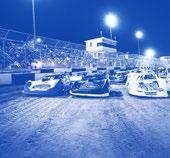
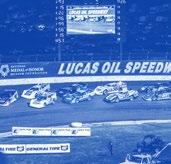
atmosphere make every Saturday night at Whynot feel like a big event.
Whynot Motorsports Park runs a strong lineup of divisions, including Late Models, Street Stocks, Factory Stocks, CRUSA Sportsmen and more. The track has become a go-to stop for the Comp Cams Super Dirt Series, Southern All Stars and other regional tours.
Its high banks and slick clay surface challenge even the best drivers, making for unpredictable and exciting racing. Generations of Mississippi racers have cut their teeth here, and the facility has played a key role in keeping grassroots dirt racing alive and well in the region.
Racing at Whynot usually takes place on Saturday nights during the regular season. Fans can attend in person for an up-close look at the action, or catch select races online via RacingDirt.com. For ticket info, race schedules and event updates, visit whynotmotorsportspark.com.
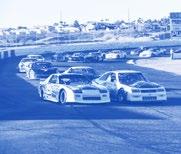
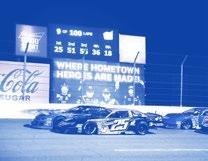
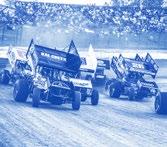

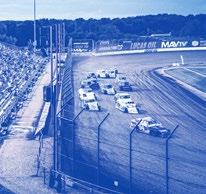
NICKNAME
of
Three-tenths mile
3,000
FEATURED DIVISIONS
Late Models, Street Stocks, Factory Stocks, CRUSA Sportsmen and more.

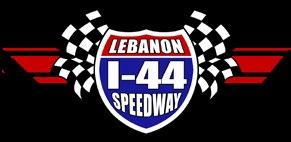
Located along historic Route 66 in Lebanon, Missouri, Lebanon I-44 Speedway is unique in that it’s had multiple stints with both dirt and asphalt racing surfaces. Currently, it’s the only active paved race track in the state.
With its turns banked at more than 20 degrees, the three-eighths-mile oval presents a formidable challenge to even the most seasoned short-track racers. The facility also includes a one-fifth-mile
interior oval so drivers with less experience can hone their skills.
Racing at I-44 offers a wide range of divisions, including Bandoleros, Chargers, Crown Vics, Radio Flyers, Street Stocks and Late Models. The Radio Flyers division is specifically for children and is part of the track’s broader effort to engage young fans. Events like bike races and water balloon fights add a family-friendly atmosphere to race nights.
Special events also dot the schedule. The Baby Grand National series will make an appearance in August, while the American Big Rig Series rolls into town in September – each bringing its own brand of spectacle to the high banks.
Beyond racing, Lebanon I-44 provides a unique short-track tailgating experience. While the grandstands seat 2,500 fans, the track also offers tiered tailgate parking – known as the “Wild Side” – with space for 160 to 175 vehicles. It’s one of the most distinctive ways to view the action.
From its racing pedigree to its welcoming atmosphere, Lebanon I-44 Speedway is a true gem in the short-track landscape of the Midwest.
NICKNAME
The High Banks TRACK OPENED 1983 TRACK TYPE
High-banked oval TRACK LENGTH
Three-eighthsmile exterior and one-fifth-mile interior
TRACK SURFACE
Asphalt SEATING CAPACITY
2,500
FEATURED DIVISIONS
Late Models, Street Stocks, Bandoleros, Chargers, Crown Vics and Radio Flyers.


WORDS:

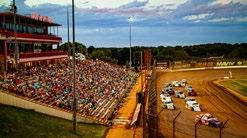
Tucked away in the tiny town of Wheatland, Missouri, is Lucas Oil Speedway, a threeeighths-mile clay oval. It’s about an hour from Springfield – the nearest city of any size. But don’t let the race track’s rural location fool you.
Lucas Oil Speedway and the property it sits on have more bells and whistles than most people would ever expect from a venue that even its promoter and general manager, Danny Lorton, admits is “kind of dead smack out in the middle of Missouri.”
Built by Ron and Mary Jenkins, the track was known as Wheatland Raceway when it opened in 2001. Sweeping changes came to the facility in late 2004, however, when Forrest and Charlotte Lucas – the founders of Lucas Oil Products – added the property to their portfolio of autoracing businesses.
Following a lengthy, multi-million-dollar renovation, the track reopened as Lucas Oil Speedway in 2006 with a new grandstand complex featuring 21 luxury VIP suites. Also new was a gift shop and a paved pit area. The current owners have also added a campground, a drag boat lake and an off-road track on the same property.
“It’s turned into more of a multi-motorsports complex instead of just the dirt track itself,” said Lorton, who assumed his role as promoter and general manager in 2016.

The Lucas Oil Speedway campground now features more than 170 individual campsites and 40 acres of dry camping area.
“It’s like we have our own little city out there,” Lorton said.
The dirt track boasts enough paved pit area to accommodate more than 200 cars, and there’s an overflow space just in case extra room is needed.
“Back when I raced here, it was called Wheatland Raceway, and I came through here on a Modified Touring Series and just literally, your pits, you pitted right up next to a bean field,” Lorton said. “That’s how much it’s changed over the years since they bought it. Now it’s just an all-paved pit area with a car wash, a parts store, Sunoco fuel tanks, the whole nine yards.”
Lucas Oil Speedway’s five weekly divisions –Limited Late Model Dirt, Super Stocks, Stock Cars, B-Mods and Modifieds – compete at the track 10 weekends between March and October.
General admission tickets for these events are just $5, with ticket prices for special events typically ranging from $15 to $35.
Lucas Oil Speedway is as known for its diverse food selection as it is for the racing. The menu includes chicken tinga, brisket, burgers, hot dogs, cheese curds, tenderloin, pizza, fries and fried pickles.
There’s also the more traditional pickle, which has become quite a hit among track regulars.
“Our marquee menu item that we seem to be getting pretty famous for is our chicken tinga and, believe it or not, we’re famous for our pickles,” Lorton said. “They’re more like a deli-style pickle. They’re pretty good.
“We tried downsizing them one time and, man, we got hammered. Everybody didn’t like the pickles we substituted with, so we had to go back to our famous pickles. We sell them by container for like two bucks. It’s crazy to be known for a pickle.”
LOCATION
Wheatland, Missouri
NICKNAME
Diamond of Dirt Tracks
TRACK OPENED 2001
TRACK TYPE
Semi-banked oval
TRACK LENGTH
Three-eighths mile
TRACK SURFACE Clay SEATING CAPACITY
8,000+ FEATURED DIVISIONS
Limited Late Model Dirt, Super Stocks, Stock Cars, B-Mods, Modifieds, Lucas Oil Late Model Dirt Series and High Limit Racing Series.
LEGENDS OF THE TRACK Scott Bloomquist, Tony Stewart, Terry Phillips, Earl Pearson Jr., Kenny Wallace and Ken Schrader.

KEY EVENT IN HISTORY
The purchase of the track by Forrest and Charlotte Lucas in 2004.





Mission Valley Super Oval in Polson, Montana, is one of the nation’s most unique short tracks. The paved three-eighths-mile course is a true triangle, somewhat reminiscent of the nowdefunct Nazareth Speedway in Pennsylvania.
The wide frontstretch produces plenty of passing while the tight corners and bowed backstretch challenge even the most veteran competitors.
In 2018, Tony and CleAnn Undem spearheaded an effort to save the struggling motorsports facility.
“This track was on the verge of shutting down,” said Tony Undem. “I was racing and didn’t want to lose it. I went to Corey White Sr. and said if we’re going to take this on, I’m going to need some help. Together, we approached Bob Lulow, Guy Stinger and a few others who had been involved in running the track years ago.”
Community members such as Lulow and longtime flagman Guy Stinger have played crucial roles in the track’s continued success.
“We wouldn’t be here without the local support,” Undem emphasized.
In addition, the entire Undem family is involved – sons, daughter-in-law, sisters, brothersin-law, nephews, nieces and granddaughters – all working alongside a dedicated group of friends to keep the track thriving.
The track’s marquee event is the Montana 200. Previously run as the Montana 200 at Montana Raceway Park, the event found a new home when that track closed in 2019. Mission Valley officials stepped up to preserve the storied tradition – and the name.
The track also hosts, with help from Travis and Amanda Sharpe in collaboration with

Racing Dynamiks, the five-race Montana Big 5 Super Late Series, which features drivers from across the country and Canada.
“We are happy to have SRL join us in the Big 5 this year. Their assistance in officiating will be a great addition,” Undem said.
Drivers from across the country will descend upon the track to test their skills against its unique layout during the 34th running of the Montana 200 on July 11-12.
Mission Valley also showcases other racing series, including Hobby Stocks, INEX Legends, and Mod’4’s, all of which showcase the talents of many local drivers. Hornets are also available for beginning drivers just starting to cut their teeth.
This year, the track will feature the USA Late Model Series in cooperation with the South Sound Speedway in Washington State. Travis Sharpe has worked tirelessly to create the USA Late Model Series in an effort to build the local late model scene.
“It’s our goal to maintain an affordable class with great competition while building our local late model class,” said Undem.
The track is also looking forward to hosting an SRL (Southwest Racing League) late model race on Sept. 6. They will have teams coming from all over the southwestern United States to participate in the event.
The track’s 2025 schedule runs from May 17 to Sept. 13. It’s available by visiting missionvalleysuperoval.com.
Since taking over, the Undem family has made significant improvements to the facility, including upgraded paving in the pits, improved LED lighting, grandstands, an expanded concession stand and renovated restrooms. The addition of a new beer booth and two VIP decks – each seating up to 62 people – has enhanced the spectator experience. A third VIP deck was to be added this spring.
While visiting the concession stand, we recommend the track’s signature Charburger, which is seasoned to perfection. It’s a must-try for any visitor.
NASCAR Xfinity Series drivers Jesse Love and Daniel Dye have raced at the Mission Valley Super Oval in the past. Love, who made his Cup debut at Bristol this year, was the champion of the track’s 2024 Wildfire 125.
One of the biggest local names to race at Mission Valley is NWSCRA Hall of Famer Cory Wolf. A legend in Montana racing, Wolf won the Montana 200 in 1992 and still competes on a part-time basis, often making appearances at Mission Valley Super Oval.
LOCATION
Polson, Montana TRACK OPENED 1996 TRACK TYPE
Triangular TRACK LENGTH
Three-eighths mile TRACK SURFACE
Asphalt SEATING CAPACITY
Approximately 3,500 FEATURED DIVISIONS
Hobby Stocks, Legend Cars, Mod 4s, Hornets, MT Big 5 Super Late Models and USA Late Models.
LEGENDS OF THE TRACK
Cory Wolf KEY EVENT IN HISTORY
The transition of the Montana 200 to Mission Valley Super Oval after Montana Raceway Park closed in 2019.
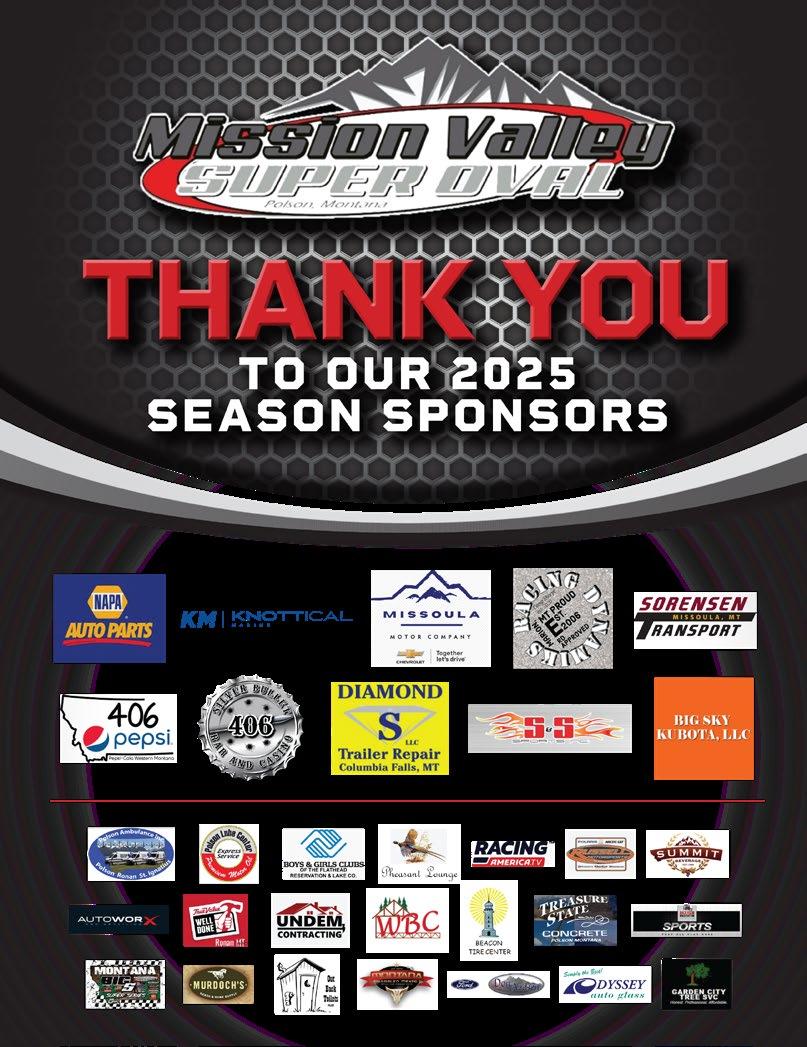
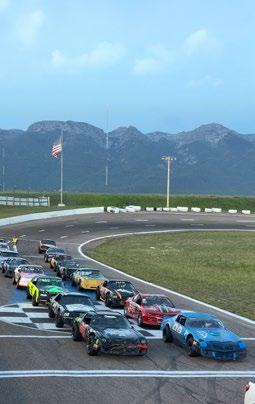
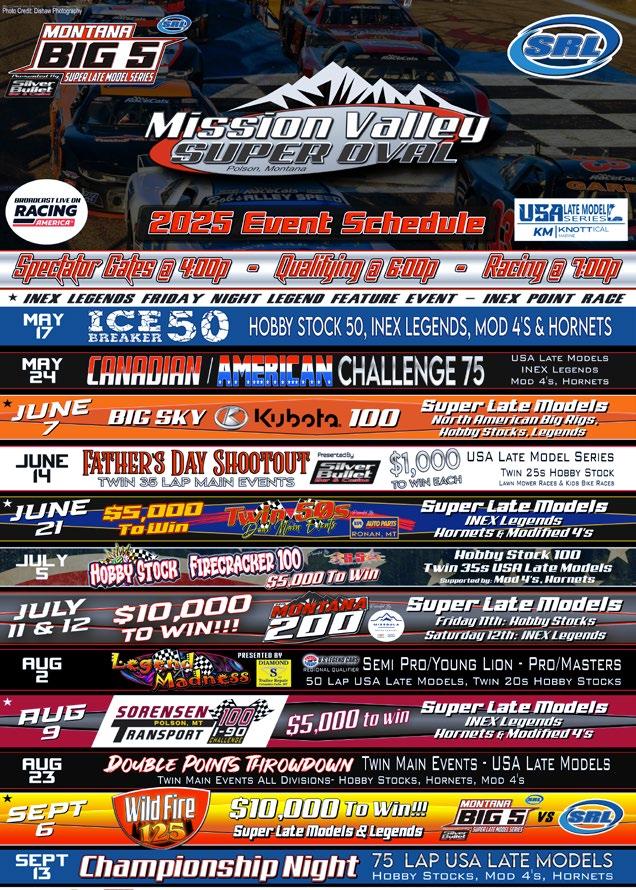
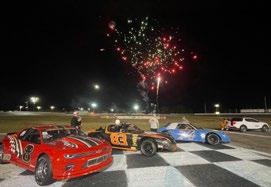
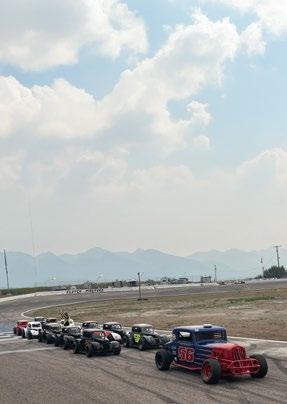

EAGLE
WORDS: KAUY OSTLIEN
Eagle Raceway’s story began in 1963 when Dale Halvorsen and Harvey Kropp carved a one-third-mile dirt oval into Halvorsen’s farmland in Cass County, Nebraska. Kropp became the promoter, and the track—just 15 miles east of Lincoln—quickly emerged as a hotspot for openwheel racing throughout the 1960s and ’70s.
After a brief closure from 1976 to 1978, the facility was revived by Paul Saenz, who introduced a weekly Late Model Stock Car series. In 1984, John Beecham, his wife Laura, and brother Marty purchased the track, making several improvements including a new concession stand and VIP area, while expanding the race schedule.
In 1997, Craig Cormack and Dean Orth acquired the track under Eagle Entertainment, LLC. By 1999, Cormack had taken full control and further upgraded the venue, adding nearly 2,000 seats and even incorporating unique entertainment events like professional wrestling.
The upgrades sparked a fresh era of racing. Eagle
hosted Friday night Winged Sprint Cars and Saturday NASCAR-sanctioned Stock Cars. In 1985, the schedules flipped and IMCA Modifieds were added.
In 1987, the Midsummer Midget Classic launched. Four-time NASCAR champion Jeff Gordon won the inaugural race in 1990, while Tony Stewart followed with a win in 1994, adding prestige to the track’s history.
Former Late Model driver Roger Hadan bought the track in 2006. In 2013, he partnered with RaceSaver Sprint Car founder French Grimes and IMCA to sanction the Sprint Car division under the RaceSaver 305 Rule Package—reducing costs and expanding opportunities for new racers.
Eagle’s dedication to grassroots racing continued with the creation of Mini E Raceway in 2011—a go-kart track within the infield. Many Mini E drivers have moved up to race on the main track.
“Since 2006, Eagle Raceway has worked to deliver more than just racing,” said track promoter Racine Thompson. “From School Bus Races to Firehose Rodeos, we offer something wild every night.”
In 2010, the track added a haunted house with three unique attractions—proving Eagle Raceway delivers excitement well beyond the checkered flag.

NICKNAME
America’s Home Track
TRACK OPENED 1963
TRACK TYPE
High-banked oval
TRACK LENGTH
One-third mile
TRACK SURFACE Clay
SEATING CAPACITY
8,800 FEATURED DIVISIONS
IMCA Modifieds, IMCA SportMods, IMCA Hobby Stocks and IMCA Stock Cars.



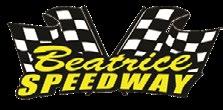
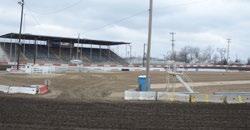
In the early 1950s, officials of Gage County, Nebraska, traded their aging fairgrounds race track for something bolder: a new, highbanked, three-eighths-mile clay oval – Beatrice Speedway. Originally known as Gage County Speedway, this iconic venue quickly became the heartbeat of Nebraska’s dirt-racing scene.
Every Friday night, some of the best IMCA drivers in the nation battle it out here, showcasing raw speed, sharp skills and the kind of noholds-barred competition that puts both man and machine to the ultimate test.
If it’s Friday night in Nebraska, the place to be is Beatrice Speedway. This dirt track is home to thrilling IMCA-sanctioned racing across a full slate of classes – Modifieds, Sport Modifieds, Stock Cars, Hobby Stocks and Sport Compacts –all chasing points, pride and podiums.
The action fires up early with the legendary Spring Nationals in March, and from there, it’s a weekly sprint to glory that stretches through October. Along the way, Beatrice throws open its gates for marquee events like the Gage County Fair races, which blend fast cars with family fun.
Gates open at 6 p.m., hot laps hit at 7 p.m., and by 7:30 p.m., engines roar and the dirt flies. It’s a recipe for edge-of-your-seat excitement – close racing, hard battles and those unforgettable Friday nights that keep fans coming back.
History isn’t just remembered at Beatrice Speedway – it’s celebrated. The Beatrice

Speedway Hall of Fame stands as a tribute to the racers, builders and dreamers who helped carve the track’s legacy into Nebraska’s racing soul.
Names like Joe Wade, Keith Highshoe, Johnny Saathoff and Jordan Grabouski shine inside these hallowed halls, honoring those who gave their all under the lights of Beatrice. But the Hall of Fame isn’t just about looking back. Through events like the annual Daytona 500 Party – packed with auctions, raffles and racing spirit – it gives back to the community that fuels it.
Proceeds from these events help support programs like the Women for Racing Group, a vital force that keeps fan interest high and racing families connected. In Beatrice, the past isn’t forgotten – it’s alive, inspiring every new lap turned under the Nebraska sky.
LOCATION
Beatrice, Nebraska
NICKNAME
Best of the Midwest TRACK OPENED 1952
TRACK TYPE
High-banked oval
TRACK LENGTH
When Beatrice Speedway kicks off or closes out a season, they don’t just race – they throw a party on dirt.
The Spring Nationals, run every March, sets the tone. Friday night heats ignite the weekend, while Saturday night’s main events bring the energy to a boil. The Modified division leads the charge, but every class turns up the intensity for the chance to etch their names into Beatrice lore.
Got an RV? Perfect – campers are welcome on the fairgrounds, with hookups available for those wanting a front-row seat to the action all weekend long.
And when autumn rolls around, it’s time for Octoberfest – a two-night dirt track showdown that pulls the best IMCA racers from across the country. Fierce fields, packed grandstands and championship-caliber racing define the season’s grand finale.
Can’t make it? No problem the whole show is streamed live on IMCA.tv, bringing Beatrice’s biggest weekend straight to your screen.
With events like these anchoring the calendar, Beatrice Speedway doesn’t just run races – it delivers unforgettable memories, season after season.
Threeeighths mile TRACK SURFACE
Clay (silty loam)
FEATURED DIVISIONS
IMCA Modifieds, IMCA Sunoco Stock Cars, IMCA Sunoco Hobby Stocks, IMCA Northern SportMods and Mach-1 IMCA Sport Compacts.
LEGENDS OF THE TRACK
Jordan Grabouski, Johnny Saathoff, Ray Lipsey, Rex Nunn and “Speedy” Bill Smith.
KEY EVENT IN HISTORY
Introduction of the Spring Nationals.
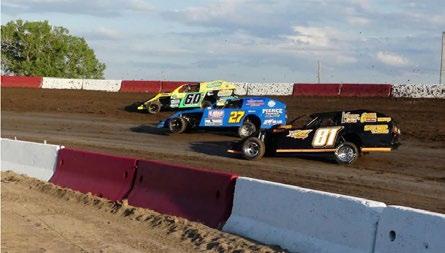






WORDS: JARED TURNER PHOTOGRAPHY: THE BULLRING


Situated about a thousand yards from Las Vegas Motor Speedway, and on the same property as the sprawling 1.5-mile oval that’s hosted NASCAR Cup Series races since 1998, is The Bullring at LVMS – a three-eighths-mile paved short track that predates its superspeedway neighbor by more than a decade.
Unlike LVMS, The Bullring at Las Vegas Motor Speedway is a place where semi-professional and amateur racers hone their skills in hopes of eventually making it to NASCAR’s big leagues, and many who’ve competed at the popular short track in “Sin City” have done just that.
Three current-day NASCAR Cup Series drivers – Kyle Busch, Noah Gragson and Riley Herbst – all competed as teenagers at The Bullring. The same is true of Kyle’s older brother Kurt Busch, the 2004 Cup Series champion.
“That’s where I ran my first-ever race car, a Bandolero, when I was 13 years old,” Gragson said. “I kind of got a late start, but I always remember pulling into the pits and being at that track where you can see the banking on the big track not far away, just across the street, on the other side of the parking lot. Getting over there was always the goal.”
Between 1999 and 2001, Kyle Busch, a twotime NASCAR Cup Series champion, captured

65 Legend Car wins and earned two track championships at The Bullring. When Busch moved up to Late Models, his winning ways continued.
“My fondest racing memory is probably my first Late Model race,” Busch said. “I started about eighth or 10th and ended up winning it. My first-ever start, I won. So that is definitely a great memory to have.”
While most widely known for the future stars of NASCAR it has produced, The Bulling at Las Vegas Motor Speedway is also synonymous locally with its theme nights honoring different populations of people who’ve made positive impacts in their communities and beyond.
These special events include Hometown Heroes Night, Military and Veterans Appreciation Night and a Fourth of July week celebration.
“I think what we do great with our short-track racing is how involved we are with the community,” said Jose Guerrero, the communications manager at LVMS and The Bullring. “For example, on Military Appreciation Night, anyone who has an active military service or veteran ID can go in for free with a family of four just to see the racing and stuff like that. The theme nights that we have throughout the year just really help out the track and make it a fun opportunity for people to go see some racing while they wait for NASCAR.”
Like their NASCAR Cup Series superstar dads who came before them, Brexton Busch (Kyle’s son) and Keelan Harvick (Kevin Harvick’s son) have competed in fairly recent times at The Bullring.
In fact, in the spring of 2024, Brexton made The Bullring the site of his first Bandolero race on the West Coast.
So, the tradition of The Bullring serving as a training space for aspiring NASCAR Cup Series drivers is alive and well. One generation at a time.
LOCATION
Las Vegas, Nevada
NICKNAME
The Las Vegas Short Track
TRACK OPENED
1985
TRACK TYPE
Banked oval TRACK LENGTH
Three-eighths mile
TRACK SURFACE
Asphalt SEATING CAPACITY
5,400 permanent grandstand seats
FEATURED DIVISIONS
Pro Late Models, Legend Cars, Bandoleros, Skid Plate Cars, ARCA Menards Series West and SPEARS Cars Tour West Series. LEGENDS OF THE TRACK Kyle Busch, Kurt Busch, Noah Gragson, Riley Herbst and Brendan Gaughan.
KEY EVENT IN HISTORY
Refurbishing of the track in 2000.
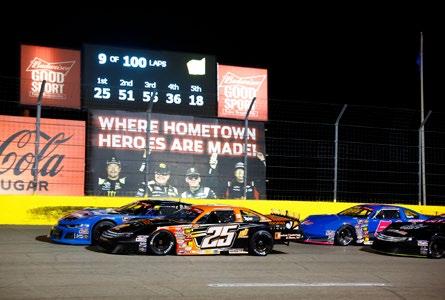
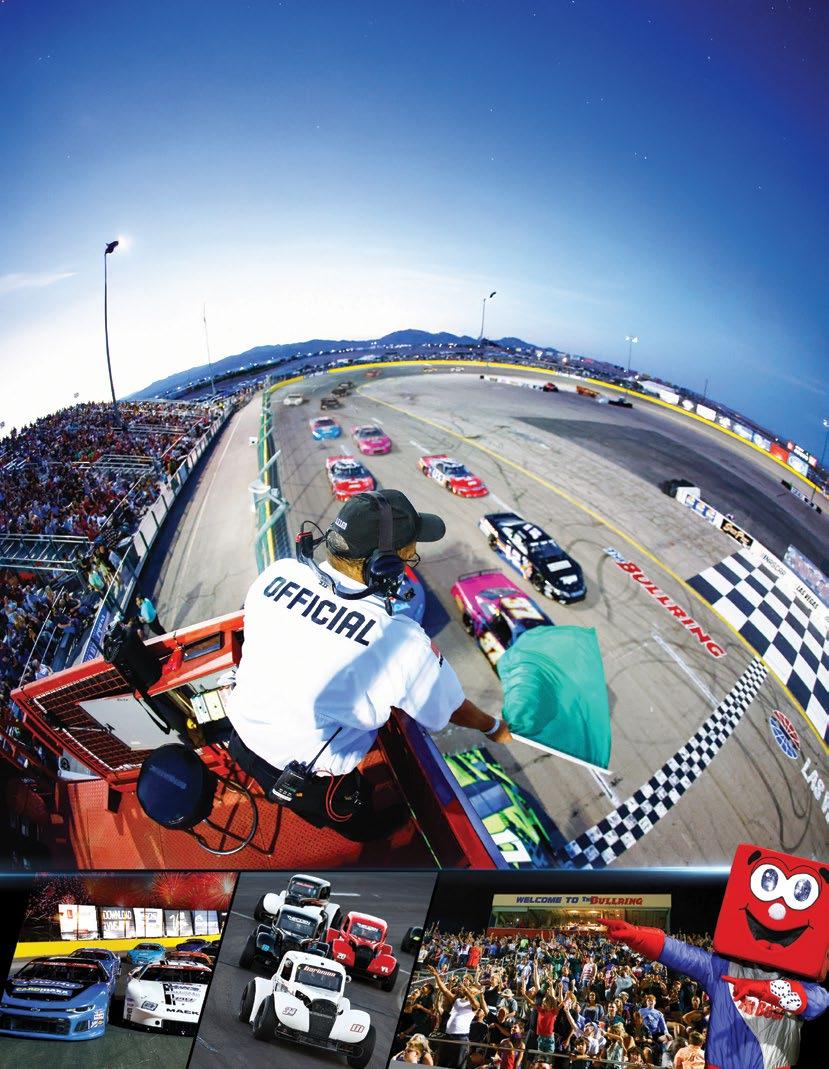

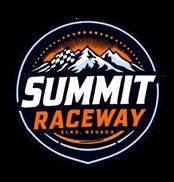
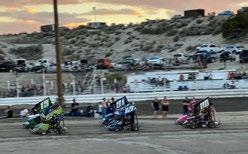
In the mountains between Elko and Spring Creek, Nevada, Summit Raceway is one of the world’s most unique short tracks. The quartermile, D-shaped clay track was built in 1984 and is owned and operated by a board of directors – a structure the nonprofit facility has followed since Day 1.
Summit Raceway hosts some of the top drivers across the western United States and features kart racing for children ages 5 to 14. It’s a true community racing facility, as many locals work in nearby gold mines during the week before coming together at the track to enjoy their shared passion for racing.
“We are surrounded by the gold mines in northern Nevada where many of our members and racers work. There are approximately 10 underground gold mines and 12 open-pit gold mines where we make our livings and enjoy our hobbies racing at Summit Raceway,” said Matt Rucker, track president and race promoter.
Summit Raceway opened in 1984, and its origin is as unique as its mountain setting. The track was the idea of the Northern Nevada Motorsports Association, a local car club. Construction began with the help of NNMA board members and volunteers from the community.

It was, and still is, a passion project.
“Ruby Dome Inc. owner Robert Dorsa and his son Steve Dorsa donated time and equipment like scrapers and dozers, along with Frehner Construction, to get the track started. The city of Elko even allowed one of their employees to use the city landfill dozer,” Rucker added.
In its early days, only 7 to 12 cars would show up on a given weekend. Since then, the track has grown substantially. Today, an average of 70 cars participate weekly, with major events drawing well over 100 entries.
The track’s biggest annual event is the Gold Rush race, which regularly draws more than 100 entries. Heat races are set by random draw, and the winner receives a $1,000 prize from the track, with additional purse money provided by sponsors.
LOCATION Elko, Nevada
TRACK OPENED 1984
TRACK TYPE D-shaped layout
TRACK LENGTH Quarter mile TRACK SURFACE Clay SEATING CAPACITY
Summit Raceway offers something for everyone, both on and off the track. Children as young as 5 can begin racing in the Beginner Box Stock Outlaw Kart division. From there, they can move up to the Intermediate division for ages 6 to 10, and then to the Advanced division for ages 11 to 14.
Spectators have plenty of seating options. Traditional grandstands line the front stretch, but the track’s bowl-like setting also makes it ideal for tailgating. The facility can accommodate around 6,500 fans.
Now, for the first time in more than 40 years, the track is preparing for a major change. Plans are underway to move to a new location.
“We are both excited for the new opportunities the new track will provide but sad to leave the heart where Summit Raceway started. We have just run out of real estate,” said Rucker.
The board has acquired a 47-acre property in Elko County where a new motorsports complex will be developed. Construction is expected to begin soon. Until then, race fans still have the chance to enjoy Summit Raceway in its original and legendary location.
6,500 FEATURED DIVISIONS IMCA Modifieds, IMCA Sport Mods, 360 Spec sprints, Hobby Stocks, Mini Mods, Micro Sprints, Dwarf Cars, Sport Compacts, Outlaw Karts (for all ages).
LEGENDS OF THE TRACK Wade Taylor, Joe Hood, Bob Massie and Mike Skinner.
KEY EVENT IN HISTORY
The annual Gold Rush race.
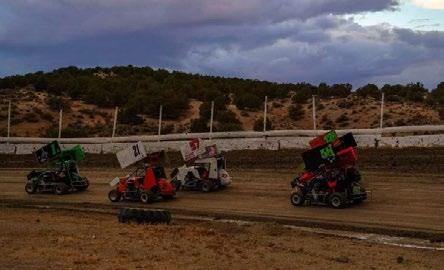






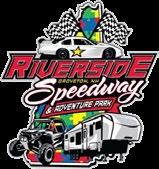
Perched on the scenic Connecticut River sits a short-track venue like no other: Riverside Speedway and Adventure Park. Opened in 1964, Riverside Speedway has hosted decades of toptier racing in Groveton, New Hampshire. With sweeping turns around its paved quarter-mile oval, the on-track competition is second to none.
The facility also features Lil Riverside gokart track, a campground and a motocross course affectionately known as “The Dirt Side.” Whether stopping by for race night or planning a weekend escape, Riverside Speedway and Adventure Park sets the standard for motorsports entertainment.
From the drop of the green flag at 6:00 p.m. on Saturday nights to the final checkered flag, Riverside Speedway keeps the action coming. This season, the track will feature seven divisions with five competing each Saturday. Fans can expect to see Late Models, Street Stocks, 4-Cylinders, Maddogs (6 & 8 Cylinders), Daredevils, Dwarf Lil Rascals and Vintage classes on a rotating schedule.
In addition to weekly racing, touring series featuring Modifieds, Pro Stocks, Mini Cup Cars and Legend Cars will also make stops at Riverside this year.
Even when the regular season ends, Riverside doesn’t go quiet. The facility stays active with drift car events and defensive driving schools. In January, the track hosts a race with a twist: the Winter Blast 100-car enduro. The event draws more than 100 entries racing on the snow-covered quarter-mile bullring. Trucks get in on the action with a 40-lap 4WD race.

The fan experience is what sets Riverside Speedway apart. Located in Turn 3, the Beer Barn is the ultimate spot to beat the heat on a summer Saturday night. Offering refreshments and concessions under a covered roof, fans can cool off during warm days with beautiful views for weekend and seasonal camping.
LOCATION Groveton, New Hampshire
NICKNAME Grovetona
For those looking to stay the weekend, Riverside offers a getaway that’s fun for the entire family. The expansive property, nestled in the rolling hills of New Hampshire and near the Connecticut River, provides river access for floating and cooling off during warm days. A full day of entertainment might include motocross on The Dirt Side followed by the thundering roar of Late Models under the lights.
Whether you’re here for the racing, the relaxation or the adventure, Riverside will have you planning your return before you leave.
On Friday Night, June 13, Riverside Speedway will host a new marquee event. The Keith Morse Memorial will feature a $20,000-to-win 150-lap main event for the North Country Ford Late Models. The race, named in honor of a longtime race fan, has gained interest from the region’s best drivers and promises to be one of the premier races in New England this summer. For those unable to attend in person, this event will be livestreamed by RaceAmerica.
Riverside Speedway and Adventure Park is more than just a race track – it’s a motorsports destination. With its blend of thrilling racing, comfortable amenities and unmatched hospitality, Grovetona is truly a slice of short-track heaven that brings families together.
TRACK OPENED 1964
TRACK TYPE Semi-banked oval
TRACK LENGTH
Quarter mile
TRACK SURFACE
Asphalt SEATING CAPACITY
3,000 seat grandstand
FEATURED DIVISIONS
Late Models, Street Stocks, 4-Cylinder Cars, Daredevils and Vintage Classes.
LEGENDS OF THE TRACK George Stone, Aaron Bennett and Randy Potter. KEY EVENT IN HISTORY
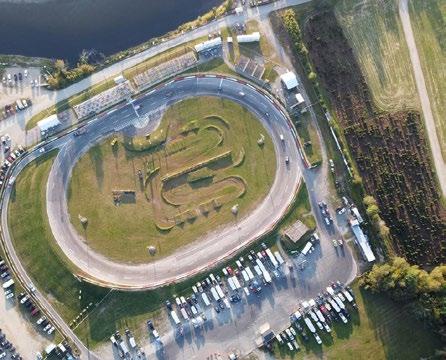
Introduction of the annual Keith Morse Memorial Late Model race.

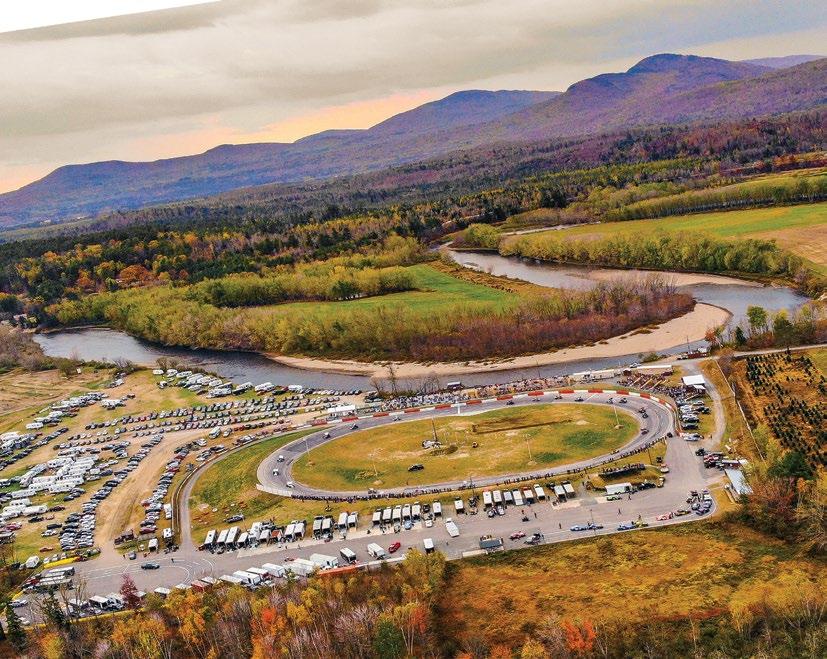
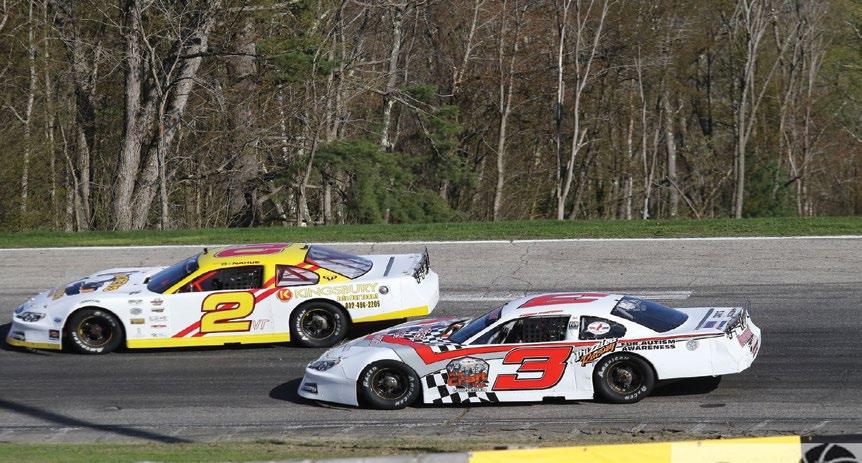










While the Northeast is better-known for its paved short tracks, the region’s dirt-track scene is alive and well, driven by marquee facilities like Bridgeport Motorsports Park.
Located in Swedesboro, New Jersey, and often referred to as the “Kingdom of Speed,” Bridgeport is a true gem among dirt racing on the East Coast.
Since purchasing the Bridgeport facility in 2019, Doug Rose has transformed a dangerous, fiveeighths-mile oval into a four-tenths-mile layout. Designed with input from racing legend Rich Tobias, the reconfigured track produces competitive racing across multiple divisions.
As a result, Bridgeport continues to attract both local racers and national stars. Some of the notable
In the wide-open landscapes of New Mexico, Suika Circuit is fast becoming one of the Southwest’s most exciting venues for grassroots racing. Opened in 2021, this purpose-built dirt track was designed with racers and fans in mind – offering a fast, racy surface and a fan-friendly atmosphere.
While it may be the new kid on the block, Suika Circuit has already carved out a loyal following by blending modern amenities with the down-home, gritty charm of traditional short-track racing. It’s where local drivers make their mark, and fans gather for Friday night thrills under the desert sky.
Suika Circuit’s three-eighths-mile, semi-banked clay oval was engineered for side-by-side action. Wide corners and a smooth surface encourage
names etched into its storied history are track champions Doug Hoffman, Gary Gollub, Jimmy Horton, Roger Laureno and Ronnie Tobias.
A recent milestone came in 2023 when Bridgeport Motorsports Park was part of the High Limit Racing Series’ inaugural season. That event brought national Sprint Car stars like Kyle Larson, Brad Sweet and Rico Abreu to New Jersey and showcased Bridgeport’s growing presence on the national stage.
The track regularly hosts Street Stock, 4-Cylinder, Modified and Sportsman racing, along with appearances by other local divisions.
The roster of touring series scheduled to visit this season includes the USAC East Coast Sprint Car Series, the USAC National Sprint Cars, the Mid-Atlantic Sprint Series and the Modifieds of the Short Track Super Series. A highlight will be the return of the High Limit Racing Series on Sept. 27.
Whether it’s the track’s rich history, its reputation or the elite schedule, Bridgeport Motorsports Park is one of the premier dirt tracks in the Northeast.

multiple grooves, producing thrilling battles across every class – from Modifieds to Hobby Stocks.
Its growing reputation as a racer’s track has drawn competitors from across the region, particularly for special events like the Desert Shootout, which anchors the schedule. With seating for 2,500, the venue strikes the perfect balance: large enough to create an electric atmosphere, yet intimate enough that every seat feels close to the action.
NICKNAME
Kingdom of Speed TRACK OPENED 1972
TRACK TYPE
High-banked oval
TRACK LENGTH
Four-tenths mile
TRACK SURFACE
Clay
FEATURED DIVISIONS
Street Stocks, 4-Cylinders, Modifieds and Sportsmen.
The track’s commitment to providing competitive racing and a family-friendly environment has quickly turned it into a favorite stop on the Southwest dirt-racing circuit.
Whether road-tripping across New Mexico or tuning in from home, Suika Circuit is worth the watch. Find the full schedule, ticket information and event updates at SuikaCircuitNM.com. Select feature races are also streamed live on RaceON.com, offering dirtracing fans the opportunity to witness the wheel-towheel battles that define the track.


NICKNAME
The Desert’s Newest Playground TRACK OPENED 2021
TRACK TYPE
Semi-banked oval
TRACK LENGTH
Three-eighths mile TRACK SURFACE
Clay
SEATING CAPACITY 2,500
FEATURED DIVISIONS
Modifieds, Stock Cars, Hobby Stocks and Sport Compacts.

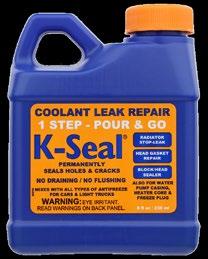

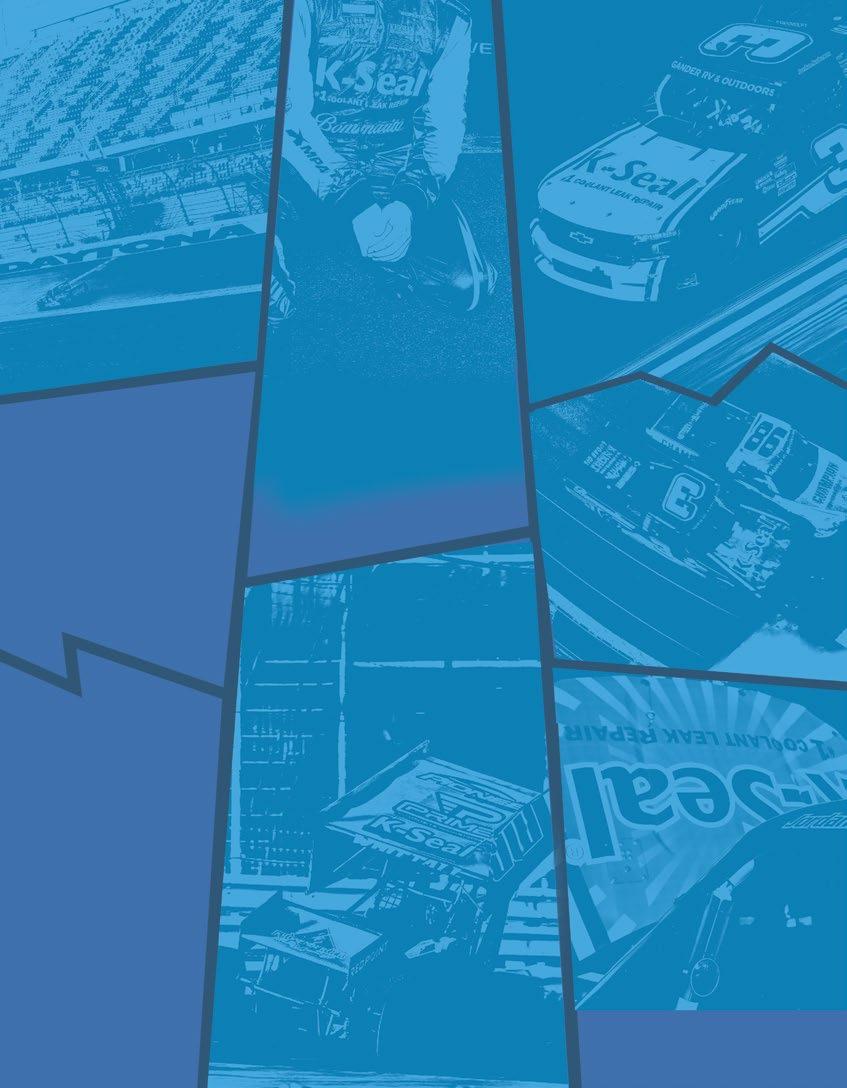
Permanently Fix Leaks in the:
• Radiator
• Water Pump Casing
• Heater Core
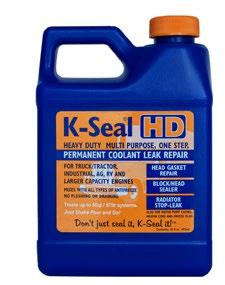

• Freeze Plug
• Block / Head
• Head Gasket
Also Seals Cracked Heads & Cracked Porous Blocks
• Can be added to a hot or cold engine*
• NOT liquid glass / sodium silicate
• Can be added to the overflow tank
• Safe for use in all water cooled engines
• Mixes with all types of antifreeze

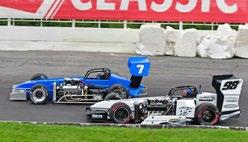
Built in 1951 on the grounds of the former Wine Creek Horse Track, Oswego Speedway was brought to life by the visions of Harry, George and William Caruso. Originally a three-eighths-mile dirt oval, the track was paved in 1952 and enlarged in 1961 to a five-eighths-mile asphalt oval.
Located in Oswego, New York, this historic facility has hosted its share of racing legends during more than seven decades of motorsports action. Today, with its long straightaways and sweeping corners, Oswego Speedway generates some of the fastest speeds in short-track racing.
Respectfully known in racing circles as the “Indy of the East,” Oswego’s unique track layout creates a lightning-fast style of racing that’s like no other. It has always put the driver to work from the wave of the green flag.
Kicking off the season, fans will find multiple divisions of Supermodified racing at Oswego. From the Small-Block Supermodifieds and Winged Sprint Supermodifieds to the DART Asphalt Modified Tour, Buckeye Super Sprint Cars and ISMA, Oswego Speedway is the place to be from May through September.
Meanwhile, NASCAR Whelen Modified Tour drivers such as Matt Hirschman, Byron Chew and Zane Zeiner often call Oswego home. This packed schedule of world-class racers creates an atmosphere of competitive, yet respectful racing across all divisions. Rubbing is racing – but at Oswego, the competition rises with every event.

While Oswego Speedway hosts numerous touring series and major races, one event stands above the rest: The Budweiser International Classic. Entering its 69th year, this Labor Day weekend tradition has become a crown jewel in the Modified racing world.
The action never stops, culminating with the Budweiser International Classic 200, featuring the Novelis Supermodifieds. Arguably one of the most iconic events on the open-wheel, short-track circuit, the Classic 200 is the highlight of the year for Oswego and Supermodified fans. Catch it live on FloRacing beginning Aug. 29.
Then, in October, World Racing Group officials transform Oswego into a dirt track in preparation for Super DIRT Week, a Modified racing tradition that started at the New York State Fairgrounds in 1972.
Now operated by the Torrese family, Oswego Speedway has made major strides in offering modern amenities while preserving its timeless charm. Fans are welcomed by a new ticket booth and main entrance before entering the heart of the speedway.
Inside, tickets grant access to the renovated Gary Witter Memorial Grandstands or VIP booths that are perched above the frontstretch, offering uninterrupted views of the action.
The track’s signature 20-position scoring pylon lights up each race weekend, ensuring fans can follow every moment. When it’s time to relax, the Oswego Speedway Tiki Bar offers a fun, refreshing break. The result is a one-of-a-kind facility that honors its past while embracing the future.
LOCATION
Oswego, New York
NICKNAME
Indy of the East TRACK OPENED 1951
TRACK TYPE Oval TRACK LENGTH
Five-eighths mile
TRACK SURFACE
Asphalt SEATING CAPACITY
10,000 FEATURED DIVISIONS
Multiple divisions of Supermodifieds. LEGENDS OF THE TRACK Bentley Warren, Doug Didero, Davey Hamilton and Joe Gosek. KEY EVENT IN HISTORY
Jack Murphy beat Nolan Swift to win the inaugural Budweiser International Classic 200 in 1957.

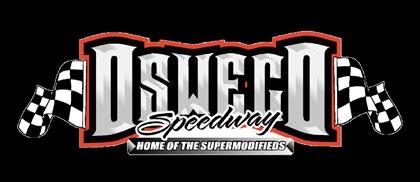
16-17 ‘Fast Friday’ Format Practice #1 and #2
Novelis Supermodifieds, Oswego 350 Supermodifieds, Pathfinder Bank SBS, Novelis ISMA / MSS Supermodifieds
23 Open Practice 2025
Novelis Supermodifieds, Oswego 350 Supermodifieds, Pathfinder Bank SBS, Novelis ISMA / MSS Supermodifieds
24 Chase Enterprises OPENING WEEK EXTRAVAGANZA
Oswego 350 Supermodifieds, Pathfinder Bank SBS, Novelis ISMA / MSS Supermodifieds
30 Fast Friday
Novelis Supermodifieds, Oswego 350 Supermodifieds, Pathfinder Bank SBS, Novelis ISMA / MSS Supermodifieds
31 74th Season Kickoff - Jim Shampine & Tony White Memorials
Novelis Supermodifieds, Oswego 350 Supermodifieds, Pathfinder Bank SBS
14 Novelis Supermodifieds - Road to the Championship
Novelis Supermodifieds, Pathfinder Bank SBS
21 Autograph Night #1 | Novelis Super 50, Pathfinder Bank SBS 30, J&S Paving 350 25
Novelis Supermodifieds, Oswego 350 Supermodifieds, Pathfinder Bank SBS
28 Holiday Inn Express & Suites ISMA/MSS/Oswego Novelis Supers WINGED Challenge Race #2
Oswego 350 Supermodifieds, Pathfinder Bank SBS, Novelis ISMA / MSS Supermodifieds 5 Novelis Supermodified Twin 40’s Round 1 PLUS SBS and 350 Supers | FIREWORKS!
Novelis
Novelis
WORDS: ALLEN WALKER
In 1961, Millard “Bub” Benway and his brother Ray built a third-mile paved oval known as Mil-Ray Raceway. The track hosted its first race in June 1962, with a dragstrip opening the following month.
For more than 15 years, Mil-Ray Raceway operated as an asphalt track, but in 1978 it underwent a major transformation. Instead of removing the asphalt, however, the owners packed clay on top, creating a high-banked, three-eighths-mile dirt track that opened in 1979. The dragstrip was converted into the pit and access road, a layout that remains today.
Now, every Saturday night, Fulton Speedway comes alive under the lights, hosting 358 Small Block Modified racing.
Over the years, Fulton Speedway has welcomed some of the biggest touring series in dirt racing, including the Super DIRTcar Series, DIRTcar 358-Modified Series, DIRTcar Sportsman Series, DIRTcar Pro Stocks Series, Empire Super Sprints and the World of Outlaws.
While these events bring top-tier talent to the track, the heart of Fulton’s weekly program is the 358-Modified division. This class serves as a crucial stepping-stone for drivers transitioning from Sportsman Modifieds to the powerful Big-Block Modifieds that run at Fulton’s sister track, Brewerton Speedway.
Fulton Speedway’s crown jewel event is the Outlaw 200. Originally called the Victoria 200, the race was rebranded in 2009 but has remained a cornerstone of the northeastern Modified scene since its inception in 1986. The event is exclusive to SmallBlock Modifieds and draws top talent from across the region. The 39th annual Outlaw 200 is Oct. 2-4.
Located just about 90 miles south of the Canadian border, Brewerton Speedway is a historic one-thirdmile dirt track that has stood the test of time. Opened in 1949 as a quarter-mile oval, the track was expanded to its current configuration in 1973.
Today, Brewerton thrives as a premier DIRTcarsanctioned venue. Anchored by the roaring Big-Block Modifieds, the track’s weekly program continues a tradition that has defined racing in Oswego County for more than seven decades.
Every Friday night from May through August, Brewerton Speedway welcomes fans under the lights for action-packed racing. Owned since 2009 by John and Laura Wright, Brewerton has emerged as a go-to destination for families and groups of friends looking for an entertaining night out.


NICKNAME X
FACTS NICKNAME Home of the High Banks TRACK OPENED 1961
TYPE High-banked oval TRACK LENGTH Three-eighths mile
SURFACE Clay
X
DIVISIONS X
CAPACITY 4,500 FEATURED DIVISIONS DIRTcar 358 Modifieds, DIRTcar Sportsman, Novice Sportsman and Hobby Stocks.
As the season winds down in late September, Brewerton caps the year with a special event. Tied to Super DIRT Week in October, the track hosts Hurricane Harvey, a one-day spectacle honoring former promoter Harvey Fink. This event serves as a thank you to the dedicated fans by showcasing high-intensity racing across multiple divisions.
Brewerton Speedway’s longevity is a testament to management’s forward-thinking. Understanding the importance of fostering the next generation of race fans and competitors, the track offers free admission to anyone aged 18 and younger.
Throughout the season, Brewerton also provides young fans with unique experiences – whether it’s winning a bike, earning prizes or taking a ride in the pace car. These initiatives ensure the passion for dirt racing continues for generations to come.
By blending its rich history with a commitment to the future, Brewerton Speedway remains a cornerstone of short-track racing.

3,500 FEATURED DIVISIONS Big-Block Modifieds, Crate Sportsmen, Mod Light STARS, 358-Modifieds and DIRTcar 4-Cylinders.



Oswego County, located in central New York along the shores of Lake Ontario, is a prime destination for outdoor enthusiasts who enjoy fishing and hunting. The county’s diverse landscape, which includes vast forests, winding rivers and expansive shorelines, provides an ideal habitat for a variety of fish and game species.
Whether an angler looking to reel in trophy fish or a hunter seeking the thrill of the chase, Oswego County offers numerous opportunities to engage in these traditional outdoor activities.
Oswego County is widely recognized as one of the best fishing destinations in the Northeast. Its waterways, including Lake Ontario, the Oswego River, the Salmon River and Oneida Lake, are brimming with fish year-round. The county attracts anglers from all over the world who are eager to experience world-class fishing.
Lake Ontario: Lake Ontario is famous for its salmon and trout fisheries. Each year, thousands of anglers visit the county to fish for Chinook and Coho salmon, brown trout, lake trout and steelhead. The best fishing typically occurs from late spring through fall, with peak salmon runs happening in September and October. Charter fishing services are widely available, providing guided experiences for novice and seasoned anglers alike.
Salmon River: The Salmon River, one of the most wellknown fishing spots in Oswego County, is renowned for its annual salmon and steelhead runs. The river attracts thousands of anglers each fall, as massive Chinook and Coho salmon migrate upstream to spawn. The winter and spring months offer excellent steelhead fishing, making the river a year-round hotspot for anglers. Fly fishing and drift fishing are popular methods used to catch these prized fish.
Oneida Lake: Oneida Lake, located in the southern part of Oswego County, is another top fishing destination. The lake is known for its populations of walleye, largemouth and smallmouth bass, northern pike and perch. Ice fishing is particularly popular

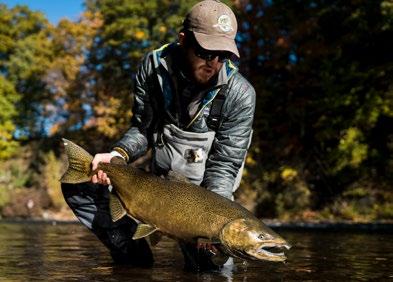
in the winter months when the lake freezes over, providing excellent conditions for catching walleye and perch.
Oswego River & Other Streams: The Oswego River and numerous tributaries throughout the county also offer great fishing opportunities. These waters are home to a variety of fish species, including bass, walleye, northern pike and panfish. Many of the smaller streams and creeks are ideal for fly fishing, offering a more secluded and peaceful fishing experience.
Oswego County’s forests, wetlands and agricultural lands make it an excellent location for hunting. The county is home to a variety of game species, including deer, turkey, waterfowl and small game. With a mix of public and private hunting lands, there are ample opportunities for hunters to pursue their sport.
Deer Hunting: White-tailed deer are the most sought-after game in Oswego County. The county offers prime deer hunting conditions, with a mix of woodlands and open fields providing excellent habitat. Both archery and firearm seasons attract hunters each year, with the peak of the season occurring in November. The state’s Department of Environmental Conservation (DEC) manages hunting regulations to ensure sustainable populations.
Turkey Hunting: Oswego County is also a popular destination for turkey hunting. Spring and fall turkey seasons provide hunters with opportunities to pursue these challenging game birds. The county’s agricultural fields and wooded areas are ideal habitats for turkeys, making for productive hunts.
Waterfowl Hunting: The county’s proximity to Lake Ontario and numerous wetlands makes it an excellent area for waterfowl hunting. Ducks and geese migrate through the region, providing hunters with ample opportunities. The shoreline, marshes and inland waterways serve as prime hunting locations during the fall migration season.
Fishing and hunting in Oswego County offer some of the best outdoor experiences in New York State. Whether casting a line in the renowned Salmon River, setting up a deer stand in the county’s lush forests or pursuing waterfowl along the Lake Ontario shoreline, the region provides endless opportunities for those who enjoy the outdoors. With abundant wildlife, well-managed resources and a strong outdoor culture, Oswego County remains a top destination for fishing and hunting enthusiasts year-round.


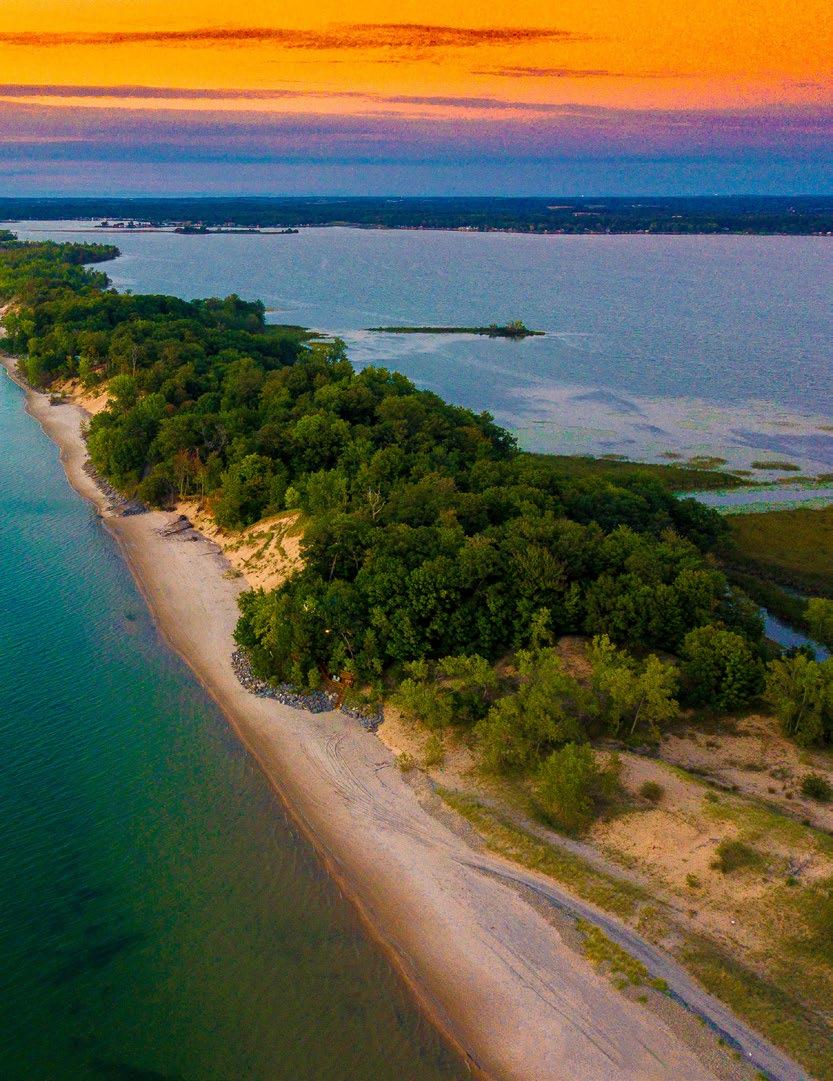
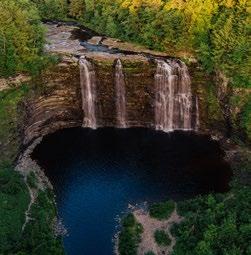
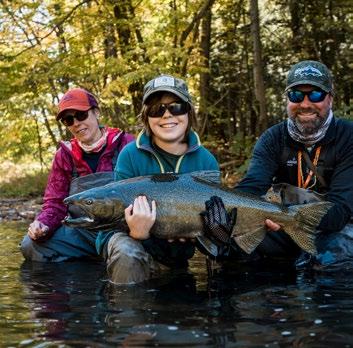
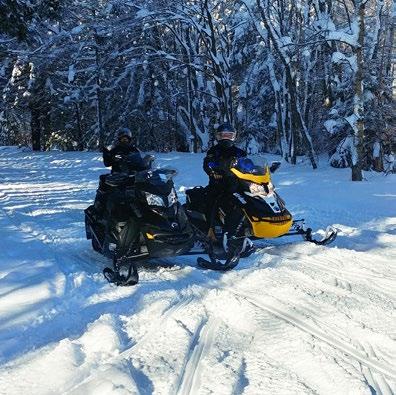
WORDS: CODY WILLIAMS PHOTOGRAPHY: RANSOMVILLE SPEEDWAY

Located 10 miles from the American-Canadian border in Ransomville, New York, sits the moderately banked, high-speed Ransomville Speedway. Affectionately known as “The Big R,” this four-tenths-mile clay oval has been a local staple for nearly 70 years.
Founded in 1958 by racing legend Ed Ortiz, the speedway was born from a desire to keep local teenagers off the streets and give them a safe place to race. Ortiz and 15 of his closest friends, known as the “Slo-Pokes,” raised funds to purchase land behind his father’s car dealership. Their dream became reality, and the track quickly grew into a weekly racing hotspot for western New York. Ortiz himself claimed the track championship in 1962.
Today, Ransomville Speedway is owned by Parm and Jennie Atwal and operated by Tana Robinson. Thanks to its rich history and loyal fan base, it is a must-visit destination for grassroots racing enthusiasts across the Northeast. Over the years, the track has attracted some of the sport’s biggest names, including drivers from the World of Outlaws Sprint Car Series.
“This is what everyone in the community does on Friday nights. We have a very loyal local fan base,” Robinson shared.
That community support is the lifeblood of Ransomville Speedway, ensuring its legacy continues for generations to come.
Ransomville has long been a proving ground for racing talent, producing local heroes and national stars alike. Ortiz was a standout competitor throughout the Northeast before his retirement in 1998. The track also showcased fan-favorites like Chuck Boos, who was a fixture in weekly competition.
Other legends who made their mark include Danny Johnson, Gary Iulg, Merv Triechler, Pete

Bicknell, and Mat Williamson, the defending Super DIRTcar Series champion.
Perhaps Ransomville’s most famous graduate is NASCAR Craftsman Truck Series driver Stewart Friesen. The Friesen family once owned the track, and it served as Stewart’s launching pad toward his NASCAR career.
One of the most storied rivalries in track history is the decades-long battle between Danny Johnson and Charlie Rudolph. Throughout the 1980s, ’90s and early 2000s, these two dirt-track stars were dominant forces at “The Big R.” Combined, they claimed the 358 Modified track title nine times, creating a fierce, yet friendly rivalry that became a cornerstone of Ransomville’s legacy.
The track’s 2025 season will kick off in early May and run through September, hosting various series and divisions. Historically, the track has welcomed major series like the World of Outlaws Sprint Car Series. Currently, it serves as a premier stop for DIRTcar-sanctioned racing, particularly the 358 Modified division.
Like the World of Outlaws, DIRTcar is owned and managed by World Racing Group.
Other regular divisions include the Weekly Sportsmen, Street Stocks, Mini Stocks and the Novice Sportsman class – a steppingstone for drivers aspiring to move up.
This year, the track is set to host one of its most anticipated events. On May 16, Ransomville will host the High Limit Sprint Car Series for the first time. NASCAR Cup Series champion and series co-owner Kyle Larson frequently competes in the nomadic Sprint Car series. Hometown hero Stewart Friesen is also trying to make it work within his schedule.
One of Ransomville Speedway’s most unique features is its infield go-kart track, affectionately known as “Little R.” Designed to introduce young racers to the sport, Little R serves as a feeder system for The Big R – giving kids the chance to experience fast-paced competition at an early age.
LOCATION
Ransomville, New York
NICKNAME
The Big R TRACK OPENED 1958 TRACK TYPE Oval TRACK LENGTH
Four-tenths mile
TRACK SURFACE Clay SEATING CAPACITY
3,300 FEATURED DIVISIONS DIRTcar 358 Modifieds, DIRTcar Sportsman, Street Stocks, Mini-Stocks, and Novice Sportsman.
LEGENDS OF THE TRACK
Ed Ortiz (founding member), Chuck Boos, Stewart Friesen, Danny Johnson and Charlie Rudolph. KEY EVENT IN HISTORY Rivalry between Danny Johnson and Charlie Rudolph.
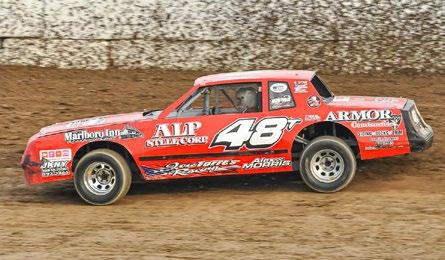

Witness the best short track racing in the northeast each and every Friday night.
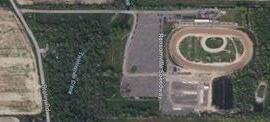



Fri., April 25
Fri., May 2
VP presents Annual Test, Tune and Time
SANY presents Season Opener SS, Mini’s, Spt, Nov, 358’s
Fri., May 9 SS, Mini’s, Spt, Nov, 358’s
Fri., May 16
Fri., May 23
Fri., May 30
Fri., June 6
Fri., June 13
Fri., June 20
Fri., June 27
Fri., July 4
Fri., July 11
Fri., July 18
Fri., July 25
Bateman Construction Corp presents Kubota High Limits plus Empire SS Series
SS, Mini’s, Spt, Nov, 358’s
Mark Cerrone Inc presents DIRTcar Sportsman Series West Region, SS, Mini’s, Nov, 358’s plus DNA Towing Demolition Derby
A-Verdi Storage Containers presents the A-Verdi Next Gen Power Wheels 200 - SS, Mini’s, Spt, Nov, 358’s
Atwal Eye Care presents Northeast Late Model Alliance plus SS, Mini’s, Nov, 358’s
Labor Night at the Races presents Vintage Cars & Hobby Stocks plus SS, Spt, Nov, 358’s
JW Swanson presents Poster ContestSS, Mini’s, Spt, Nov, 358’s
Sevenson’s and Sunset Bar & Grill presents FIREWORKS, CRSA 305 Sprints, Mini’s, Spt, Nov
Performance Manufacturing presents Empire SS Series & Go-Kart Exhibition plus Mini’s, Spt, Nov, 358’s
Shelby Crushed Stone presents Bike Races SS, Mini’s, Spt, Nov, 358’s
Chris’ Appliances presents Halloween in July & Autograph Night - SS, Mini’s, Spt, Nov, 358’s
Fri., Aug.1 NO RACING
Sat., Aug. 2 Versus Monster Trucks
Fri., Aug. 8 SS, Mini’s, Spt, Nov, 358’s
Tue., Aug.12
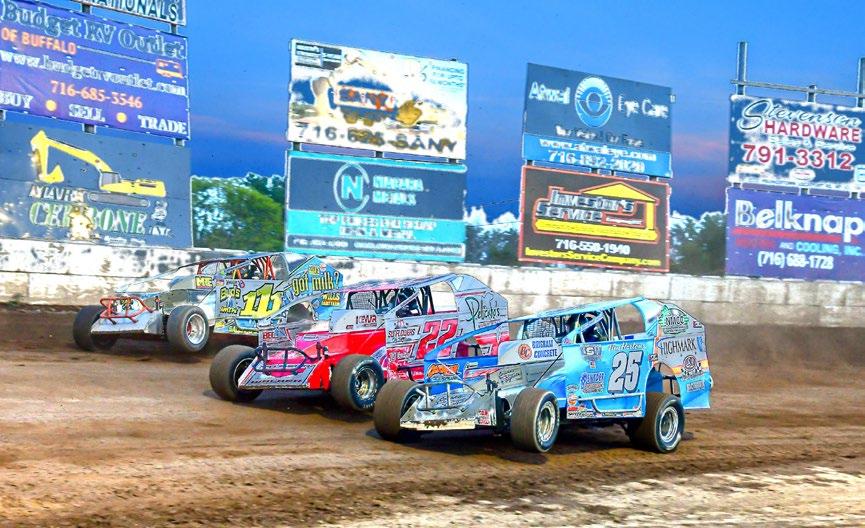
Fri., Aug. 15
Fri., Aug. 22
Fri., Aug. 29
Fri., Sept. 5
NMCC presents 40th Ron Martin Summer Nationals Super DIRTcar Series bb plus Mike Bonesky DIRTcar Sportsman Champ Trail Race
Niagara Metals presents Kulesza and Mateo Memorials SS, Mini’s, Novice, Vintage Cars plus Kid’s Rides
Firth Jewelers presents Hawaiian Night SS, Mini’s,Spt, Nov, 358’s
DNA Towing Demolition Derby - Champions Night SS, Mini’s, Spt, Nov, 358’s
MDM Painting presents CRSA 305 Sprints, John Susice Memorial SS, Mini’s, Spt
Fri., Sept. 12 RAINDATE IF NEEDED

Land of Legends Raceway in Canandaigua, New York, began its storied history in 1957. Originally opened as Canandaigua Speedway, this historic track has seen its share of thrilling races, heated battles and passionate fans – all drawn in by the sights, sounds and smells of weekly dirt-track action.
This half-mile, semi-banked clay oval is famous for its intense racing, with cars going five and even six wide, and for the high speeds its layout generates. With speeds hitting 120 mph and lap times dipping as low as 15 seconds, Land of Legends delivers an adrenaline-charged experience on the dirt.
At 6:30 p.m. on Saturday nights, Land of Legends Raceway comes alive. Headlined by the Big-Block Modifieds, the weekly program also features Full-Fender Street Stocks, Hobby Stocks, Sportsmen and 305 Sprint Cars. Only the top 20 from each class qualify for the feature races, creating stacked, highly competitive lineups.
Among the field, fans will find drivers from various touring series, with seven to eight Platinum drivers from the Super DIRTcar Series competing nearly every week. The level of competition is second to none – during the 2024 season, nine different drivers claimed victory across 13 Sprint Car events at the track.
With multiple racing grooves and the ability to go five or six abreast, racers constantly battle for position, slicing through the field in dramatic fashion.
Land of Legends Raceway is also a leader in fan technology. Each weekend, fans around

the world can tune in to LandofLegendsTV.com, where the races are streamed live and free. Creating a user account is all it takes to access every event, no matter the viewer’s location.
The broadcast experience is elevated with multiple camera angles, including in-car cameras, drones and speed shots. The production team goes all out to make Land of Legends accessible and exciting for everyone.
For those who want even more, a subscription option unlocks full access to archived races. Whether a die-hard fan reliving classic moments or a driver looking to study past performances, the all-access pass is a powerful tool. With extensive footage and years of racing content, this streaming service is can’t-miss TV for racers and race lovers alike.
Every September, two weeks after Labor Day, Land of Legends Raceway hosts the Gerald Haers Memorial, a marquee event that honors the legacy of Haers and his deep connection to the track. Over two days, the track puts on a show that draws racers and fans from all over.
The event features the Sportsman Fall Championship and a Big-Block Modified showdown with a $10,000 prize going to the winner. In 2024, the Gerald Haers Memorial added another chapter to the track’s legacy by being named “Outstanding Short-Track Event of the Year” by the readers of Racing Promotion Monthly.
Whether watching online at LandofLegendsTV. com, catching up on YouTube or listening to the podcast Where Legends Are Made, Land of Legends Raceway makes sure fans are always part of the action.
Visiting this iconic venue should be on every race fan’s bucket list. And while you’re there, don’t forget to try their signature Land of Legends Beer from Dispatch Brewery.
LOCATION
Canandaigua, New York TRACK OPENED
1957 TRACK TYPE
Semi-banked oval TRACK LENGTH
Half mile TRACK SURFACE
Clay SEATING CAPACITY
3,700 FEATURED DIVISIONS
Big-Block Modifieds, 360 Empire Super Sprints and 305 Sprint Cars.
LEGENDS OF THE TRACK
Dutch Hoag, Matt Shepard, Steve Payne, Alan Johnson, Danny Johnson, Matt Lanson, Peter Britten, Max McLaughlin and Brett Hearn.
KEY EVENT IN HISTORY
Gerald Haers Memorial, a Big-Block Modified Showdown.




One of the most fabled short tracks in the country, Hickory Motor Speedway has built a reputation over seven-and-a-half decades as a place where NASCAR greats have cut their proverbial teeth and future stars of the sport are born.
The list of legends who’ve competed at the North Carolina facility includes household surnames such as Petty, Pearson, Earnhardt and Jarrett. But when one considers Hickory’s location – about an hour from Charlotte, North Carolina, and the heart of NASCAR country – it’s no surprise that so many impact players have traversed the tiny asphalt oval.
Since opening in 1951, Hickory Motor Speedway has undergone several transformations and served in a variety of roles. Once a pillar of what is now the NASCAR Cup Series schedule, Hickory hosted its first Cup Series race in 1953 and remained part of the tour through the 1971 season.
Later, beginning in 1982, the speedway played host to what is today known as the NASCAR Xfinity Series and was a part of that series’ schedule for 17 years. Since then, the track has been a popular venue for lower divisions, including the NASCAR Advance Auto Parts Weekly Series and the zMAX CARS Tour.
configurations since its inception, morphing from its original layout into a four-tenths-mile dirt track in 1955. The track took on pavement a dozen years later and in 1970 was shortened to its current length of .363 miles. Its present layout is unique in that Turns 1 and 2 feature a higher degree of banking than Turns 3 and 4.
The well-known figures who competed at Hickory Motor Speedway are very much a who’s who in the sport. They included Dale Earnhardt, Junior Johnson, Ned Jarrett, Ralph Earnhardt, Tim Flock, Jack Ingram and Tommy Houston.
Several of these men achieved great success at Hickory, collecting trophies and track championships while winning over the hearts of many fans who were lucky enough to watch them race.
“I was 9 years old when I attended my first event at Hickory Motor Speedway,” Hickory Motor Speedway General Manager Kevin Piercy said. “NASCAR Hall of Famer Jack Ingram won the race, but the sights, the smell of hot tire rubber and the fabrication and paint in those older cars had me hooked.
“Fifty-two years later, a lot has changed, but at the age of 61, I still love this historic old race track.”
In recent years, Hickory has served as a training ground for current day NASCAR Cup Series superstars such as William Byron and Josh Berry. What’s
In keeping with the track’s tradition, change is in the air again. One is the addition of the Hickory Motor Speedway Grand Slam, a four-race championship crown for the Late Models of the NASCAR Advance Auto Parts Weekly Series.
Also new is a 10-foot-by-32-foot Jumbotron Scoreboard and Videoboard. It has a much cleaner view of the scoreboard positions and offers a live feed of the racing.
LOCATION Newton, North Carolina
NICKNAME
America’s Most Famous Short Track TRACK OPENED 1951 TRACK TYPE Oval with variable banking TRACK LENGTH .363 miles TRACK SURFACE
Asphalt SEATING CAPACITY
12,000 (9,500 in grandstands)
FEATURED DIVISIONS
Late Models, Limited Late Models, Street Stocks, Super Trucks and Renegades. LEGENDS OF THE TRACK Harry Gant, Jack Ingram, Dale Earnhardt, Ralph Earnhardt, Ned Jarrett, Tim Flock, Tommy Houston, William Byron and Josh Berry. KEY EVENT IN HISTORY
Hosting the NASCAR Cup Series in 1953 for the first time.

Hickory Motor Speedway has sported four
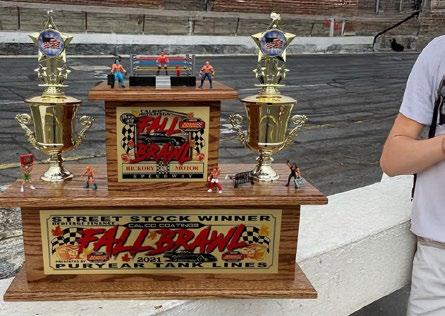
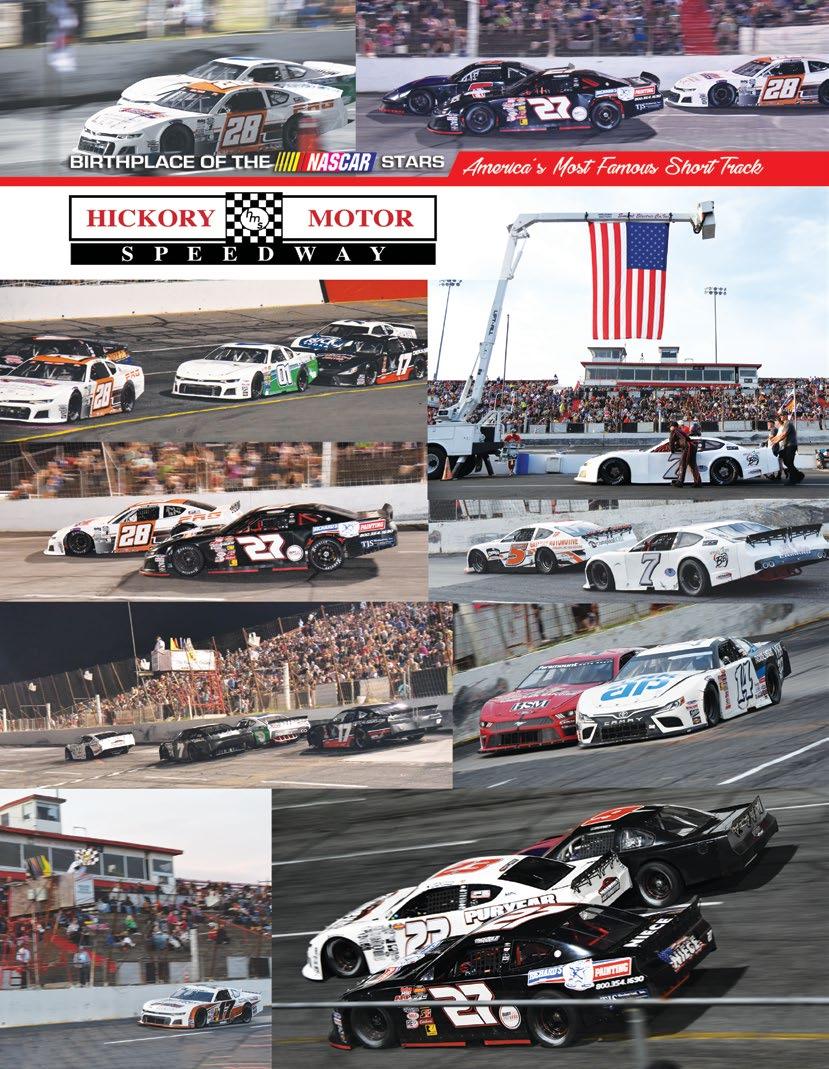
Jamestown Speedway is located on the Stutsman County Fairgrounds in Jamestown, North Dakota. The racy bullring stands out among other quarter-mile dirt ovals, as its high-banked turns—measuring 21 degrees—produce an actionpacked show for fans who flock to this eastern North Dakota community, which is also home to the North American Bison Discovery Center.
The track, in its current iteration, opened in 1963 and is known as the “Home of the Stock Car Stampede,” a crown jewel event that draws North Dakota’s top local racers, all eager to conquer the beast that is Jamestown Speedway.
“We’re all about tradition,” said track representative Tim Baldwin, who took over promotional duties with his wife, Allison, in 2017. It’s their dedication to tradition and commitment to the weekly program that keep fans and competitors coming back.
The IMCA Dirt Modifieds take center stage on most nights during weekly Saturday night racing that runs from May through the end of August.
Other divisions that visit the track include the WISSOTA Street Stocks, WISSOTA Midwest Modifieds, INEX Legend Cars, Central Dakota Pure Stocks, and Junior Slingshots. The track also participates in the annual Dakota Classic Modified Tour, a grueling six-race series held over six days across North Dakota.
Notable drivers who have competed at Jamestown Speedway include Jack McDonald, Johnny C., and Don Gumke, the latter of whom is the namesake of the annual Don Gumke Memorial racing event.
‘It’s More of a Festival’ Jamestown Speedway’s marquee event is the Stock Car Stampede. Created in 1972 by Jim Corcoran, this event attracts competitors nationwide. In fact, drivers from the Upper Midwest compete in the race, and participation continues to grow each year.

Regarding the Stampede, Tim Baldwin said, “It’s more of a festival than a race.”
Fans start arriving early in the third week of September to take part in the festivities. The excitement begins Thursday night with the Drivers’ Charity Auction, followed by preliminary races on Friday night. The Stampede champions are crowned during the main events on Saturday night.
Beyond the racing action, there are numerous family activities. The best chili cooks in the area compete in an annual chili cook-off, while other entertainment options include bean-bag tournaments, a live band, and campfire gatherings.
Fans visiting the track are likely to see many familiar, welcoming faces. Longevity is key at Jamestown, with several staff and crew members having been there for decades.
Flag-stand worker Brian Smith and previous promoter Joanne Dieterle have been with the speedway since the early 1980s while Denny Qual was involved for 44 years. Keith Veil, a longtime track supporter, eventually became one of the track’s most dedicated volunteers. He is credited with building the current Boom Truck which helps maintain the racing surface by watering it across the entire track at once.
Fan favorites among the many items on the concession stand menus are Chicken O’s (a hollowed-out chicken patty shaped like a tire), premium pizza pockets shipped on dry ice from Atlanta, and deep-fried chicken gizzards—a local delicacy.
Ticket information and the track’s complete 2025 schedule are available at jamestownspeedway.com.
NICKNAME
Home of the Stock Car Stampede
TRACK OPENED
1963
TRACK TYPE
High-banked oval
TRACK LENGTH
Quarter mile
TRACK SURFACE
Clay SEATING CAPACITY
1,800 FEATURED DIVISIONS
Dakota Classic IMCA Modified Tour and WISSOTA Street Stock Tour.
LEGENDS OF THE TRACK
Jack McDonald, Don Gumke and Johnny C. KEY EVENT IN HISTORY
The 54th annual Jamestown Stock Car Stampede is Sept. 19-20.
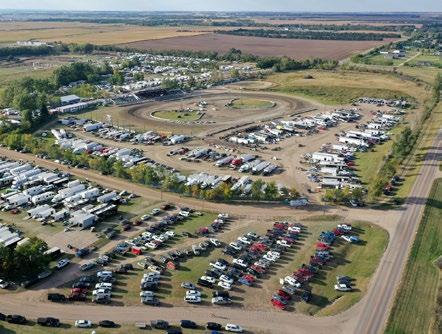

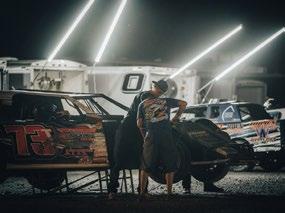
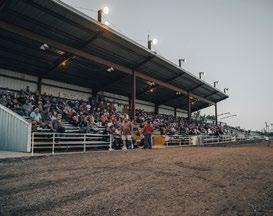
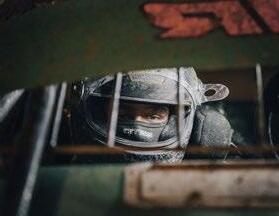
AT
WORDS: JOSH MULL
Few race tracks in the world command the same level of respect and prestige as Eldora Speedway.
Located in Rossburg, Ohio, this legendary halfmile oval has been the pinnacle of dirt- track racing since 1954 when founder Earl Baltes carved it from a hillside next to his popular dance hall, the Eldora Ballroom.
Now owned by NASCAR Hall of Famer Tony Stewart and managed by USAC sprint car champion Levi Jones, the track hosts several of the richest and most popular dirt-racing events in the world.
Eldora is the industry leader among numerous categories of the short-track industry.
It is home to multiple crown jewel events, including the World 100, Dirt Late Model Dream and Dirt Track World Championship for Super Late Models; the Kings Royal and Joker’s Jackpot for winged Sprint Cars; and the 4-Crown Nationals that spotlights USAC’s three premier open-wheel divisions.
These major events attract the biggest names in dirt racing and huge crowds, creating an electric atmosphere that makes Eldora a bucket-list destination. Weekly and regional events also provide thrilling action.
Eldora made history in 2013 when it hosted the first NASCAR national series event on dirt since Sept. 30, 1970, when the Cup Series raced at the North Carolina State Fairgrounds in Raleigh. The NASCAR Craftsman Truck Series raced annually at Eldora from 2013 to 2019, attracting mainstream media attention and fueling NASCAR’s renewed interest in dirt racing.
Fans looking to experience the action live can visit Eldora Speedway’s website (eldoraspeedway.com) for event schedules, ticket details and facility information. Those unable to attend in person can watch Eldora’s biggest races live on FloRacing, which serves as the official streaming partner for many of its events.
Stay up to date through Facebook, Twitter (X), Instagram and YouTube for exclusive content, race highlights and driver interviews.

NICKNAME
The Big E TRACK OPENED 1954 TRACK TYPE
High-banked oval TRACK LENGTH
Half mile TRACK SURFACE Clay SEATING CAPACITY 30,000 FEATURED DIVISIONS
Super Late Models, Sprint Cars, Modifieds, Stock Cars and more.
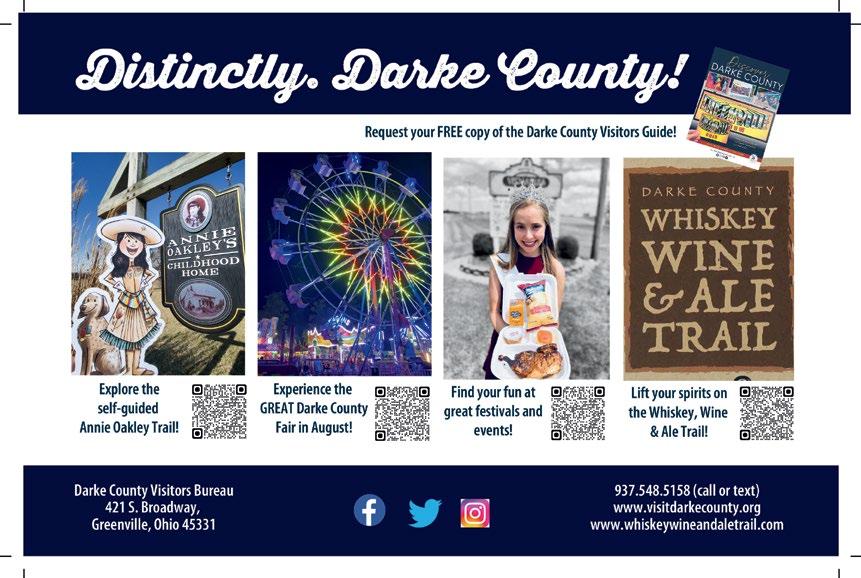
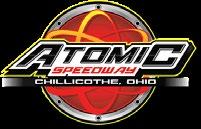
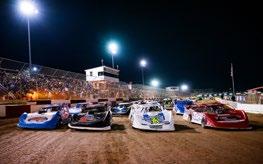
When it comes to pure, raw speed, very few race tracks can match the energy that Atomic Speedway generates. Known as the “Fastest 3/8th Mile Dirt Oval in the World,” it’s a place only the bravest can ride the cushion – and the fans absolutely love it.
Atomic Speedway was the end result when a group of businessmen from Chillicothe, Ohio, set out to capitalize on the surging popularity of stock car racing in the Buckeye State during the mid-1950s.
The group included race fans, car owners and drivers – people who understood what the future held for auto racing and wanted to build a track that could meet the sport’s growing demands. Construction was completed in 1953, and Atomic Speedway officially opened.
Three years later, in 1956, the track relocated from its original site to its current home in Ross County, Ohio.
Big-time racers from all over the country showed up to see what this new speedway was all about – and they quickly realized it was unliked any track on which they had previously battled.
Track CEO Charlie Vest said, “Just the ridiculous speed makes this place set aside. When you come here and watch race cars get around this place, it’s amazing how fast Atomic Speedway is.”
The speeds at Atomic Speedway are jaw-dropping, but how can such a small track be so fast? The answer lies in its high-banked, progressive layout. Turns 1 and 2 differ from Turns 3 and 4, creating a distinctive challenge for drivers on each lap.
A racer starts on the front straightaway before entering Turns 1 and 2, which feature 32 to 36 degrees of banking. From there, they hit a slightly curved back straightaway – described by Vest as almost D-shaped – before diving into Turns 3 and 4, both slightly steeper at 34 to 36 degrees.
Atomic Speedway has hosted some of the biggest events and toughest competitors in dirt racing. Each year, World of Outlaws fans can catch both the Sprint Car and Late Model divisions on the Atomic high banks. The Lucas Oil Late Model Dirt Series also runs major events at the track. Winged 410 Sprint Cars, Late Models, Modifieds, Sports Mods and the IMCA Racesaver 305 Sprint Cars, are featured on the Atomic schedule as well.
“Every world racing series we’ve had here,” said Vest.
Some of the biggest names in racing have competed – and won – at Atomic. NASCAR champion Jeff Gordon honed is racing skills on the track’s high banks, dominating from the start. Tony Stewart and Donny Schatz have also visited Victory Lane at Atomic.
Local heroes such the late Delmas Conley have earned legendary status for their long-term contributions.
“Every sprint car guy in a record book has been here,” Vest said. “If you probably went through a list of Sprint Car Hall of Fame or Dirt Car Hall of Fame people, just about everybody has been here.”
Current stars Kyle Larson, Christopher Bell and Alex Bowman have also turned laps at the famed Ohio oval.
LOCATION
Chillicothe, Ohio
NICKNAME
The Fastest 3/8th Mile Dirt Oval in the World TRACK OPENED
1953
TRACK TYPE
High-banked oval
TRACK
LENGTH
Three-eighths mile TRACK
SURFACE
Clay SEATING CAPACITY
7,000
FEATURED DIVISIONS
Winged 410 Sprint Cars, Late Models, Kryptonite RaceCars, Modifieds, Sport Mods and IMCA Racesaver 305 Sprint Cars.
LEGENDS OF THE TRACK
Kyle Larson, Tony Stewart, Jeff Gordon, Donny Schatz and Delmas Conley.
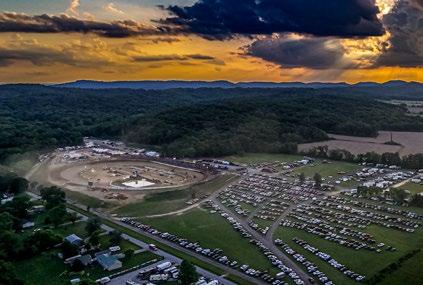
KEY EVENT IN HISTORY
Terry McCarl waving to Donny Schatz on the last lap of a World of Outlaws race.
WORDS: JOSH MULL
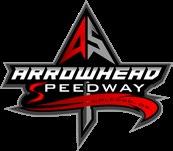
Located just outside of Colcord, Oklahoma, Arrowhead Speedway is one of the newest and most talked-about additions to the short-track racing scene in the Midwest. Opened in 2023, the track has quickly gained a reputation for its modern facilities, competitive racing and welcoming atmosphere.
Built with fans and drivers in mind, Arrowhead features a one-third-mile, high-banked clay oval that produces tight racing and plenty of action. It’s already making waves as a regional favorite, drawing fans
and competitors from across Oklahoma, Arkansas and Missouri.
Arrowhead Speedway hosts a variety of dirt-racing divisions, including Modifieds, Factory Stocks, Tuners and B-Mods. The track’s fresh clay surface and wide racing grooves create ideal conditions for side-by-side battles, making every race a spectacle.
Despite being new, Arrowhead has already secured events from major series like the USRA and ASCS Sprint Cars, helping it build prestige quickly. With plans to grow its weekly racing program and special events calendar, it’s clear that Arrowhead is positioning itself as a major hub for dirt racing in the region.
Racing at Arrowhead typically takes place on Friday nights during the season. For those unable to attend in person, select events are streamed live on RaceON.com, offering fans a way to follow the action remotely.
For tickets, full event schedules and facility information, visit arrowheadspeedway.com.
NICKNAME
Oklahoma’s Newest Racing Tradition
TRACK OPENED 2023
TRACK TYPE
High-banked oval TRACK LENGTH
One-third mile
TRACK SURFACE
Clay SEATING CAPACITY
3,000
FEATURED DIVISIONS
Modifieds, B-Mods, Factory Stocks, Tuners and touring series such as ASCS and USRA.

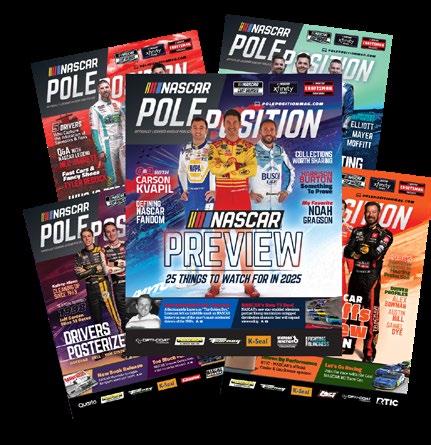
WORDS: ARMANY DEPAUL
When you hear someone talking about their local short track, a small paved or dirt oval comes to mind. However, not all short tracks are your typical oval, and not all tracks run traditional cars. Let’s introduce you to Pat’s Acres Racing Complex (PARC), a road course based in Clackamas County, Oregon, that is hailed as Oregon’s premier karting facility.
PARC’s origins date back to the 1940s, when Pat Sabin used 43 acres to build a retreat facility for his employees at Blue Bell Potato Chips. In 1965, Harry Heger purchased the property with the idea of creating a karting venue, which was realized two years later, when Pat’s Acres was built. In 1981, a local farmer named Ken Schipporeit purchased the facility and leased it out.
PARC stayed with Schipporeit for 15 years. In 1998, the Egger family bought the facility and began
transforming it into the track we see today, changing the name to Pat’s Acres Racing Complex. With multiple upgrades and renovations, it quickly turned into one of the premier road course short tracks of the United States. Legends like Michael Andretti, Paul Tracy, and Scott Speed all have turned laps at PARC.
PARC hosts some of the biggest karting events in the U.S, including Rental Kart League Nights. Running seasonally from March to October, the facility even provides karts. The West Coast National Kart Racing Series’ Challenge of the Americas also makes annual appearances on the calendar. PARC hosts its own series, the Oregon State Karting Championship Series.
In 1995, PARC set a new standard when it hosted the IKF Grand Nationals. 637 entries were made, a feat yet to be replicated by an IKF event. From 1999 to 2004, the SKUSA ProTour made PARC its only regular stop on the calendar. It was the first ever North American true ProTour ever launched, turning PARC into a mainstay. In 2007, PARC hosted AMA sanctioned SuperMoto events. Its exhibition events brought a lot of eyeballs and some of the biggest names in Formula Drift, such as Ryan Tuerck, Chelsea DeNofa, Chris Forsberg, and Adam LZ.
NICKNAME PARC TRACK OPENED 1967 TRACK TYPE Road course TRACK LENGTH .5 mile, .6 mile, and .7 mile configurations. SEATING CAPACITY
5,500 LEGENDS OF THE TRACK
Michael Andretti, Paul Tracy, Scott Pruett, Scott Speed, Graham Rahal, Josh Pierson, James Hinchcliffe and Timo Glock.

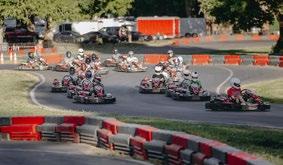
& 29th September 27th
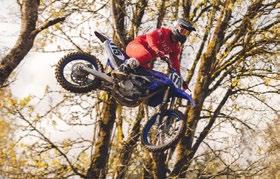
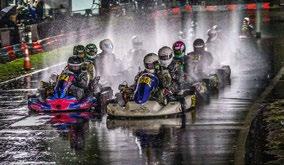
WORDS: CODY WILLIAMS PHOTOGRAPHY: WILLAMETTE SPEEDWAY

Nestled in the wilderness of Lebanon, Oregon, sits Willamette Speedway. Pronounced “Willam-ette,” the one-third-mile, high-banked clay oval is dubbed the “Fastest 1/3 Mile Dirt Track on the West Coast” for good reason.
In 2022, Justin Sanders set a track record of 11.214 seconds. But Willamette isn’t just about speed – it’s about creating a fun, memorable experience for fans.
Over the years, the track has hosted some of the best dirt racers in the world. Among the many names etched in the record books are NASCAR stars Kyle Larson, Kasey Kahne and Ken Schrader – each of whom raced and won at Willamette.
Founded in 1966 by Navy veteran and racing enthusiast Clair Arnold, Willamette quickly earned its place in Oregon motorsports history. Arnold passed away in 2009 and the track was sold in 2012 to brothers Jerry and Jimmy Schram.
Though no longer holding an ownership stake, Clair and Evelyn Arnold’s son, Bill Arnold, still works with the track. His duties include maintaining and preparing the racing surface for each weekend’s events.
Current promoter Cory Penfold describes Arnold as, “A master with the water truck.
“I’d put a Bill Arnold prepped track up against anyone in the nation,” said Penfold. “You’ll be hard pressed to find anyone to give drivers a smoother surface with multiple racing grooves. He truly is one of, if not the best in the country at putting a track together. There’s a reason I’ve dubbed him - ‘The Dirt Doctor.’”
The Schrams reconfigured the racing surface to increase the banking, installed electronic scoring, added 25 VIP boxes and built new concession and restroom structures under the bleachers.
In 2022, ownership passed to Cory Penfold and his wife Sandy, who brought back the dirt Late Model division and founded the I-5 Late Model Series, which now runs six of its 12 races at Willamette each year.

One of the track’s most unique chapters involves the Highwallers, a prison-based race team from the Oregon State Penitentiary. The team built and raced cars out of the prison from the early years until 2010. The program was a resounding success – 95 percent of participants never returned to prison after release.
Willamette Speedway has welcomed a wide variety of racing series, from the IMCA and NARC Series to the Northwest Midgets and Wingless Sprints.
Many local and regional legends have made their mark, as record holders include John Duty (Super Late Models), Bob Boyd (Late Models with sideboards), Brian Smith (Super Sports), Bricen James (Street Stocks), Travis Koch (Hornets) and Bailey Hibbard (Limited Sprints).
Drivers like Bricen James, Joey Tanner, Dakota Godard, Collen Winebarger and Darren Coffell remain fan favorites while Kaman Shafer, Justin Lemon and Wes Roles are among the rising stars.
For Penfold, managing Willamette is about putting on a show. One of his signature moves is the “field inversion,” where the fastest qualifier starts at the back and the slowest starts up front.
This gives underfunded teams a shot at leading laps while making the veterans work through the field.
“It keeps the racing exciting and the fans engaged,” Penfold said. Drivers starting in the back two rows are known as “Dash Drivers,” and if they win the feature, they earn a $300 bonus on top of first-place prize money.
Willamette also delivers a nostalgic experience with an old-school grandstand atmosphere and a family-friendly vibe. Fans rave about the food, especially the pulled pork and chicken with rice – an original recipe created by Penfold’s wife and inspired by the couple’s trips to Hawaii.
“It’s sweet, smoky and served hot – just like the action on the track,” said Penfold.
LOCATION
Lebanon, Oregon
NICKNAME
Fastest OneThird-Mile Dirt Track on the West Coast
TRACK OPENED 1966
TRACK TYPE
Banked oval
TRACK LENGTH
One-third mile
TRACK SURFACE
Clay
SEATING CAPACITY
5,000
FEATURED DIVISIONS
NARC Sprint Car Series, Wingless Sprint Series, Northwest Focus Midgets; I-5 Late Model Series and Northwest Dwarf Car Association.
LEGENDS OF THE TRACK
Don Wilson, Mark Howard, Russ Sell, Bob Jeffery; Trevor Glaser, George Waters, Dave McCombs, Bob Boyd and Darren Coffell.
KEY EVENT IN HISTORY
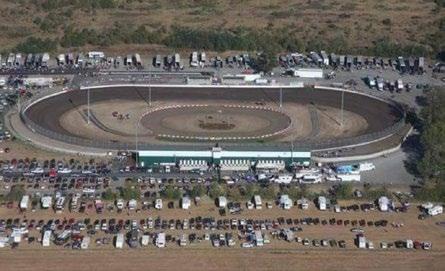
Some of NASCAR’s greats have won at the track, including Kyle Larson, Kasey Kahne and Ken Schrader.
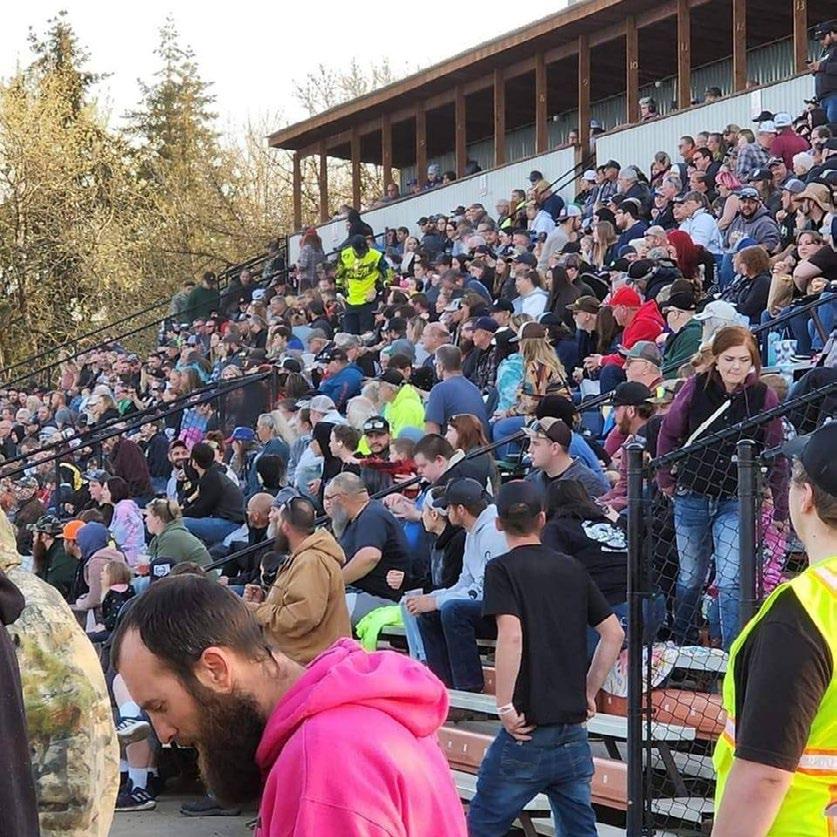



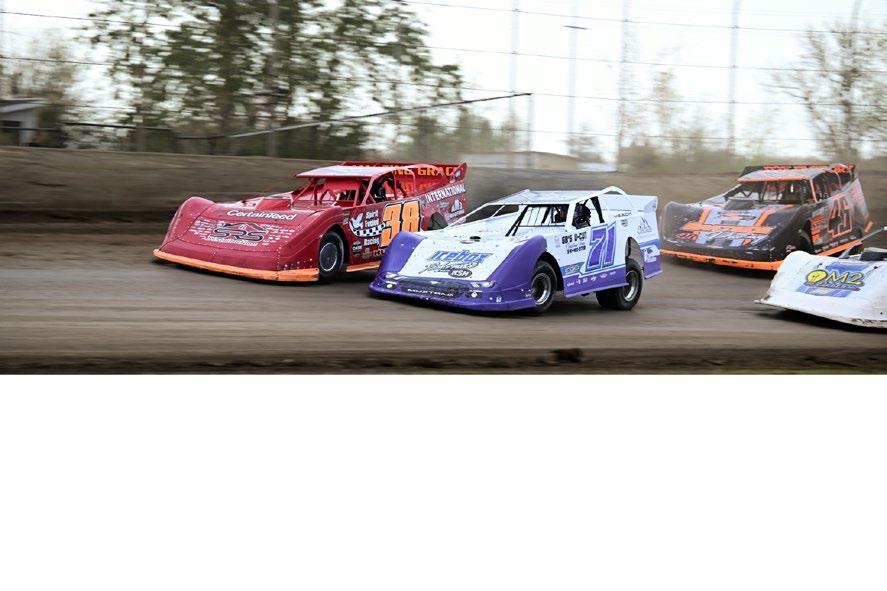


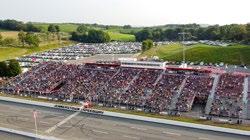
During the 1920s, just outside of Pittsburgh in western Pennsylvania, one of the oldest shorttrack racing facilities in the United States came to life.
Originally called Jenners Fairgrounds, Jennerstown Speedway began as a flat, half-mile dirt oval known for hosting “Big Car” racing. Around 30 years after its opening, a smaller dirt track was built in the infield, ushering in the era of stock car racing and leaving the original halfmile layout dormant.
That changed in 1967 when local business leaders took ownership and revived the nowhistoric facility. The half-mile configuration returned to prominence, hosting Winged Sprint Cars and dirt Late Models.
In 2004, the speedway’s current layout was established with the installation of a polymerbased asphalt surface – ushering in a new era of high-speed, short-track competition.
This season, Jennerstown Speedway’s schedule is once again loaded with events that earn points for the NASCAR Advance Auto Parts Weekly Racing Series. The track runs every weekend from April through mid-September, with racing under the lights starting at 6:30 p.m. – an intentional move to accommodate families and younger fans who want to enjoy the full show.
With a planned runtime of three- to threeand-a-half-hours, fans have ample time after the

races to head to the pits, meet drivers and see the cars up close.
Jennerstown Speedway’s commitment to the fan experience is evident in the facility upgrades as well. The track has spared no expense, installing MUSCO Sports Lighting – the same lighting technology used in MLB, NFL and major NASCAR venues – along with a surround-sound PA system, a state-of-the-art O.E.S. video scoreboard and a VIP booth that overlooks the track from atop the grandstands.
In addition to its slate of NASCAR racing, Jennerstown annually hosts a variety of touring series. Headlining this year’s special events is a May 10 visit by the nomadic ISMA/MSS Supermodified Series in which the nation’s premier Supermodified drivers will battle in a 50-lap feature.
Off the track, the concessions at Jennerstown offer more than the usual fare. While fans can still grab a hot dog or burger, the track’s food options go far beyond the basics. Jennerstown serves meatball hoagies, fried chicken with mashed potatoes, pork chops and even full meals with sides like corn and coleslaw.
For those looking for a hearty meal during the races, the track delivers. As locals like to say – if you leave hungry, it’s your own fault.
Community engagement is at the heart of what Jennerstown Speedway does. Each summer, the track hosts Kars for Kidz, a car show that raises funds for a local children’s home. The event regularly draws more than 800 entries and garners support from surrounding towns.
For Jennerstown Speedway, it’s more than just a car show – it’s a way to give back and make a lasting impact beyond the racing surface.
LOCATION
Jennerstown, Pennsylvania
NICKNAME
The Big J TRACK OPENED 1920s
TRACK TYPE
Flat oval
TRACK
LENGTH
.522 miles
TRACK
SURFACE
Polymerbased asphalt
SEATING CAPACITY
10,000 seat grandstands
FEATURED DIVISIONS
Late Models, Pro Stocks, Modifieds, Street Stocks, Chargers, Fast and Furious 4s and Northeast Crown Vics.
LEGENDS OF THE TRACK
Lou Blaney, Milt Miller, Boby Marhefka, Turk Burkett, Jim Nave and Gary Martz.
KEY EVENT IN HISTORY

In 1967, local business leaders took ownership and revived the facility’s halfmile dirt oval.
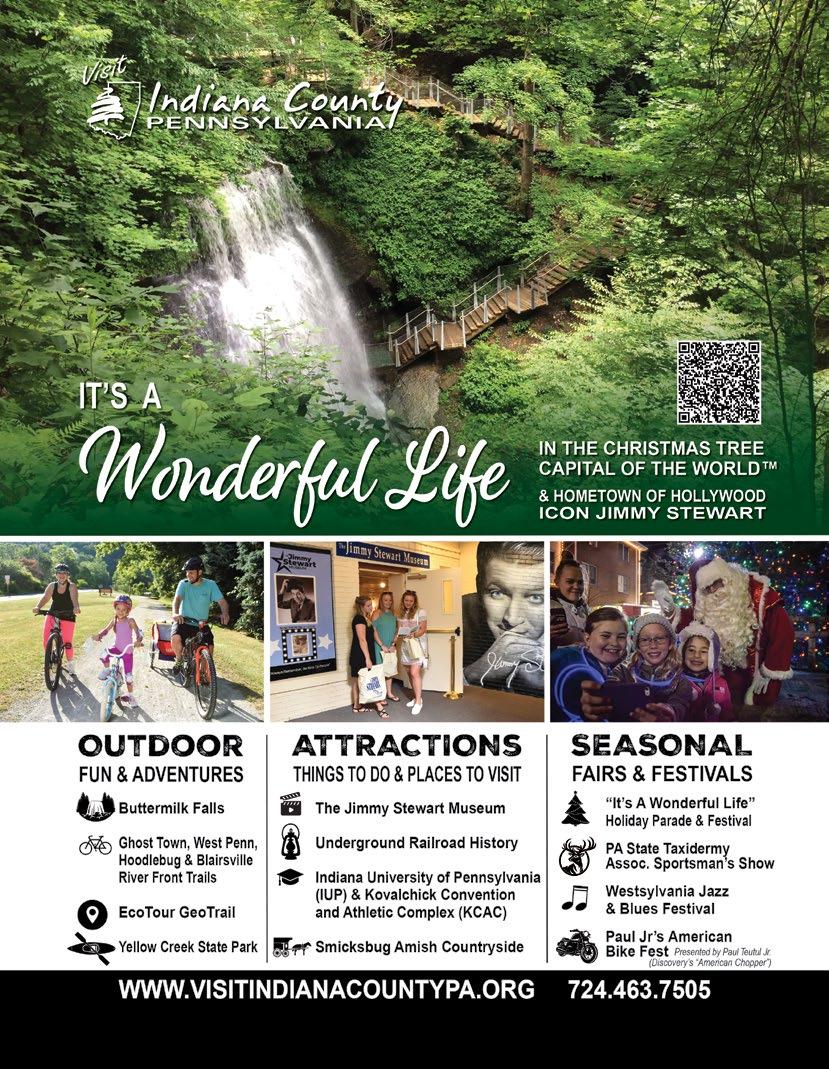

Nestled in the heart of central Pennsylvania, Port Royal Speedway is a dirt-racing paradise that has captivated fans for generations. Known for its highspeed action, competitive fields and passionate fan base, this half-mile oval has built a legacy as one of the nation’s premier Sprint Car tracks.
With a history dating back more than eight decades, Port Royal Speedway is much more than a must-visit racing facility – it’s a community, a tradition and a proving ground for talented drivers.
Port Royal Speedway first opened in 1938 and the half-mile clay oval is renowned for its lightning-fast
racing and side-by-side battles.
Sprint Cars are the headline division, with the track playing host to weekly 410 Sprint Car and Late Model action, along with various special events throughout the season.
Nicknamed “The Speed Palace,” Port Royal has produced many unforgettable moments, from photo finishes to record-breaking performances. Its reputation has made it a centerpiece of Pennsylvania’s dirt-racing scene.
There’s nothing quite like the thrill of a live race at Port Royal Speedway. Whether you’re soaking in the atmosphere from the grandstands or watching from the infield, every lap brings non-stop action.
For those who can’t make it in person, races are streamed live on FloRacing, bringing the excitement directly to your screen. Those planning a visit will find schedule information, ticket details and event updates at portroyalspeedway.com.
No matter how fans view the action, Port Royal Speedway promises edge-of-your-seat racing that will keep them coming back.




NICKNAME
The Speed Palace
6,000
FEATURED DIVISIONS
410 Sprint Cars, Late Models, 305 Sprint Cars, Super Late Models, Pro Stocks and more.
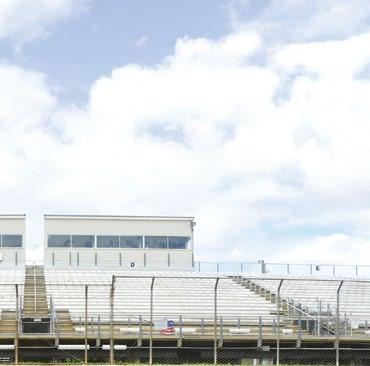


Tucked into the heart of the Pee Dee region, Florence Speedway is a South Carolina short track with deep roots and plenty of bite.
Since opening in 1979, this four-tenths-mile dirt oval has been a proving ground for both local racers and regional stars. Known for its red clay surface and tight, competitive racing, Florence Speedway is where generations of drivers have gone wheel-to-wheel under the lights. For fans, it’s a place where the smell of high-octane fuel and the roar of racing engines create a Saturday night tradition that’s hard to beat.
Located in Timmonsville, South Carolina, Florence Speedway strikes the perfect balance of history and horsepower. Its semi-banked layout produces side-by-side racing that keeps fans leaning forward
all night. Weekly divisions like Late Models, Street Stocks and Modifieds deliver fierce competition, while traveling series such as the Ultimate Super Late Models regularly bring national talent to town.
The track’s signature event, the USA 100, remains a highlight on the Southeastern dirt racing calendar, drawing some of the sport’s best. With seating for 4,000 fans, the grandstands are always packed when the big shows roll in – proof that Florence Speedway remains a must-visit stop in the dirt-racing world.
See the Action Live or
Race nights at Florence Speedway offer nonstop excitement from early spring through fall. The full schedule, event details and ticket information can be found at FlorenceMotorSpeedway.com. Fans who can’t make it in person can catch select events streamed live at RaceXR.com, bringing the Carolina clay action to living rooms everywhere.
Whether you’re a local or just passing through, Florence Speedway delivers a gritty, old-school dirt racing experience that keeps the Pee Dee region’s racing tradition alive and thriving.

NICKNAME
The Pee Dee’s Premier Dirt Track TRACK OPENED 1979
TRACK TYPE
Semi-banked oval
TRACK LENGTH
Four-tenths mile
TRACK SURFACE Red clay
SEATING CAPACITY
4,000
FEATURED DIVISIONS
Late Models, Crate Late Models, Street Stocks, Modifieds and Super Sports.
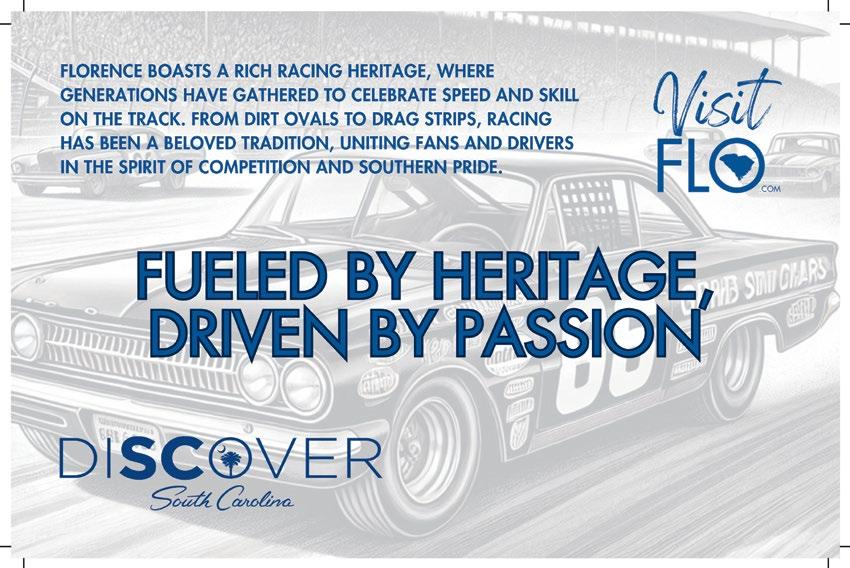

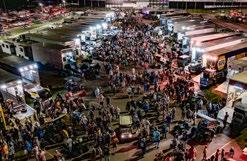
Huset’s Speedway, a three-eighths-mile dirt track located in Brandon, South Dakota, has been a staple of short-track racing since its opening in 1954. Originally carved into a hillside, the track – formerly known as Badlands Motor Speedway – is now a destination facility for major Sprint Car and Late Model events.
The speedway’s weekly schedule features 410 Sprint Cars, RaceSaver 305 Sprint Cars and Late Model Street Stocks, and the versatile motorsports venue has also hosted monster trucks, tractor pulls and concert events.
The track was founded by farmer and businessman Til Huset, who hosted its first race in 1954. However, that same year, another track near Sioux Falls opened with lights for night racing, quickly surpassing Huset’s in popularity. As a result, Huset’s shut down for two years.
Determined to revive the track, a group of racers, led by Fred Buckmiller, Clarence Rubin and Bill Leesch, sold bonds to purchase the Huset’s facility. Their vision was to bring racing back and make the track a premier destination. By August 1958, racing returned, and within a year, Huset’s was the area’s dominant track.
From 1959 to 1987, the Sioux Falls Stock Car Association owned and operated the facility, further cementing its legacy.

Huset’s Speedway is often compared to Bristol Motor Speedway due to its bowl-shaped design. Built into a hillside, the track offers an intense, upclose experience for fans and drivers alike.
“You feel like you are kind of sitting on top of the cars when you’re at the track,” said track general manager Doug Johnson. “It’s a small quarter-mile with concrete walls all the way around it. I’ve heard the description where it’s kind of like putting fighter jets inside of a hockey rink.”
The high-banked oval and unforgiving concrete walls have challenged even the best drivers over the years. The infield pits allow fans to watch crews make real-time adjustments, further enhancing the spectator experience. With seating for 9,000, 17 VIP suites and two two-level suite complexes at Turns 1 and 4, Huset’s delivers an electric atmosphere on race nights.
LOCATION
Brandon, South Dakota
TRACK OPENED
1954
TRACK TYPE
Oval TRACK LENGTH
Threeeighths mile TRACK SURFACE Dirt
SEATING CAPACITY
Huset’s Speedway is constantly evolving, with several upgrades on the horizon. Planned improvements include expanded camping areas, renovations to the back pit area and the construction of an additional suite tower.
“The demand for our suites is tremendous year after year, and we have a waiting list right now,” said Johnson. “So that’s probably the next big improvement.”
The track owner has also acquired land on the west side of the property, across the highway, which presents challenges for parking and camping. However, creative solutions are in the works to enhance both profitability and the fan experience.
Go-karting has seen a rise in popularity in the region, making it a potential addition to the facility. However, camping remains one of the top priorities for improvement.
“We sell out of camping for all of our big events. Demand for camping is huge, both here and at Jackson,” said Johnson. “People want to come to the big events. They want to stay here. They don’t want to have to travel. Just being on the property is huge for race fans.”
9,000 FEATURED DIVISIONS
410 Sprint Cars, RaceSaver 305 Sprint Cars and Late Model Street Stocks.
LEGENDS OF THE TRACK Terry McCarl, Marty Barber and Mark Dobmeier. KEY EVENT IN HISTORY The reopening of the track in 1958.
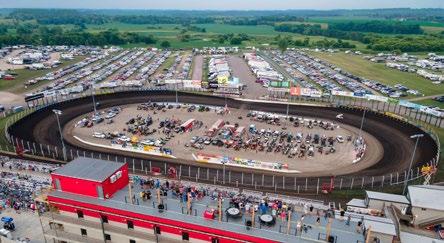
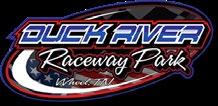
Located in the plains of middle Tennessee near metropolitan Nashville, Duck River Raceway Park is a short, aggressively banked dirt oval. Named after a river that runs nearby, the track hosts a variety of racing divisions, from Late Models to Street Stocks.
The track is a local favorite that attracts thousands of fans to its weekly races. Known for its high speeds and family-friendly atmosphere, Duck River Raceway Park offers an unforgettable experience for race fans of all ages.
Founded in 1973, Duck River Raceway Park was originally built as a practice track. At the time, the primary speedway in the area was the now-defunct Smyrna Speedway. The Duck River oval was established by Sam Pugh, who remained a loyal volunteer and supporter of the facility even after selling it. He continued to drive the water truck and assist with maintenance until his passing in 2018.
Located in Wheel, Tennessee, Duck River quickly transitioned from a practice venue to a full-fledged racing facility after Smyrna Speedway closed. For more than 50 years, the track has been a staple of the local racing scene.
The quarter-mile track features steep banking at 21 degrees, resulting in high-speed racing with average lap times ranging from 12.6 to 12.9 seconds. Track legend Scott Cook holds the lap record at a blistering 11.432 seconds.
Today, the track is managed by Russell and Angie Boothe. Russell, being a racer himself, is a former two-time track champion in the Factory Stock Division. But his passion for racing goes far beyond what he did behind the wheel. Russell Boothe takes pride in his track, often working up into the night making sure the track surface is
adequately prepared for the following night’s races and is largely responsible for the track’s upkeep and renovations.
Over the years, Duck River Raceway Park has hosted a variety of local and touring series events. Its season runs from early March through early December, culminating annually with the Duck River Winterfest.
Several marquee events are run at the track, including the Sam Pugh Labor Day Weekend and the Deep Fried 75 Super Late Model Series race. Duck River is also home to the Schaeffer’s Oil Spring Nationals, a premier event that attracts top-tier dirt racers from across the region.
The Factory Stock division makes frequent visits, drawing some of the best dirt racers in Tennessee and beyond. While the atmosphere is family-friendly, the competitive nature of the track often leads to intense, action-packed racing.
At Duck River Raceway Park, the fan experience is at the heart of its success. Beyond the high-speed action and tight-corner racing, the track offers an array of amenities that make it perfect for a family outing.
One standout feature is the concession stand, which is known among locals for its smoked barbecue. All meats are smoked in-house with specialties including smoked bologna sandwiches.
For those with different tastes, the track also offers classic concessions such as pizza, chicken tenders and nachos. Fans with a sweet tooth can indulge in funnel cakes and deep-fried Oreos, generously dusted with powdered sugar.
Another highlight is the facility’s cleanliness. Track officials take pride in maintaining some of the cleanest restrooms of any sports venue in the Nashville area.
With a commitment to providing an outstanding experience both on and off the track, Duck River Raceway Park remains a must-visit destination.
LOCATION
Wheel, Tennessee
TRACK
OPENED
1973
TRACK TYPE
High-banked oval
TRACK
LENGTH
Quarter mile
TRACK SURFACE
Dirt
SEATING CAPACITY
4,000 FEATURED DIVISIONS
Super Late Models, 604 Late Models, 602 Late Models, and Pure Ponies.
LEGENDS OF THE TRACK Scott Cook and Sam Pugh.
KEY EVENT IN HISTORY
Celebrating 50 years of operation in 2023.












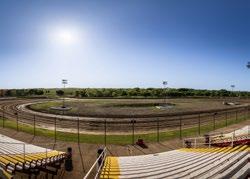
Just south of Dallas, near the town of Ennis, lies one of the Lone Star State’s most electrifying dirt tracks—BIG O Speedway. Known for its high banks, full-throttle action, and genuine hometown charm, this oval gem proudly wears the title “America’s Hometown Speedway.”
Now in its 40th season, BIG O Speedway has evolved from a regional favorite into a must-visit destination for dirt-racing fans across the country. Since its grand opening in 1985, the facility has grown into a multi-use motorsports complex featuring a lightning-fast five-sixteenths-mile clay oval, a one-sixth-mile banked go-kart track dubbed THE BULLRING, and a dedicated side-byside racing course.
In 2018, the track entered a bold new era under fresh ownership. With a full-scale renovation that included a new racing surface, upgraded electrical systems, a backstretch wall, modern concession stands, and all-new announcer and scoring booths complete with a digital scoreboard, BIG O emerged as a first-class facility without losing an ounce of its local soul.
BIG O Speedway delivers more than just
high-speed drama. It’s a full-blown weekend experience for fans of all ages. Kids 12 and under get in free, making it one of the most family-friendly venues in Texas motorsports.
And then there’s the food—real food. From 100% Angus beef burgers and quarter-pound all-beef hot dogs to Texas staples like Frito pie, sausage on a stick, chili cheese fries, and nachos, the concessions are a highlight of the night. The star of the show? The Turbo Inferno Burger—a fiery creation topped with jalapeños and pepper jack cheese, often enjoyed alongside beer-battered onion rings, fried pickle fries, or golden-cut homestyle fries.
BIG O Speedway isn’t just surviving—it’s thriving. With a long, robust racing calendar, it kicks off the season in late January with the “Warm Her Up” and closes the year with the fan-favorite “Leftover Nationals” after Thanksgiving. The track showcases a diverse lineup of weekly classes, including Eco Limited Modifieds, Crown Vics, Junior Limiteds, Factory Stocks, Late Models, and Limited Modifieds.
This year, the track adds a new level of excitement with the debut of its in-house series: BIG O Outlaw Sprint Cars. These wingless 410 monsters bring raw horsepower and $2,000-to-win stakes, promising edge-of-your-seat battles every time they hit the clay.
Racing takes the green flag every Saturday night at 7 p.m., with general admission just $20. Whether you’re a hardcore race fan or a roadtripper in search of authentic Texas thrills, BIG O Speedway is the kind of place that sticks with you long after the dust settles.
For full details, tickets, and the latest schedule, cruise over to www.bigospeedway.com.
Fast cars. Big flavor. Texas heart. That’s BIG O Speedway!
LOCATION
Ennis, Texas
NICKNAME America’s Hometown Speedway TRACK OPENED 1985 TRACK TYPE
High-banked oval TRACK LENGTH
Fivesixteenths mile TRACK SURFACE Clay SEATING CAPACITY
3,500 FEATURED DIVISIONS
Eco Limited Modifieds, Crown Vics, Factory Stocks, Junior Limiteds, Late Models and Limited Modifieds.
KEY EVENT IN HISTORY 2018 ownership change that led to facility modernization.

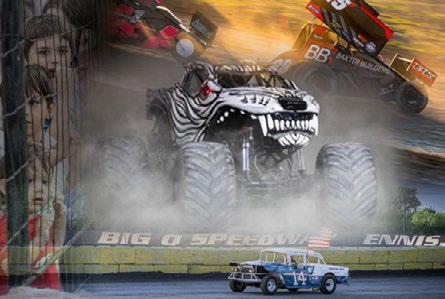


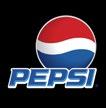



Adults also get in on the fun with the Beer Run. Beer cans are scattered across the track, and one lucky fan who finds the can marked with an “X” on the bottom wins $50 in cash.
New this season, Diamond Mountain Speedway has partnered with Sweetwater Speedway in Rock Springs, Wyoming, to launch the Sweet Diamond Series. It will bring together multiple divisions, including Modifieds, Northern Sport Modifieds and Sport Compacts.

Nestled in scenic Uintah County, Utah, Diamond Mountain Speedway is a dirt track like no other. Built in 2004, the one-third-mile, D-shaped oval is part of the Buckskin Hills Recreational Complex. Known for its smooth, yet slick surface, the track has a reputation for delivering intense competition with no easy victories.
The racing at Diamond Mountain Speedway is expected to be even better this season, thanks to a resurfacing project that was slated to be completed prior to the May 9 opener.
Located near Vernal, Utah, Diamond Moun tain Speedway sits at an elevation of approxi mately 6,200 feet, offering a unique race-day atmosphere. Fans and racers alike are met with unmatched excitement and stunning mountain views.
Spectators can enjoy the action from multiple vantage points. The grandstands provide a clas sic race-day experience, while trackside tailgat ing puts fans right next to the action. For those looking for a more panoramic view, the trackoverlook tailgating area offers a unique way to take in the competition.
Beyond the racing action, Diamond Mountain Speedway provides unique fan engagement activities during intermission. One of the high lights for children is the Candy Dash, where a trail of candy is placed across the track, and chil dren race to gather as much as they can carry.

The series will span two race weekends at each track, leading up to the championship finale on Sept. 19. That event will take place at Diamond Mountain Speedway, where the series champion will be crowned.
Since becoming the promoter of Diamond Mountain Speedway in 2022, Sarah Gray has made community awareness a major focus. Each race weekend is dedicated to supporting a different cause, such as Suicide Prevention, End Bullying, Autism Awareness, Salute Heroes and Cancer Awareness.
One of the most impactful events in 2024 was the N.O.V.A. Program End Bullying Night. The N.O.V.A. Program, which began in 2003, educates students on the dangers of illegal drugs, violence and negative media exposure. It also emphasizes self-respect, anger management and maintaining a positive outlook.
The program runs for 13 to 15 weeks, and information is available at novaprinciples.com.
During last year’s N.O.V.A. event, students who
NICKNAME Utah’s Diamond Mountain TRACK OPENED 2004 TRACK TYPE
Semi-banked oval TRACK LENGTH
One-third mile TRACK SURFACE Clay SEATING CAPACITY 500 grandstands, overlook tailgating and track-level tailgating.
FEATURED DIVISIONS
IMCA Modifieds, IMCA Northern SportMods, IMCA Sport Compacts, IMCA Hobby Stocks, IMCA Mod Lites, Dwarf Cars and more.
LEGENDS OF THE TRACK
Mickey Stubbings (82 years old), the Yeager Boys – Braxton and Bryson.
KEY EVENT IN HISTORY
Introduction of the Sweet Diamond Series.
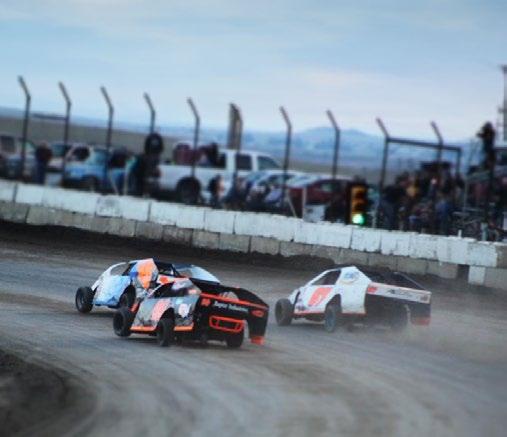

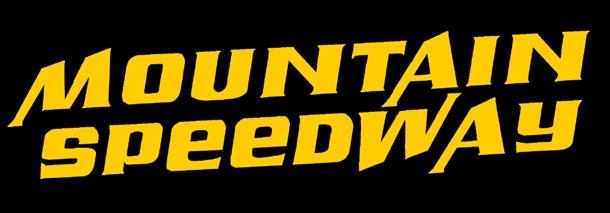
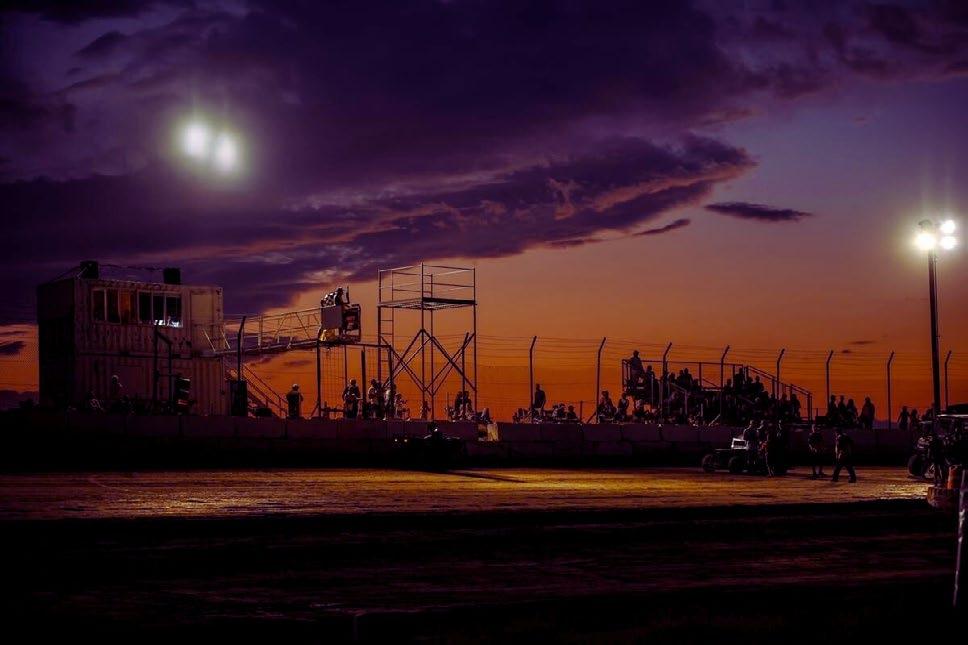
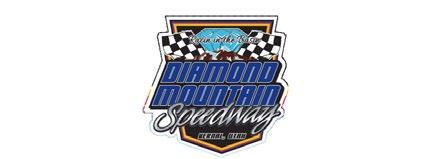












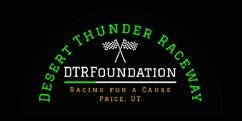
Price, Utah, has a longstanding tradition of auto racing. It began with a quarter-mile dirt oval at the Carbon County Fairgrounds, which quickly gave way to a larger half-mile oval across from the Carbon County Regional Airport. That track operated from 1981 to 1985.
After its closure, racers traveled as far as Moab and Hayden, Colorado. One local built a small oval on private land, but neighborhood complaints shut it down. At the urging of the County Commission, racers and fans formed the Central Utah Stock Car Racing Association to build a new track on the site of the old half-mile.
Desert Thunder Raceway was born in 1991.
It began as a community-owned venue and was sold to Chuck Buchannan in 1998, who expanded seating and added a concrete concession stand. In 2000, Harvey Howard took over, relocated pit road and dramatically increased the banking – earning the track the nickname “Fastest Track West of Denver.”
The track closed in 2018 but reopened in 2020 when racer Shane Weybright and his wife, Erin, bought it. Shane felt a calling to revive the venue.
“He didn’t go to a physical church,” Erin said. “He needed the gospel and fellowship without going to a physical church. … The drivers’ meetings are our place of worship.”
The Weybrights operate Desert Thunder on three values: character, family and respect, and racing has helped unite the community around those principles.
Local business owner Amanda Paiz said: “When Shane and Erin Weybright purchased

Desert Thunder Raceway in Price, Utah, in 2020, the future of racing in eastern Utah was uncertain. However, with their deep-rooted passion for the sport, they not only revitalized the track but also instilled a greater purpose – one that extends beyond racing.
“Committed to their community, Shane and Erin have transformed the dirt track into more than just a place for high-speed competition. Through the Desert Thunder Foundation Racing for a Cause, they have dedicated the last three years to raising awareness for suicide prevention, reducing the stigma surrounding substance use disorders and supporting various other important causes. Their efforts have made Desert Thunder Raceway a hub for both thrilling motorsports and meaningful community impact.”
Before buying the track, the Weybrights had only attended one race. But they saw the potential and longed for the fellowship it brought. Once the venue closed, they started exploring a purchase.
Today, the Desert Thunder Raceway is a moderately banked, three-eighths-mile clay true oval – slightly reconfigured but still fast.
Since taking over, the Weybrights have partnered with the local high school’s graphic design class for an annual logo contest. Winning designs appear on official merch, giving students professional experience and portfolio pieces.
The Fan experience is a priority. Grandstands seat up to 1,500 people, plus hilltop tailgating spots. Admission is affordable: Free for kids under 5 and active military, $7 for kids 6-12, $10 for seniors and $13 for adults.
The track is clean and well-run, with food vendors offering everything from street tacos to barbecue. They even sell slushies! Desert Thunder remains a place where racing and community meet.
LOCATION
Price, Utah
NICKNAME
Fastest Track West of Denver
TRACK OPENED 1991 TRACK TYPE Oval
TRACK LENGTH
Three-eighths mile
TRACK SURFACE Clay
SEATING CAPACITY
1,500 FEATURED DIVISIONS DTR Late Models and multiple IMCA divisions including Modifieds, Sport Mods, Stock Cars, Mod Lites, Hobby Stocks and Sport Compacts.
LEGENDS OF THE TRACK Hubert Wilson, Dave Madill and Mickey Stubbings.
KEY EVENT IN HISTORY Introduction of the Annual Clash.

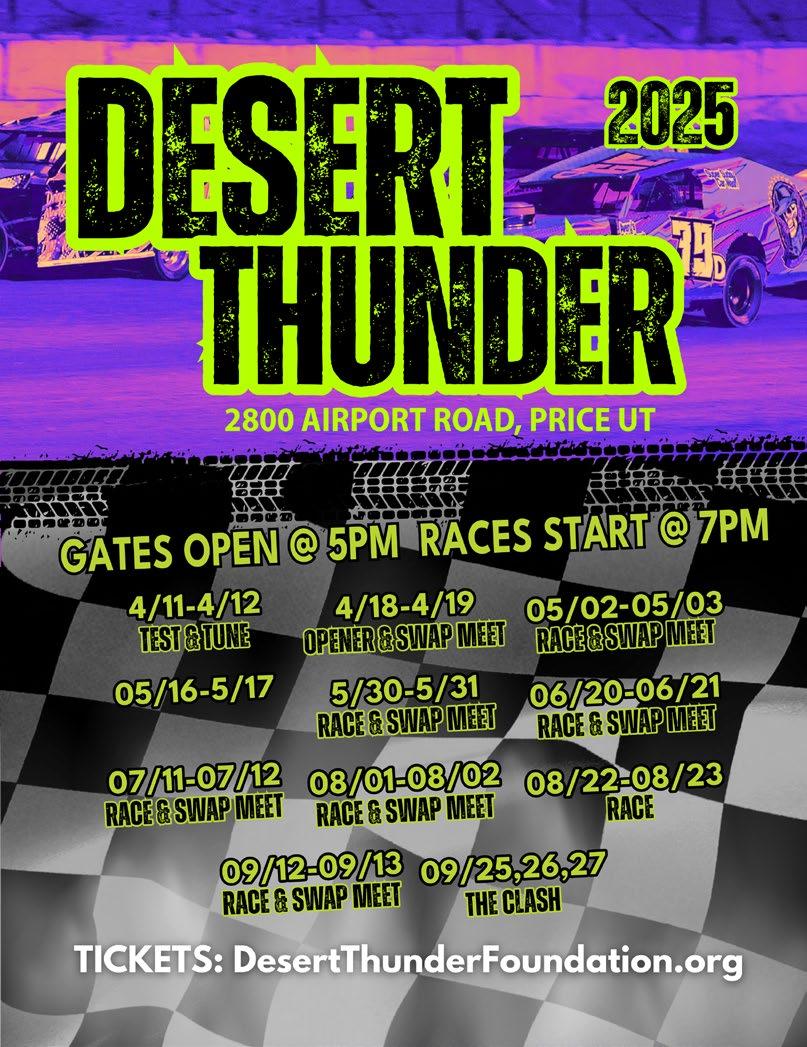
WORDS: RUSS EDENS
Tucked into the hills of Barre, Vermont, Thunder Road International Speedbowl is a staple of New England short-track racing. Nicknamed “The Nation’s Site of Excitement,” this iconic quarter-mile asphalt oval has thrilled fans since 1960.
With 18 degrees of banking and a rich tradition of local heroes and NASCAR legends, Thunder Road stands as one of the last active short tracks in Vermont. Its signature events and weekly action continue to define grassroots racing in the region.
Founded by legendary broadcaster Ken Squier, Thunder Road began as a dirt track before transitioning to asphalt. Through the decades, it faced ownership changes, legal battles and temporary closures but always returned stronger.
WORDS: JOSH MULL
Few tracks embody the heart and soul of shorttrack racing quite like South Boston Speedway. Located in South Boston, Virginia, the four-tenths-mile asphalt oval has been a proving ground for NASCAR legends and rising stars since 1957.
With a rich legacy of great racing and packed grandstands, “SoBo” is one of the nation’s iconic short tracks. From grassroots racers to future national champions, South Boston Speedway continues to produce elite talent while delivering unforgettable moments for fans.
Over the decades, the track has hosted everything from NASCAR’s top regional series to national touring events, solidifying its reputation as one of the most significant short tracks in American motorsports.
South Boston Speedway is home to a variety of racing divisions, including Late Model Stock Cars,
Notable racers like Richard Petty, Bobby Allison and Tony Stewart have turned laps here, while Vermont Governor Phil Scott is a multi-time track champion.
In 2017, the track’s legacy passed to former champion Cris Michaud and developer Pat Malone, ensuring its future.
This year, the track’s schedule runs from May 5 through Oct. 5 with a majority of the racing on Thursday nights. Among the numerous special events, central Vermont’s biggest fireworks display will light up the sky on July 3.
Thunder Road’s crown jewel is the Vermont Milk Bowl, a grueling season finale known as “The Toughest Short Track Stock Car Race in North America.” The event features three 50-lap segments with cumulative scoring and full-field inversions, testing even the best drivers.
At stake is not just victory, but the prestigious “King of the Road” title. Continuing tradition, the Milk Bowl champion earns a cup full of milk – and kisses a cow in Victory Lane.
Limited Sportsmen, Pure Stocks and Hornets. The track’s schedule features marquee events such as the Thunder Road Harley-Davidson 200, the South Boston 100 for the CARS Tour and the prestigious Danville Toyota 200.
As a former stop on what is now known as the NASCAR Xfinity Series, the speedway has challenged several legendary drivers who have gone on to national prominence.
Weekly racing programs keep the competition fierce, offering fans some of the best side-by-side action in short-track racing.
Fans can visit South Boston Speedway’s website (southbostonspeedway.com) for event schedules, ticket information and race-day details. Those unable to attend in person can watch select events live through FloRacing, the exclusive streaming partner for South Boston Speedway.
Additional coverage, including highlights and special features, can often be found on NASCAR Roots and track-affiliated social media pages.











WORDS: KAUY OSTLIEN PHOTOGRAPHY: SKAGIT SPEEDWAY

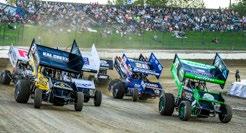
Organized by sanctioning bodies such as AAA, IMCA and later USAC, Sprint Car racing was born and raised on the short tracks of the Midwest. Eventually, this popular open-wheel racing division branched out and became the headline attraction at multiple marquee tracks in other regions of the country – especially up and down the West Coast.
Skagit Speedway was one of those West Coast tracks that embraced Sprint Car racing during its early years. And today, Skagit Speedway, a three-tenths-mile clay oval located in Burlington, Washington, is a premier dirt-racing venue that serves as a hub for Sprint Car racing in the Northwest.
While the Northwest is not necessarily known as a hotbed of auto racing, Skagit opened on Sept. 1, 1954, and has created a tight-knit community of supporters, some of whom have been attending races there since Dwight Eisenhower was president.
Of course, a race track with a high level of notoriety, like Skagit Speedway, has gone through several changes. This includes numerous renovations and technology upgrades during the early 2000s and, in recent years, the implementation of modern, at-track amenities such as MyRacePass and online ticketing.
Skagit Speedway is directly tied to the cultural lifeline of dirt racing in the Evergreen State, so it’s no surprise that the track played a role in the early development of multi-time

NASCAR Cup Series race winner and Enumclaw, Washington, native Kasey Kahne.
Nowadays, it’s common to hear some notable names from the current West Coast racing scene mixing it up on the clay with Skagit locals, such as Trey Starks.
Starks was the track’s 360 Sprint Car champion last season and is a consistent threat to win week in and week out.
Throughout the racing season, Skagit’s weekly schedule features fan-favorite divisions such as Modifieds, Hornets and Focus Midgets. But one type of race car still reigns supreme in Burlington, Washington – Sprint Cars.
Over the years, major series have brought Sprint Car racing’s best to town. This season, the Kubota High Limit Racing Series, which visited Skagit for the first time a year ago, will headline the dance card by sanctioning the Aug. 28-30 Skagit Nationals.
In addition to a national series event like the Nationals, Skagit annually hosts the Jim Raper Memorial Dirt Cup. It is one of the nation’s preeminent 410 Sprint Car events, attracting top racers from up and down West Coast and across the country. This year’s three-day event will take place June 19-21.
Like so many other well-established short tracks, Skagit Speedway is built on a foundation of legacy and community, making it a true jewel among West Coast short tracks.
For those looking to witness the excitement firsthand, Skagit Speedway’s website (skagitspeedway.com) provides full event schedules, ticket information and race details. Fans unable to attend in person can catch select races through streaming platforms, with live broadcast details updated online.
Also, make sure to check out the track’s various social media channels.
LOCATION
Burlington, Washington
TRACK
OPENED
Sept. 1, 1954
TRACK TYPE
Banked oval
TRACK LENGTH
Three-tenths mile
TRACK SURFACE
Clay SEATING CAPACITY
10,000 in the stands, 2,000 in the grass
FEATURED DIVISIONS
410 Sprint Cars, 360 Sprint Cars, Sportsman Sprint Cars, Outlaw Tuners, Modifieds and Focus Midgets.
LEGENDS OF THE TRACK
Jim Raper KEY EVENT IN HISTORY
The creation of the Jim Raper Memorial Dirt Cup in 1972. Ross Fontes won the inaugural event.
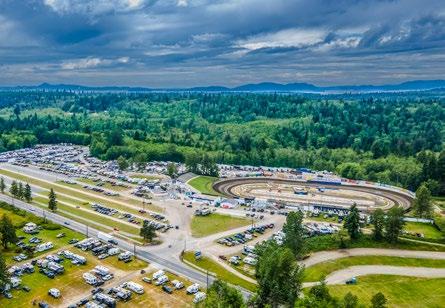

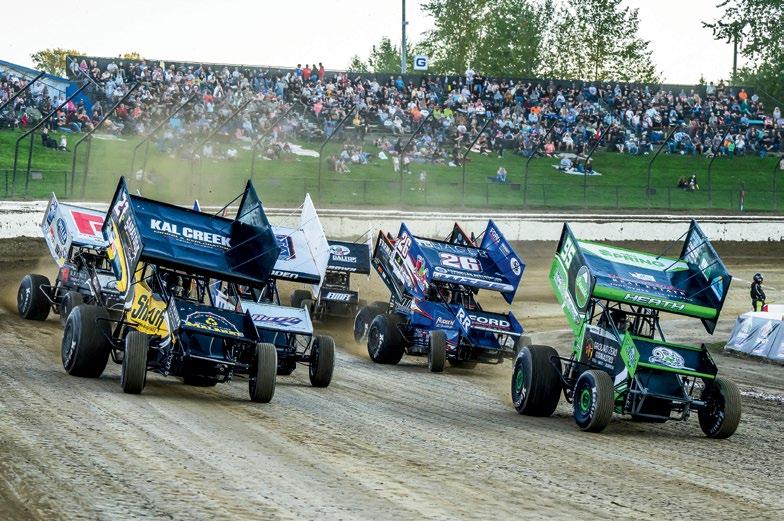

Explore, stay, and play in Skagit County’s “hub city” centrally located off I-5 and Hwy 20 on your adventures north to Canada, west to the Salish Sea, east into the Cascade Range, and south to Seattle.






Experiences!

WORDS: RUSS EDENS PHOTOGRAPHY: EVERGREEN SPEEDWAY

Evergreen Speedway stands as the only NASCAR-sanctioned short track in the state of Washington, and the facility has long served as a hub for the sanctioning body’s racing activities in the Northwest.
Located in Monroe, Washington, a fiveeighths-mile paved oval is the centerpiece of this multi-use motorsports complex that can accommodate 10,000 fans and plays host to a wide variety of racing series.
Adding to its unique appeal, the complex also features a shorter inner oval, a Figure-8 course and a quarter-mile dragstrip.
Evergreen Speedway is publicly owned by Snohomish County. In 1949, the county granted the Evergreen State Fair permission to use a portion of the land the track now occupies. By 1950, that land was approved for the construction of a horse racing track.
In 1954, Evergreen began hosting auto races. However, poor weather conditions led to financial struggles, and auto racing was temporarily removed from the schedule. After several years focused solely on equestrian events, the track was paved in 1963 and auto racing returned.
In 1966, the inner oval and the Figure-8 layout were also paved.
In 2011, Douglas Hobbs, owner of High Road Promotions LLC, secured a county contract to operate the speedway through 2036. This agreement ensures that NASCAR-sanctioned events will continue to have a presence in Washington for the foreseeable future.
Over the years, Evergreen Speedway has hosted an impressive lineup of racing series, including Formula Drift, ARCA Menards Series West, Global Rallycross, the NASCAR Northwest Series and the NASCAR Craftsman Truck

Series. Today, the track’s weekly racing features Late Models and several regional divisions.
Signature events include the Figure-8 Nationals, 60 Minutes of Fear, the Mark Galloway Shootout and the marquee Summer Showdown – a 200-lap Super Late Model race on the five-eighthsmile track.
“It’s one of the highest paying races on the West Coast for Late Models, if not the highest paying race,” said Benjamin Eyman, a track announcer at Evergreen Speedway. “Ty Dillon has run the Summer Showdown, along with a handful of other big names.”
The track layout offers a tough challenge, with drivers needing to approach Turns 1 and 2 much differently than Turns 3 and 4.
“There’s so much caked-up rubber near the wall. You can’t really run up there,” Eyman explained. “And 3 and 4 is so much more difficult than 1 and 2 because it’s the turn we pit in usually, so it’s getting worn significantly more. To win here – and win that big race – is not easy. It takes a lot of skill.”
With an operations contract and a continued NASCAR affiliation, Evergreen Speedway’s future looks strong. The track also serves as a development ground for young racers, offering events for drivers as young as 12 years old.
“The Youth Hornets are our most important class because those are building the racers of the next generation,” Eyman said. “Those races are building the kids that are going to grow up and drive Mini Stocks, Street Stocks, Outlaw Figure-8s and Late Models.”
Backed by strong leadership, passionate fans and a clear focus on the future, Evergreen Speedway is positioned for long-term success.
LOCATION
Monroe, Washington
NICKNAME
The Superspeedway of the West
TRACK OPENED 1954
TRACK TYPE
Oval
TRACK LENGTH
Five-eighths mile
TRACK SURFACE
Asphalt SEATING CAPACITY
10,000 FEATURED DIVISIONS Late Models and Formula Drift.
LEGENDS OF THE TRACK
The Zaretzke, Deitz and Cox families.
KEY EVENT IN HISTORY
When the fiveeighths-mile oval was paved in 1963.
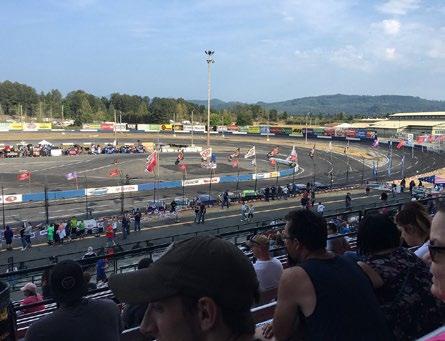
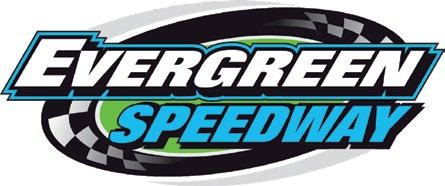
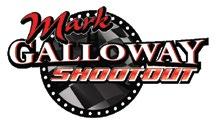
The 2025 running of the Mark Galloway shootout will be one of the best yet. The first test on the big 5/8 oval of the year is a crown jewel race in the northwest for pro late models.This year the race features Kevin and Keelan Harvick plus the Cars Tour West and Tri-State Challenge Series showcasing the best in Northwest Pro Late Models.
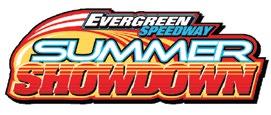
18-19th, 2025
The premier event for both pro and super late models is one of the highest paying events on the west coast. 200 laps around the tough 5/8 mile oval will test drivers of all skill levels. With the event featuring the Northwest Super Late Model Series meaning there will be stiff competition throughout the field.
Central Welding Supply 125
Granite Cup
The third major late model contest, this race is set on the 3/8 mile oval and also hosts driver reunion night.
The northwest and Canada’s fastest drivers take their sprint cars to the asphalt oval on this night of speed.
AUGUST 16th, 2025
AUGUST 2nd, 2025
Central Welding Supply 125
60 Minutes of FEAR
The third major late model contest, this race is set on the 3/8 mile oval and also hosts driver reunion night.
One of two major figure 8 events each year for all fans of the intersection, survival can be the key to victory.
OCTOBER 4th, 2025
AUGUST 16th, 2025
60 Minutes of FEAR
Granite Cup
One of two major figure 8 events each year for all fans of the intersection, survival can be the key to victory.
The northwest and Canada’s fastest drivers take their sprint cars to the asphalt oval on this night of speed.
AUGUST 2nd, 2025
OCTOBER 4th, 2025
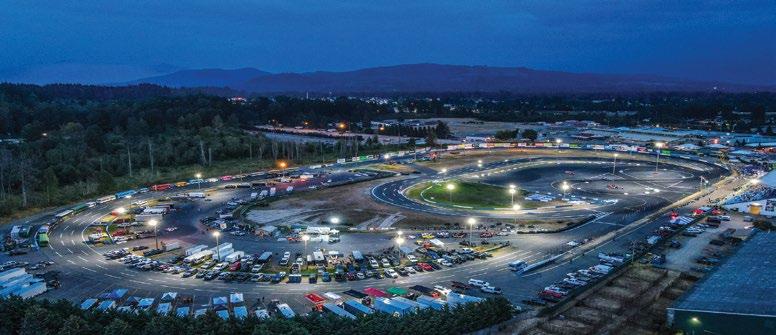
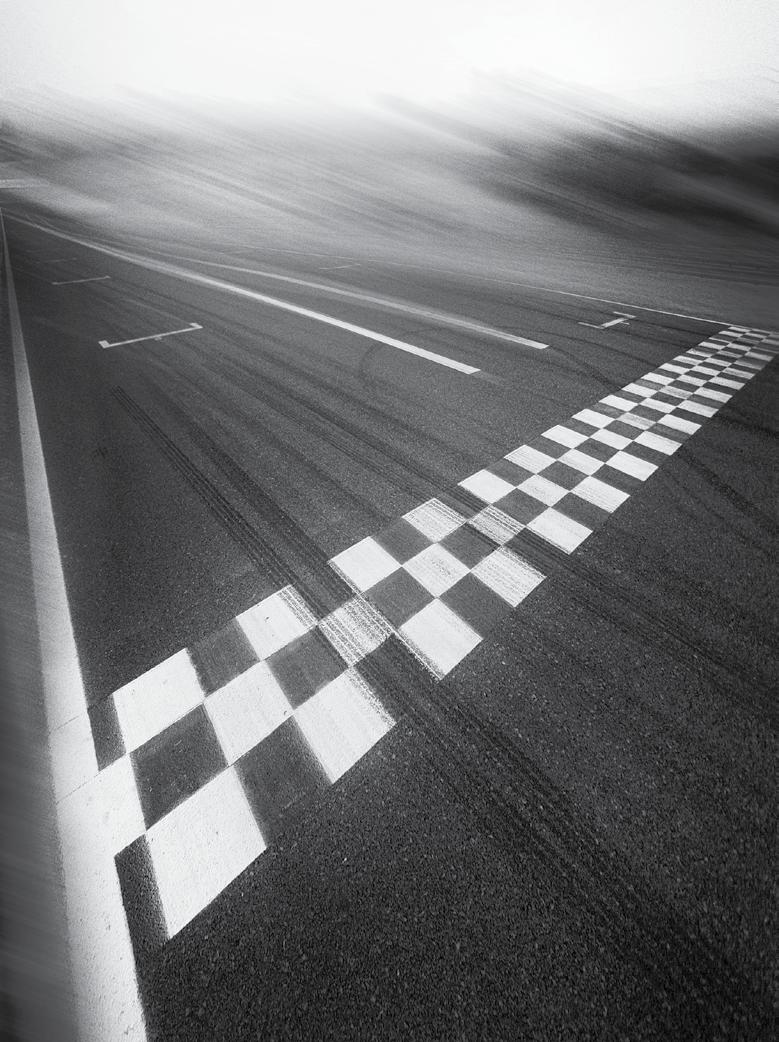
‘THE
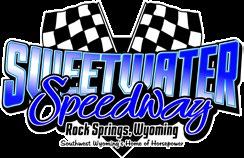
Sweetwater Speedway, a high-banked, threeeighths-mile dirt oval, is part of the Sweetwater Events Complex in Rock Springs, Wyoming.
Known as “Southwest Wyoming’s Home of Horsepower,” this high-banked dirt track has thrilled fans and challenged competitors since the 1970s. Located near the borders of Idaho, Utah and Colorado, Sweetwater Speedway is a bucket-list destination for race fans in the western United States.
The nation’s western states showcase a strong lineup of popular short tracks, and many racers single out Sweetwater Speedway as the “highest banked track west of the Mississippi.”
As race fans know, high banks generate high speeds. In recent years, Sweetwater Speedway has not only delivered lightning-fast racing but has also produced edge-of-your-seat action, captivating both seasoned fans and first-time spectators.
While the track no longer hosts weekly racing, fans and competitors still turn out for two action-packed nights of racing each month. On most nights, the schedule includes the IMCA Sport Compact, Sport Mod and Modified divisions.
The track also hosts a variety of special events throughout the racing season, featuring IMCA Stock Cars, Hobby Stocks, High Plains Dirt Car Late Models and ASCS Sprint Cars.
Like many tracks across the country, Sweetwater Speedway is a family affair for both competitors and spectators. Among the regular

racers are Justen Yeager and his sons, Bryson and Braxton, who are frequently heard over the PA system as they battle it out on the track.
Even though Sweetwater Speedway has become a fixture on the western United States dirt-track scene, it remains deeply rooted in the local community, which has an estimated population of 23,000.
A prime example is the presence of local food vendors at the speedway, giving small businesses an opportunity to showcase their offerings. Additionally, the track actively works to engage the community through giveaways and special events, including a drive-in movie night on a weekend when the oval is idle.
For more than a decade, a dedicated group of volunteers has helped operate the track. Track manager and promoter Kara Beech expressed her gratitude for their dedication.
“I’ve been really lucky that I have a good group of volunteers that love racing as much as I do and that love their community as much as I do,” she said. “I really want our track to be the place for people to go.”
This commitment to both racing and the community highlights Sweetwater’s understanding that short-track racing is just as much about the people as it is about the competition.
The track’s 2025 schedule boasts 12 dates between May 23 and Sept. 6. Highlights include the June 6-7 Sprint Car Spectacular, anchored by the Northern Plains Region of the American Sprint Car Series, and the Aug 29-30 Labor Day Sport Compact Special.
Complete schedule details are available at sweetwaterspeedway.com.
NICKNAME
Southwest Wyoming’s Home of Horsepower
TRACK OPENED 1970s
TRACK TYPE Oval
TRACK LENGTH
Three-eighths mile
TRACK SURFACE Dirt
SEATING CAPACITY
2,500
FEATURED DIVISIONS
Late Models, Dwarf Cars, Hobby Stocks, Modifieds, Sport Compacts, Sport Mods, Sprint Cars and Stock Cars.
LEGENDS OF THE TRACK
Danny Concelman, Justen Yeager and Ricky Alvarado.
KEY EVENT IN HISTORY
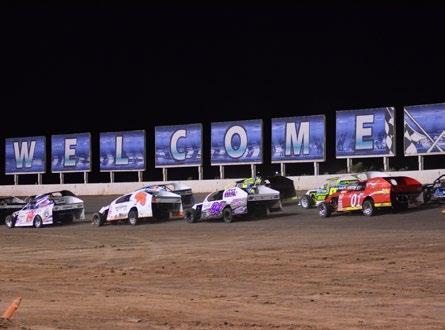
Sammy Swindell’s track-record lap in a Winged Sprint Car.

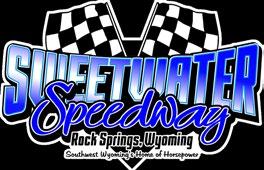
MAY 23 & 24
MODIFIED, SPORT MOD, SPORT COMPACT, DWARF CAR
JUNE 6 & 7
SPRINTS, MODIFIED, SPORT MOD, SPORT COMPACT, STOCK, HOBBY
JULY 4 & 5

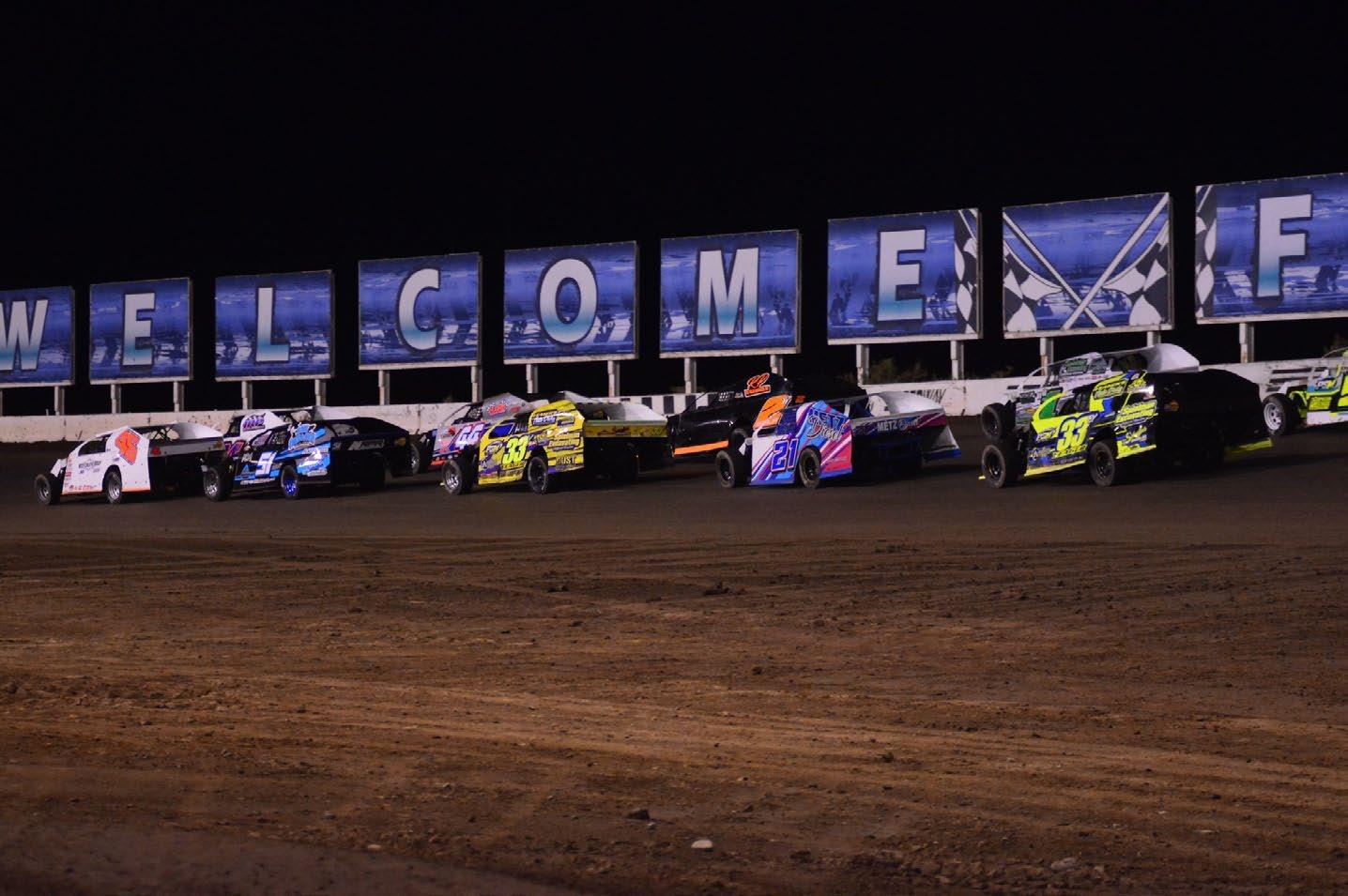

LATE MODELS, MODIFIED, SPORT MOD, SPORT COMPACT
AUGUST 15 & 16
MODIFIED, SPORT MOD, SPORT COMPACT, STOCK, HOBBY
AUGUST 29 & 30
MODIFIED, SPORT MOD, SPORT COMPACT
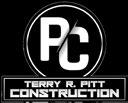










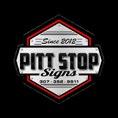
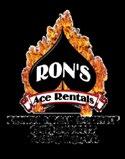




SPECIAL EVENTS INCLUDE THE PRESTIGIOUS HILLBILLY HUNDRED
WORDS: JOSH MULL
Deep in the rolling hills of Middlebourne, West Virginia, Tyler County Speedway stands as one of the region’s most exciting dirt tracks. Known as “The Bullring,” this high-banked, quarter-mile oval is a haven for dirt racing enthusiasts, delivering intense, door-to-door action week after week.
The track has built a reputation for producing some of the most thrilling short-track battles in the country, which attract racers and fans from across the Mid-Atlantic. With a rich racing history, passionate crowds and marquee events, Tyler County Speedway embodies the raw energy and excitement that define grassroots motorsports.
Tyler County Speedway offers an adrenalinefilled lineup of racing divisions, including Super
Tucked away in the heart of Wisconsin Dells, Wisconsin, Dell’s Raceway Park is a hidden gem in the short-track racing world. This paved third-mile oval has long been a proving ground for local and regional talent, offering thrilling side-by-side battles that keep fans on the edge of their seats.
The track’s commitment to high-quality competition, family-friendly entertainment and top-tier events has made it a staple of Wisconsin’s racing culture. Whether you’re a die-hard race fan or a casual spectator, Dell’s Raceway Park delivers an electrifying atmosphere that captures the essence of grassroots motorsports.
Since its opening in 1963, the track has seen countless legendary battles and continues to evolve as a premier Midwest racing destination.
Dell’s Raceway Park is home to a diverse lineup of

Late Models, UMP Modifieds, EDGE Hot Mods, FASTRAK Late Models and Mini Wedges. The track’s season is highlighted by can’t-miss events like the Earl Hill Memorial, the Mega 100 and the Hillbilly Hundred, one of the most prestigious dirt late model races in the country. These races bring in top-tier drivers, making Tyler County Speedway a proving ground for rising local talent and seasoned veterans alike.
Weekly racing programs also provide highintensity competition, ensuring fans experience unforgettable action every race night.
For those looking to witness the excitement firsthand, Tyler County Speedway’s website (tylercountyspeedwayonline.com) provides full event schedules, ticket information and race details. Fans unable to attend in person can catch select races through streaming platforms, with live broadcast details updated online.
Stay connected via Facebook, Twitter (X), Instagram, and YouTube for race updates, highlights and exclusive content from the track.

NICKNAME
The Bullring TRACK OPENED 1974
TRACK TYPE
High-banked oval
TRACK LENGTH
Quarter mile
TRACK SURFACE
Clay SEATING CAPACITY
5,000 FEATURED DIVISIONS
Super Late Models, UMP Modifieds, EDGE Hot Mods, FASTRAK Late Models, Mini Wedges and more.
racing divisions, showcasing everything from Super Late Models and Midwest Trucks to Sportsmen and Hobby Stocks. The track’s schedule is packed with high-profile events, including the Icebreaker 100, Alive for 5 Super Late Model Series and the prestigious Falloween 150.
These races draw top talent from across the Midwest, making Dell’s Raceway Park a must-visit destination for short-track enthusiasts. The facility also hosts weekly racing, giving rising stars a platform to showcase their skills in front of passionate fans.
For those looking to experience the excitement, Dell’s Raceway Park’s website (dellsracewaypark. com) provides full event schedules, ticket information and race-day details. Fans unable to attend in person can catch the action via online streaming, with broadcast information available on the track’s website. Stay connected through social media on Facebook, Twitter (X), Instagram and YouTube for race updates, highlights and behind-the-scenes content.

NICKNAME Wisconsin’s Showcase Short Track
TRACK OPENED 1963
TRACK TYPE
Oval
TRACK LENGTH
One-third mile
TRACK SURFACE
Asphalt
SEATING CAPACITY
5,000 FEATURED DIVISIONS
Super Late Models, Midwest Trucks, Sportsmen, Hobby Stocks, Bandoleros and more.